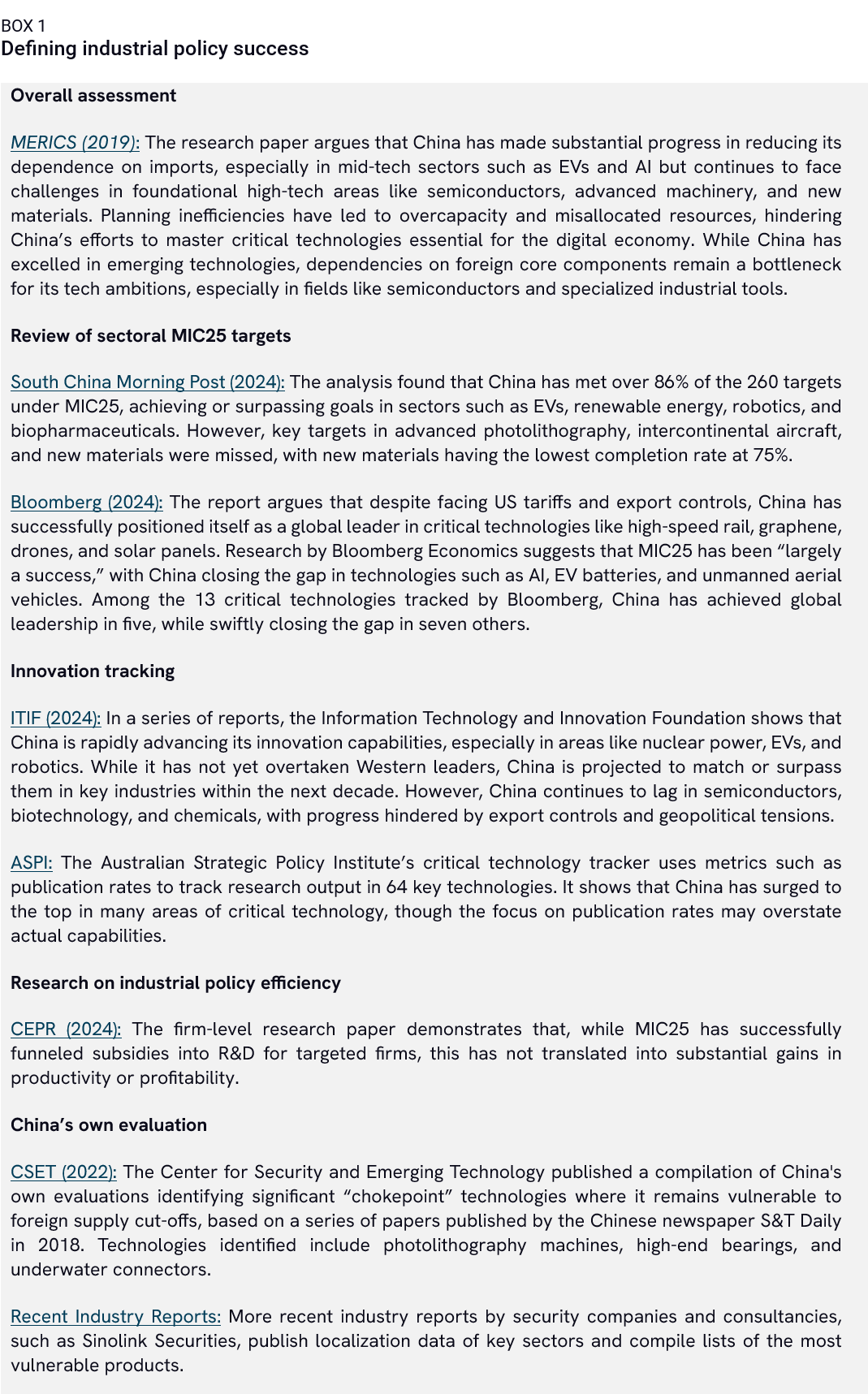Was Made in China 2025 Successful?
To answer whether MIC25 was successful, we measure outcomes across four of the plan's main categories: China’s import dependency, dependency on foreign companies, global competitiveness, and technological leadership.
A message from the US Chamber of Commerce
The US Chamber of Commerce is pleased to present this independent report, prepared by Rhodium Group, assessing China’s Made in China 2025 (MIC25) policy. This comprehensive analysis highlights the policy’s implications for global manufacturing and innovation. It offers detailed insights into MIC25’s goals, strategies, and impacts, covering financial policies, market access, and national security reviews.
This report is an independent product of Rhodium Group. Its unbiased and rigorous analysis ensures the credibility and integrity of the paper. This objective assessment of MIC25 involved extensive research, including interviews and surveys with industry experts, policymakers, and other stakeholders.
The US Chamber is dedicated to providing accurate and reliable information to our members and policymakers. Our aim is to support informed decision-making and sound policy development. This report reflects the US Chamber’s commitment to transparency and excellence, empowering our members and policymakers with the knowledge needed to navigate global economic policies.
Executive summary
Made in China 2025 (MIC25) was unveiled in 2015 as a sweeping industrial policy to transform China into a global leader in advanced manufacturing by 2025. The policy aimed to reduce the country’s reliance on foreign technology, enhance domestic innovation, and build global competitiveness and competitors in strategic industries such as robotics, semiconductors, and new energy vehicles. Following international criticism—particularly from the Trump administration and other governments concerned about its market-distorting effects—the policy officially disappeared from public discourse in 2018. However, the core objectives of MIC25 have continued under alternative frameworks and initiatives to incentivize localization and provide state support to priority industries.
This report builds on the US Chamber of Commerce’s 2017 analysis of MIC25 to evaluate its performance and long-term impact. In the years following the policy’s launch, financial state support intensified, though often through indirect channels. Tax benefits aimed at innovation surged by an average annual rate of 28.8% between 2018 and 2022, and the proportion of companies enjoying additional deductions and tax reductions more than quadrupled between 2015 and 2023. State investment through government guidance funds increased more than five-fold between 2015 and 2020. Market barriers, particularly involving sales to Chinese government-linked entities and favored domestic competitors compelled foreign companies to localize production to continue to access the market. Though discriminatory practices had been rife before, interviews with market participants confirmed that 2015 was a turning point in many sectors, with such practices growing and becoming increasingly targeted at high-tech areas.
But did all of this support actually make MIC25 a success? To answer that question, this report measures outcomes across four main categories: China’s import dependency, dependency on foreign companies, global competitiveness, and technological leadership.
- Reducing import dependencies: China has largely succeeded in reducing its import dependencies by leveraging foreign firms. Beijing has pursued strategies such as requiring or pressuring foreign firms to localize high-tech production and research as a condition for continued access to the market —thereby reducing exports as local production grew—as well as acquiring foreign companies to enable large-scale technology transfers. This strategy has been successful in sectors like memory chips and some medical devices and equipment. Overall, import vulnerabilities are now more limited than ten years ago. However, they persist in a few key areas, where foreign firms have kept their most advanced technologies outside of China. In fact, China’s drive for industrial upgrades has, in some cases, even increased its demand for some highly specialized imported products.
- Dependencies on foreign firms: Newer Chinese firms gained market share at the expense of established foreign companies in all targeted sectors. Stringent restrictions on foreign participation and state support particularly boosted domestic industrial cloud services, new energy vehicles and components, and power generation equipment. Chinese firms also spearheaded new products where foreign firms were previously dominant, like LiDAR, automotive sensors, and high-speed rail brakes. However, China still remains highly dependent on foreign companies in many critical sectors, including biomedicine drugs, high-end machine tools and machinery, commercial aircraft, and cutting-edge semiconductors. Although the market share of domestic companies is poised to increase significantly in the years to come, the most bleeding-edge technologies will remain a challenge to localize.
- Competitiveness: Chinese companies are globally competitive on price in many low- and mid-tech sectors and they achieved global competitiveness in some high-tech sectors, including information and communication equipment, clean technologies, EVs and connected vehicles, agricultural equipment, ships, drones, and high-speed rail, among others. They saw their greatest technological advancement and market share growth when they had one or more of three factors: high capital intensity, a large (often state-supported) demand market, and emerging industries without an established global leader. In most MIC25 sectors, Chinese companies generally lag behind their foreign counterparts in global revenue, market share, and cutting-edge technologies. Even in some areas where firms have achieved significant self-sufficiency—like auto antennas and telematics—it has not yet translated into global competitiveness.
- Technological leadership: Chinese companies have made significant strides in closing the gap with foreign firms and advancing toward the technological frontier, with several sectors already demonstrating signs of parity or even leadership. China’s share of global patents has risen across most industries, with notable gains in electric vehicles, new materials, electronics, and robotics, where its share grew by more than 4 percentage points. In basic research, China’s output is equally remarkable, with its share of global top publications increasing by an average of 18 percentage points between 2015 and 2023. Despite this rapid progress, Chinese firms have yet to achieve parity in many MIC25 sectors, with 62% of foreign firms surveyed predicting that their Chinese competitors would catch up within 5 to 10 years. Key gaps remain in areas such as advanced semiconductors, where Chinese firms still lag significantly behind the global frontier.
Growing opacity around China’s technological capabilities, driven by national security imperatives, complicates efforts to fully assess its position and future trajectory. Nonetheless, Chinese firms appear well-positioned to make significant advances in several high-tech sectors under MIC25, including biotechnology, medical devices, and robotics. Moreover, China’s leadership in artificial intelligence—an area not originally part of MIC25 but now poised to transform global manufacturing and innovation ecosystems—has the potential to reduce barriers to manufacturing innovation and enable future breakthroughs. These developments suggest that China’s trajectory in technological leadership could accelerate in the coming years, with far-reaching ripple effects across global industries.
Our assessment of the results of MIC25 to date indicates the policy has driven substantial progress in building large industrial sectors, even as this success has been mitigated by continuing dependencies, particularly in high-tech components and specialized imports. At the same time, China has successfully created reverse dependencies—areas where the world increasingly relies on Chinese firms and China-based production. While this has long been the case in low- and mid-tech sectors, it is now extending into high-tech areas like electric vehicles, solar energy, and telecommunications and is reshaping competitive dynamics in industries ranging from clean technologies to robotics.
In addition, overlapping technological achievements across sectors have arguably created a reinforcing effect that will amplify China’s progress and grip over global supply chains in the years to come. Strengths in foundational technologies such as advanced materials, semiconductors, and artificial intelligence catalyze advancements in downstream applications like robotics, new energy vehicles, and telecommunications. These will likely continue to accelerate innovation and competitiveness in the future and may position China to deepen its influence across a wide range of strategic sectors globally.
But despite important areas of consequential success, Beijing’s industrial policies have had unintended consequences, particularly for economic growth. China’s industrial policy ecosystem has led to profound waste, as local governments piled in with duplicative and inefficient projects. Over the past decade, total factor productivity growth has stagnated and overall economic growth has slowed as the government struggles to transition the economy to a more sustainable model. The emphasis on industrial policy has also contributed to a stall in broader economic reforms, straining relations with China’s key partners. Beijing’s systemic bias toward supporting producers over households or consumers has created a growing imbalance between domestic supply and demand, especially in sectors like automotives, EV batteries, and legacy semiconductors. This industrial overcapacity has contributed to a rapidly expanding trade surplus, intensifying friction with China’s trading partners and adding pressure to its innovation and industrial ecosystems. At the same time, local governments are grappling with the mounting fiscal costs of these policies, forcing difficult trade-offs in their expenditures and further exposing the economic strains of this approach.
Overall, China’s economic growth is currently slowing, and significant imbalances and inefficiencies are hindering its progress. However, China’s economy has also benefitted from a remarkable surge in industrial and technological capabilities and performance tied directly to MIC25. That surge, in turn, is driving China’s competitiveness and innovation in MIC25 sectors on a global scale. Given the sheer size of China’s economy and its strategic policy goals, this duality highlights how the country can simultaneously experience slowing growth and strengthening industrial and technological competitiveness. This momentum will likely continue in the coming years, although funding constraints from slower growth and the potential dampening effect of increased state control over innovation could lower this trajectory in the longer term.
Assessing the impact of Made in China 2025
In 2015, China unveiled its Made in China 2025 (MIC25) strategy—a ten-year blueprint aimed at transforming the country into a global leader in advanced manufacturing. This comprehensive plan targeted ten strategic industries, including next-generation information technology, aviation, rail, vehicles, advanced medical technologies, and agricultural machinery, among others. Accompanying this plan was the “Made in China 2025 Major Technical Roadmap,” which outlined detailed, quantified targets for market shares, domestic self-sufficiency, and technological development in key sectors.
None of this was entirely new. As early as 2010, the US Chamber of Commerce highlighted China’s intensifying efforts to reduce reliance on foreign technologies and promote “indigenous innovation” through industrial policies. However, MIC25 marked a significant escalation of these long-standing practices. From the outset, the strategy sparked concern among policymakers and businesses worldwide. The US Chamber’s 2017 report on MIC25 provided a detailed examination of the policy’s approach, documenting its ambitious goals, quantified targets, and reliance on state-led strategies to tilt the playing field in favor of domestic companies. The report raised concerns about how MIC25 signaled a shift further away from market economy norms, with China reinforcing government control and implementing discriminatory industrial policies to tilt the playing field in favor of domestic companies and reduce market access to US and other non-Chinese firms. Observers also argued this strategy would distort global markets, cause overcapacity, and exacerbate economic tensions, while also raising questions about the broader costs to China’s own economic growth.
By 2018, the US had placed tariffs on Chinese imports believed to directly benefit from MIC25 policies. These tariffs targeted $50 billion worth of goods across two tiers explicitly citing industries aligned with MIC25. The US also tightened export controls and reformed its screening process for foreign investments to curb Chinese efforts to acquire critical technologies. In parallel, international pressure mounted, with governments calling for China to halt market-distorting subsidies and overcapacity in MIC25-targeted sectors like steel, autos, and semiconductors. In response to global backlash, including from the US and Europe, the Chinese government began de-emphasizing the MIC25 branding in official communications by 2018. However, the program continued under alternative frameworks, such as “high-quality growth” and “dual circulation,” backed by ever-larger subsidies, import substitution policies, and a growing emphasis on economic securitization.
This report builds on the 2017 Chamber analysis by examining the impacts of MIC25 and its legacy. A decade after MIC25 was introduced, we can see its impacts—both positive and negative—more clearly. Chinese firms have achieved significant success in sectors such as electric vehicles (EVs) and renewable energy, gaining dominance in global markets and driving technological advancements. However, the structural imbalances resulting from China’s industrial policies—a strong emphasis on channeling state and commercial resources into high-tech industries with minimal fiscal support for household consumption—have contributed to slow economic growth and persistent overcapacity. These imbalances have become even more pronounced since the COVID-19 pandemic, with notable repercussions for global trade. Between 2019 and 2022, China’s share of global manufacturing expanded by 3.5%, and its share of global exports increased by 2.8%, forcing significant adjustments in the manufacturing sectors of other countries.
As countries grapple with how to respond to China’s industrial policies, many are pursuing a mix of defensive measures and proactive, homegrown industrial strategies. These efforts have sparked intense debates over their effectiveness, the risks of overinvestment and market distortions, and their implications in an era of intensifying geopolitical risk. The global landscape has shifted significantly, shaped by challenges such as the COVID-19 pandemic, rising tensions between China and its trade partners, and the evolving China-Russia partnership. These factors have amplified concerns over economic security, supply chain resilience, and technological sovereignty, further complicating the debate over industrial policies. In this context, understanding the outcomes of MIC25 is not just important for contextualizing China’s policies, it is also critical for framing the policy responses of other economies. By evaluating China’s experience, we aim to provide actionable insights into the broader costs and benefits of industrial policies and offer lessons for designing more balanced and effective strategies in the face of an increasingly competitive global landscape.
This report evaluates the outcomes of MIC25 at a granular level, assessing its effects on market competition, trade, innovation, and firm competitiveness across sectors. In particular, we aim to answer three key questions:
- Has industrial policy in China since 2015 evolved toward greater state financial support and discriminatory practices?
- Has MIC25 achieved its intended outcomes in self-sufficiency and global market share in targeted sectors?
- What are the broader impacts of MIC25 on trade dynamics, innovation, and firm-level competitiveness?
To answer these questions, we have combined data analysis from a wide range of sources with surveys and interviews conducted with US Chamber of Commerce members operating in China. By analyzing specific sectors and sub-sectors, we aim to quantify and detail the impacts of MIC25, identifying areas where Chinese firms have succeeded and others where they continue to lag behind their global competitors.
Chapter 1: MIC25’s role in China’s evolving industrial policy 2025
Made in China 2025 (MIC25) is a significant policy and a crucial turning point in China’s industrial policy framework, but it represents just a piece of China’s broader strategy. China’s industrial policies began well before 2015 and have continually adapted to address both geopolitical and domestic challenges. This chapter examines these developments, emphasizing how MIC25 has transformed industrial policy priorities, funding, and the regulatory ecosystem.
The long legacy of industrial policy in China
This report draws on the existing literature to define industrial policy as “any type of selective, targeted government intervention that attempts to alter the sectoral structure of production toward sectors that are expected to offer better growth than would occur in the (non-interventionist) market equilibrium.”1 This definition draws a distinction between horizontal policies (e.g., boosting R&D or employment across the economy) and sector-specific support that distorts the structure of the economy. It encompasses not only traditional subsidies—direct grants, tax breaks, or access to finance and inputs at below-market rates—but also other forms of market distortion, including restrictions on market access, a discriminatory business environment, and the ability of the championed Chinese businesses to draw on government resources and capabilities where helpful.
While all governments offer some form of support to boost favored industries, China’s approach is distinguished by an extensive, whole-of-government industrial policy that often disrupts fair market competition.2 Under the current economic system that China scholars call “party-state capitalism,”3 industrial policy is not limited to specific tools but is implemented through widespread state involvement across the economy.
However, China’s industrial policy has not always been constant. In the early 2000s, while the economy remained largely state-directed, Beijing simultaneously created space for increased participation by private and foreign firms and gradually moved away from strict central planning (Table 1).
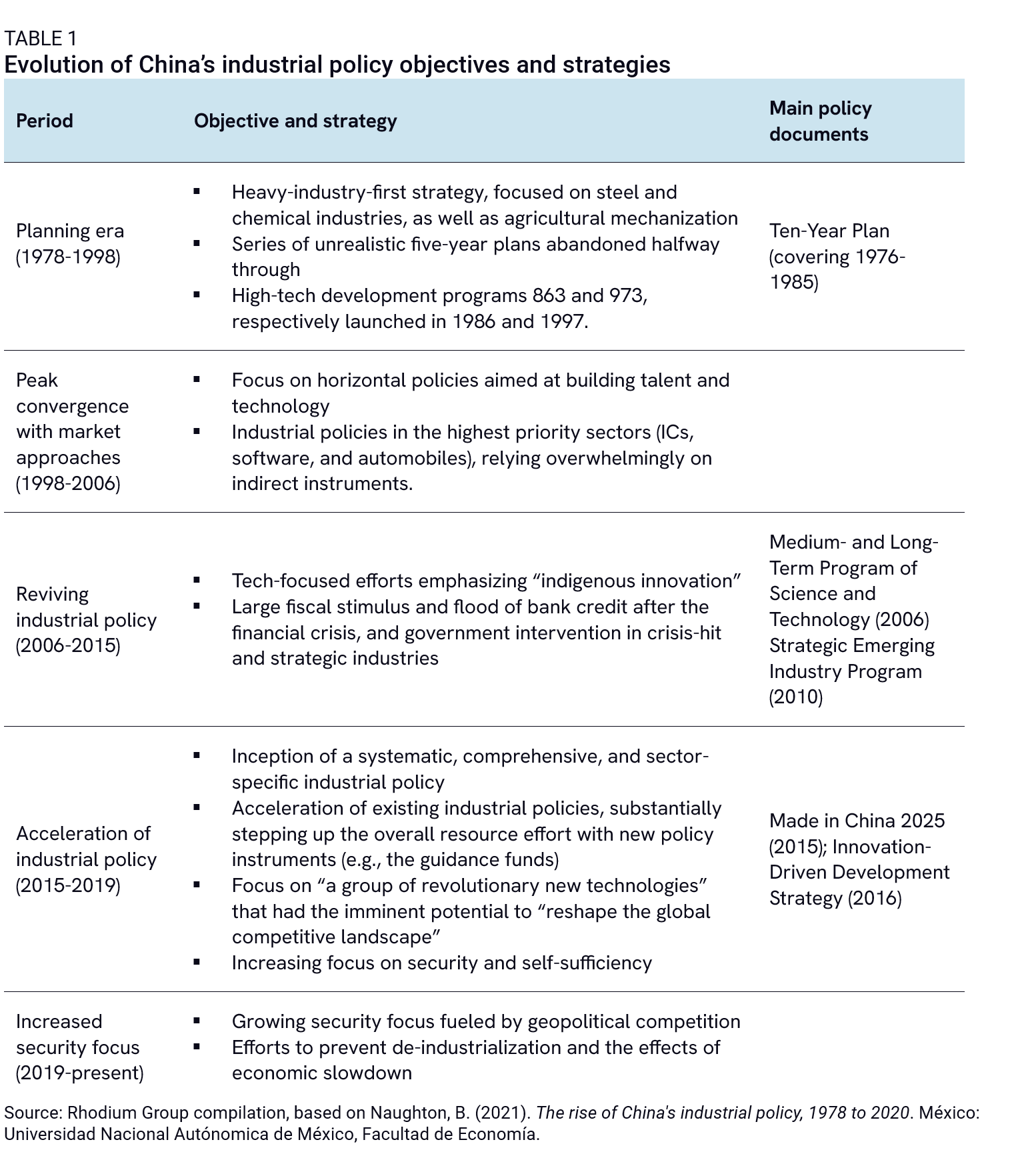
The lighter-touch approach to China’s industrial policy was successful in a number of ways. Before 2008, China’s huge protected market was instrumental in promoting domestic companies in the early stage of industry development while enlisting the help of foreign companies through trade and FDI. Fast-growing consumer demand and major strides in reducing trade and investment barriers gave multinational corporations (MNCs) a compelling reason to invest in China. At the same time, China regulated investment and procurement to encourage foreign firms to localize production in key sectors if they wanted to access the market—effectively exchanging “market share for technology.”
A prime example of this strategy is China’s high-speed rail (HSR). Under the “Long-Term Plan of HSR Network” approved in 2004, China sought foreign high-speed rail manufacturers to enter its market in exchange for technology transfer. This involved three key principles: importing advanced technologies, organizing joint design and production with foreign partners, and developing a Chinese HSR brand. Major international players, such as Kawasaki, Bombardier, Alstom, and Siemens, were invited to participate in tenders from 2004 to 2006, requiring them to collaborate with Chinese manufacturers in the bidding process.
This approach was effective in developing domestic capabilities in HSR and other sectors. By 2009, domestic HSR manufacturers captured about 85% of the domestic market.4 In 2008, solar cell production in China accounted for 40% of the global output. The same year, Chinese companies accounted for 79% of the domestic cardiovascular stent market, up from 5% in 2004. In 2011, China accounted for more than 30% of global exports of permanent magnets used for wind turbines.5 Overall, China’s share of global manufacturing rose from 5% in 2001 to 12% in 2008, while China’s share of global exports reached 9% the same year.
Despite some successes by local companies, these early “made in China” achievements were in large part the product of foreign investment, with foreign enterprises accounting for more than half of China’s exports in 2008. Much of the made-in-China phenomenon was still concentrated in low-value added products. As of 2010, more than two-thirds of Chinese processing trade enterprises focused on labor-intensive production. China’s export-oriented economy, with net exports accounting for 8% of GDP in 2008,6 was also dependent on global markets.
The financial crisis of 2008-2009 helped bring about a new phase in China’s industrial policy. Beijing reacted to the crisis by unleashing an unprecedented flow of financial resources to stimulate domestic production. The size of the banking system quadrupled in just eight years, between 2008 and 2016. Chinese manufacturing firms received ample low-interest loans with little regard for firm productivity, leading to a rapid increase in their production capacity. High investment rates modernized China’s infrastructure and production technology, supporting its rise as a global manufacturing powerhouse.
Simultaneously, Beijing intensified industrial programs dedicated to developing domestic innovation capacities. The government had already planned to fund 16 “megaprojects” as part of the 2006 Medium to Long term Program of Science and Technology (MLP), but that funding really skyrocketed after 2008, from RMB 6 billion in 2008 to RMB 33 billion in 2009 and RMB 50 billion annual in subsequent years.7 The “Strategic Emerging Industries” (SEI) program, issued in 2009 marked the beginning of a full-fledged targeted industrial policy aimed to develop innovative domestic industries.2
This approach was effective in driving China’s industrial growth. By 2015, China accounted for 26% of global manufacturing value-added, against 14% in 2008.8 Local companies made some impressive achievements in the electronics and medical device sectors. China’s share of global manufacturing exports rose from 12% to 18% over the same period. In 2015, Xiaomi and Huawei were the top vendors of smartphones in China, with Apple and Samsung ranking third and sixth, respectively. Domestic companies accounted for 25% of the domestic color doppler ultrasound market in 2016, against only 10% in 2010. The market share of Chinese robot suppliers grew to 29% in 2015. Chinese-branded cars accounted for 25% of the domestic market in January 2015.9 Overall, low-tech goods accounted for only 28% of China’s exports in 2014, compared with 41% in 2000.
Nonetheless, China remained reliant on foreign firms for many high-tech products, and the limitations of its industrial policy were becoming increasingly clear. Chinese semiconductor suppliers represented 1.9% of total worldwide revenue in 2013, up from 0.2% in 2003 but below earlier market expectations. While China was the second-largest domestic aviation market in the world, it still did not have its own large commercial aircraft. China still relied on foreign manufacturers such as GE HealthCare, Siemens, and Philips for most of its high-tech medical devices, including MRI machines and CT scanners. Labor productivity in China was still several times lower than in most industrialized economies. China’s debt-driven industrial strategy was also reaching a turning point. The widespread moral hazard built in this model generated financial risk and a heavy debt burden, with China’s debt-to-GDP ratio growing to 254% in 2016, up from only 142% in 2006.
MIC25: A shift in China’s industrial policy approach
The perceived insufficiencies of China’s industrial policy motivated the new Xi administration to act, in the form of the Made in China plan issued in 2015 and the Innovation-Driven Development Strategy (IDDS) plan issued a year later. A ten-year action plan published in 2015, MIC25 was designed to propel China to the forefront of technological innovation and increase the global competitiveness and market shares of Chinese companies. According to the MIC25 plan’s own assessment, “China is still in the process of industrialization, and there is still a major gap compared with advanced countries. The manufacturing industry is large but not strong. The capacity for independent innovation is weak, and key and core technologies and high-end equipment are highly dependent on foreign countries.” The plan emphasized the development of critical technologies across various advanced manufacturing industries, including information technology, new energy vehicles, robotics, biomedicine and medical devices, and aerospace (Table 2).
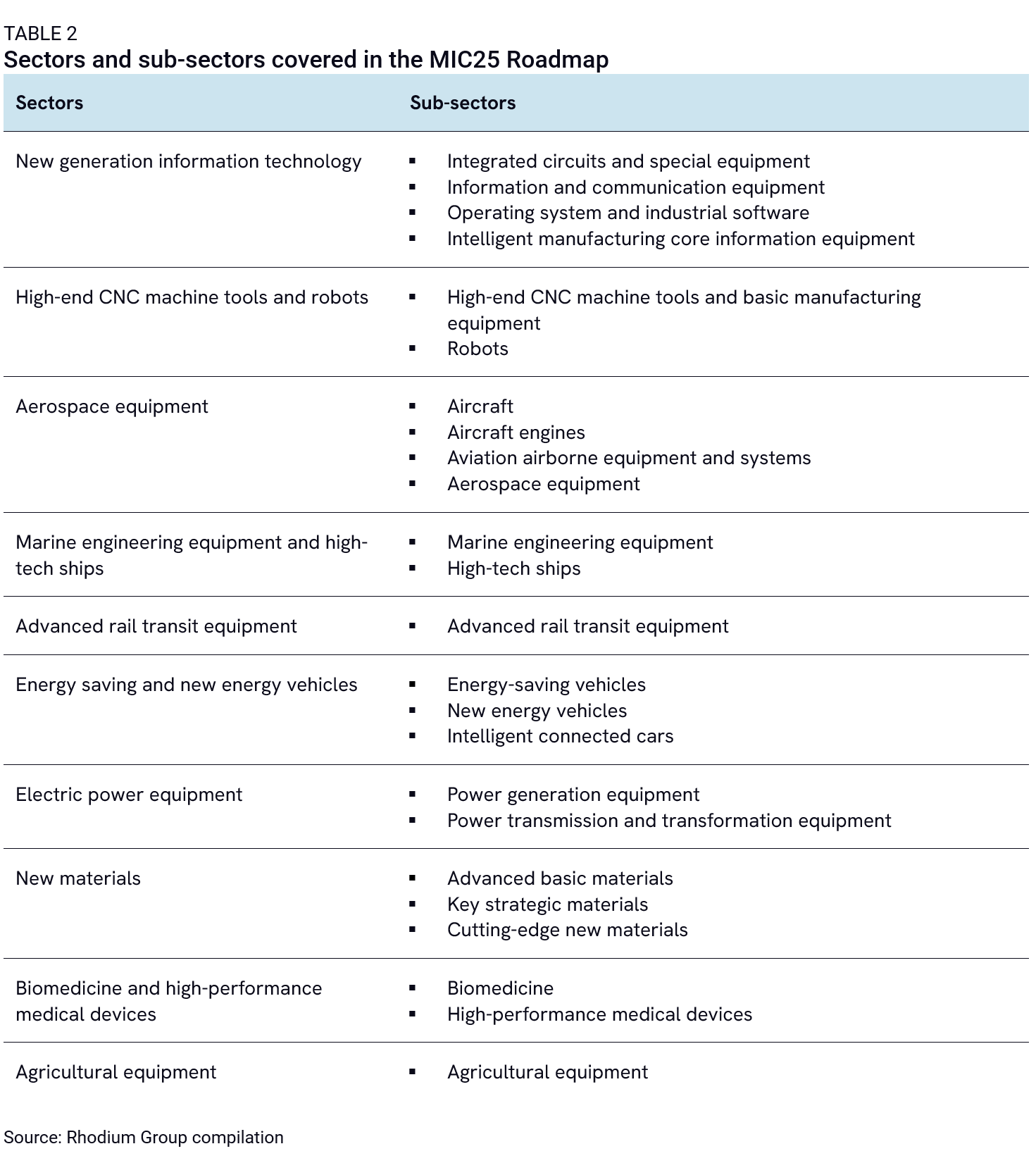
The MIC25 plan was a flexible high-level strategy, gradually translated into specific implementation plans through a multitude of central, local, and industry-specific documents over the following years. Within the first two years, a dozen additional documents provided detailed guidance for its rollout. This was followed by implementation regulations at the ministry level, resulting in a massive body of 445 national policy documents by the end of 2018. Although MIC25 was primarily focused on hardware and advanced manufacturing, the significance of artificial intelligence (AI) in Beijing’s industrial policy strategy expanded considerably after 2015. The MIC25 strategy influenced and intertwined with broader initiatives, such as the “Internet+” strategy launched in 2015 and the New-Generation Artificial Intelligence Development Plan introduced in 2017. Together, they formed a network of mutually reinforcing policies aimed at accelerating economic modernization and positioning China as a global leader in manufacturing, technology, and innovation.
Local governments played a key role in translating the national vision into actionable directives, developing localized implementation plans and pilot projects, frequently with government funds, aligned with MIC25’s objectives. Over time, the goals of MIC25 were refined through central and local iterations based on successes and challenges. The 2018 update of the Technology Roadmap—a significant milestone—adjusted priorities to reflect technological advancements and China’s increasing emphasis on self-reliance. The evolution of MIC25’s priorities is also evident in subsequent implementation plans, with a growing focus on areas such as “green manufacturing” and internet technologies.
Central to the plan was gradually replacing both imports and foreign company products with products made in China by Chinese firms. MIC25 outlines that by 2025, China aims to achieve 70% self-sufficiency in core basic components and key basic materials. By 2049 (the 100th anniversary of the country’s founding), China should be at the forefront of the world’s manufacturing powerhouses. The strategy emphasized “indigenous innovation” and “self-sufficiency,” entailing a focus on controlling essential core technologies and enhancing industrial supply chains to ensure national economic and security resilience. The self-sufficiency ambition was even more evident in the Key Technology Roadmap, issued together with the MIC25 plan and including detailed targets for the market share of China-made and Chinese-made products in each sector. Despite the Ministry of Industry and Information Technology’s (MIIT) claim that the roadmap is purely scientific and non-policy-driven, the Roadmap is widely regarded as a political guiding document, endorsed at the highest levels of government.
None of these objectives were new. Indigenous innovation and technological self-reliance have been the centerpiece of China’s innovation strategy since the 2000s. MIC25 builds on earlier initiatives like the 863 Program, a high-tech development plan issued in 1986, and the Medium and Long-Term Plan for the Development of Science and Technology, a 15-year plan issued in 2006. Rather, what was new with MIC25 was the range and depth of China’s industrial policy efforts that it unleashed and its explicit focus on addressing China’s remaining dependencies on foreign countries for key inputs and technologies.
While comprehensive, the original MIC25 plan emphasized three policy approaches in particular: enhanced policy implementation (through institutions like the State Leading Group for Building China into a Manufacturing Powerhouse); making the market environment more competitive though manufacturing industry contestability and support for small and medium enterprises; and targeted financial assistance, including venture capital, loans, and expanding fiscal and tax policy funding.
But according to a 2017 US Chamber of Commerce report, MIC25 mostly relied on intensified government control and preferential use of financial support and legal and regulatory tools, including conditional market access. These measures were aimed at systematically strengthening domestic firms while selectively integrating foreign capital into strategic sectors. MIC25 mainly used the following key policy instruments:10
- Leveraging state investment through state-guided investment funds: Nearly 800 state-guided funds, with a combined value of RMB 2.2 trillion by 2017, were established to support R&D and industrial innovation, with a focus on MIC25-related industries.11 These funds were used to channel state-directed capital into key sectors to spur technological advancements and reduce reliance on foreign technologies.
- Increasing subsidies and credit channeling to key actors: Financial policies encouraged banks to provide targeted support to MIC25 industries, including loans for innovation, tax incentives, and export credit insurance. These measures aimed to lower financial barriers for domestic firms and boost their global competitiveness.
- Strategic overseas investment: MIC25 supported Chinese companies in acquiring foreign technology and expertise, especially in areas like semiconductors and advanced manufacturing. These investments allowed Chinese firms to rapidly acquire technologies to bridge gaps with global leaders.
- Creation of national champions through SOE consolidation: The State Council issued directives to consolidate state-owned enterprises (SOEs) in sectors like telecommunications, aviation, and smart manufacturing. This consolidation aimed to create globally competitive “national champions” by streamlining resources and scaling operations.
- Promoting the establishment of new domestic competitors: The policy intended to displace the foreign “chokehold” on key technologies. Favored companies benefited not just from the usual Chinese industrial policy tools of financial and regulatory support and favoritism in the market, but also from visible, high-level political support rarely bestowed on such nascent businesses.
- Support for “little giants” and smaller companies: MIC25 placed a growing emphasis on fostering smaller firms with innovative potential. These companies were supported through funding, pilot projects, and integration into global value chains to build a robust ecosystem of agile, market-driven players.
- Protecting local actors with restricted market access: China implemented strict market access rules for foreign firms, including joint venture requirements and technology transfer mandates in MIC25 priority sectors like auto manufacturing, civil aviation, and telecommunications. These restrictions allowed domestic firms to dominate key areas while benefiting from foreign expertise and investments.
- Encouraging foreign investments in critical areas: While protecting domestic firms, the strategy also outlined bringing in more foreign capital and guiding foreign investment into “high-end manufacturing fields such as new generation IT, high-end equipment, new materials, and biotech and pharma.” The goal was to selectively integrate foreign expertise into sectors where it could complement domestic capabilities: This would accelerate technological development by diffusing technological know-how throughout the broader Chinese economy, including to domestic Chinese competitors. For example, China’s leading medical imaging manufacturer, United Imaging, was founded by several Chinese engineers who previously worked at Siemens’ imaging plant in China. Siemens subsequently tried unsuccessfully to bring legal action against them in Chinese courts for theft of intellectual property.
The outspoken rhetoric of MIC25, emphasizing self-sufficiency and favoring domestic actors, including through product and technology localization targets, provoked significant international criticism, straining trade relations and fueling broader geopolitical and economic tensions. In the United States, MIC25 was seen as a direct threat to national security and technological leadership. The inclusion of explicit market share targets in early versions of the plan raised alarms among trade experts, signaling China’s intent to heavily influence global market outcomes. In 2018, a Trump administration investigation under Section 301 of the 1974 Trade Act labeled China’s trade policies, including MIC25, “unreasonable and discriminatory.”12 This justified sweeping tariffs on MIC25-related industries and tightened export controls and investment screening, a stance largely continued under the Biden administration.
In response to international backlash, China downplayed the strategy, reducing media coverage and references to terms like “MIC25” and “self-sufficiency rate.” By 2019, MIC25 was absent from policy lists and key speeches, leading to speculation it had been abandoned. However, its core objectives persisted, with Beijing quietly doubling down on the industrial policies articulated in MIC25, while recalibrating public messaging to reduce scrutiny. Since then, the focus on self-sufficiency has only intensified. In a 2020 speech published in Qiushi, Xi Jinping outlined the Party’s goal of building “an independent, controllable, safe, and reliable domestic production and supply system” capable of sustaining the economy during extreme circumstances. Under Xi Jinping, self-sufficiency and state control have become central priorities, driven by domestic political pressures and rising geopolitical tensions.
A ramp-up in China’s industrial policies
Ten years later, the intensification of financial support is clearly visible in the data. China’s intensification of financial support for its industries has been unprecedented in scale and scope, particularly through non-conventional means that circumvent and ignore WTO compliance concerns and minimize fiscal strain. Research estimates that Chinese industrial policy spending far outpaces other economies, with state support averaging 4.5% of firm revenues in covered sectors—significantly higher than the OECD average of 0.69%. This is only considering conventional industrial policy instruments. Looking more broadly, the state-directed financial system has likely played an even more central role in this strategy, with vast credit allocation to politically prioritized sectors enabling Chinese firms to expand rapidly, often without the same considerations for profit and return as their international peers. This abundance of state-backed credit, combined with tools like below-market borrowing, tax benefits, and direct grants, has allowed Chinese firms to lower prices, invest heavily, and capture domestic and then global market share at a faster pace than competitors.
Direct support through grants—the most visible tip of China’s industrial policy iceberg—has experienced the least impressive growth in this ecosystem. Average government grants to listed companies grew by 80% between 2015 and 2023, a faster pace than in previous years, but slower than China’s GDP growth. More importantly, the intended re-focusing of resources toward key sectors is not visible in the data. Instead, firms in non-MIC25 sectors (which, according to our estimates, accounted for 67% of the number of listed companies in 2023) seem to have benefited at least as much from the ramp-up in government grants (Figure 1).
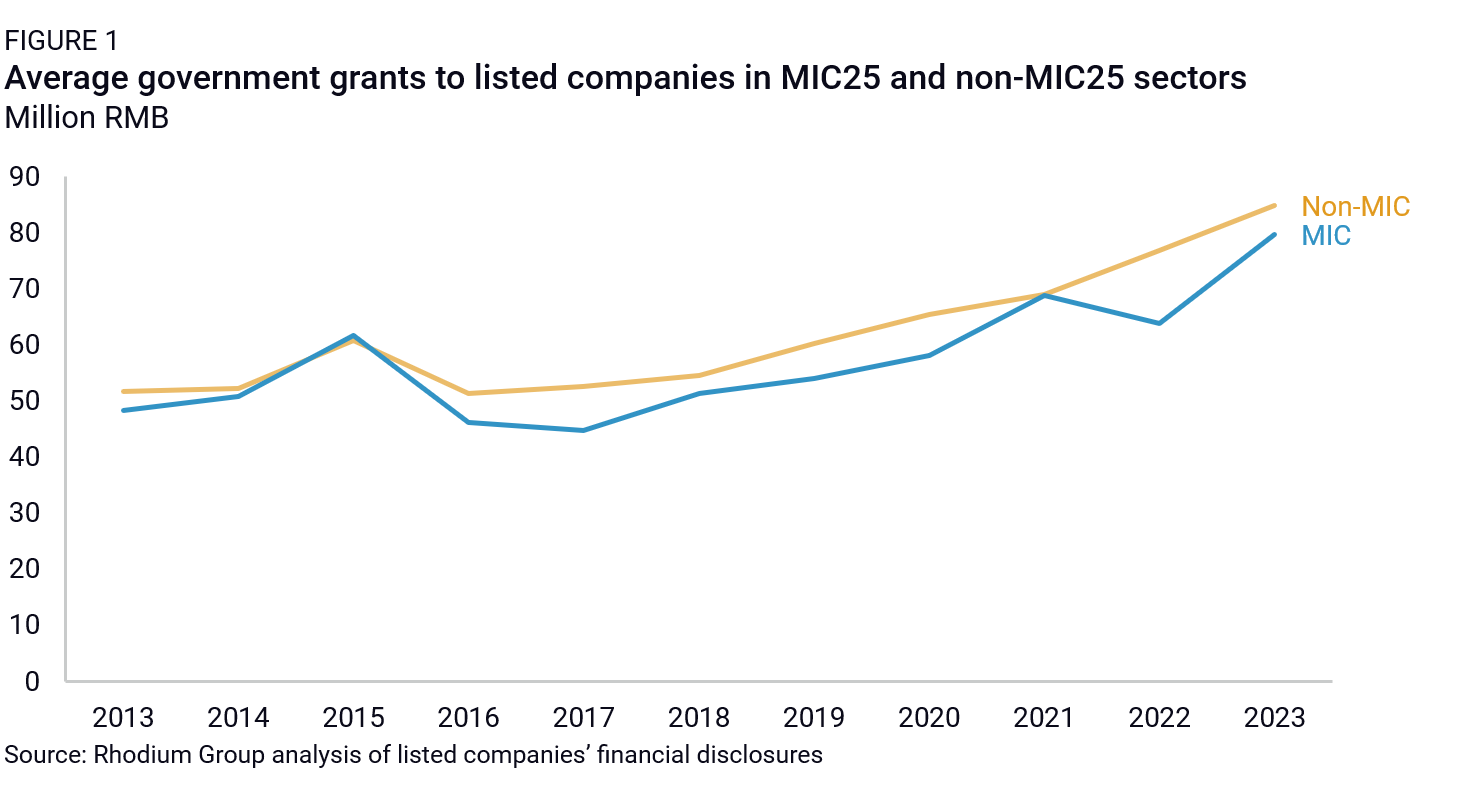
Looking more precisely at MIC25 sectors, average grants to listed firms have increased the most for the power generation and next-generation information technology (IT) sectors, which include products seen as highly strategic by Beijing, such as electric vehicles (EVs), EV batteries, wind turbines, and semiconductors (Figure 2). Only in those two sectors did average direct grants increase faster than GDP growth. All other sectors, except agricultural machinery and marine technology, have seen an increase in the disbursed average government grants, but at a slower pace than GDP growth.
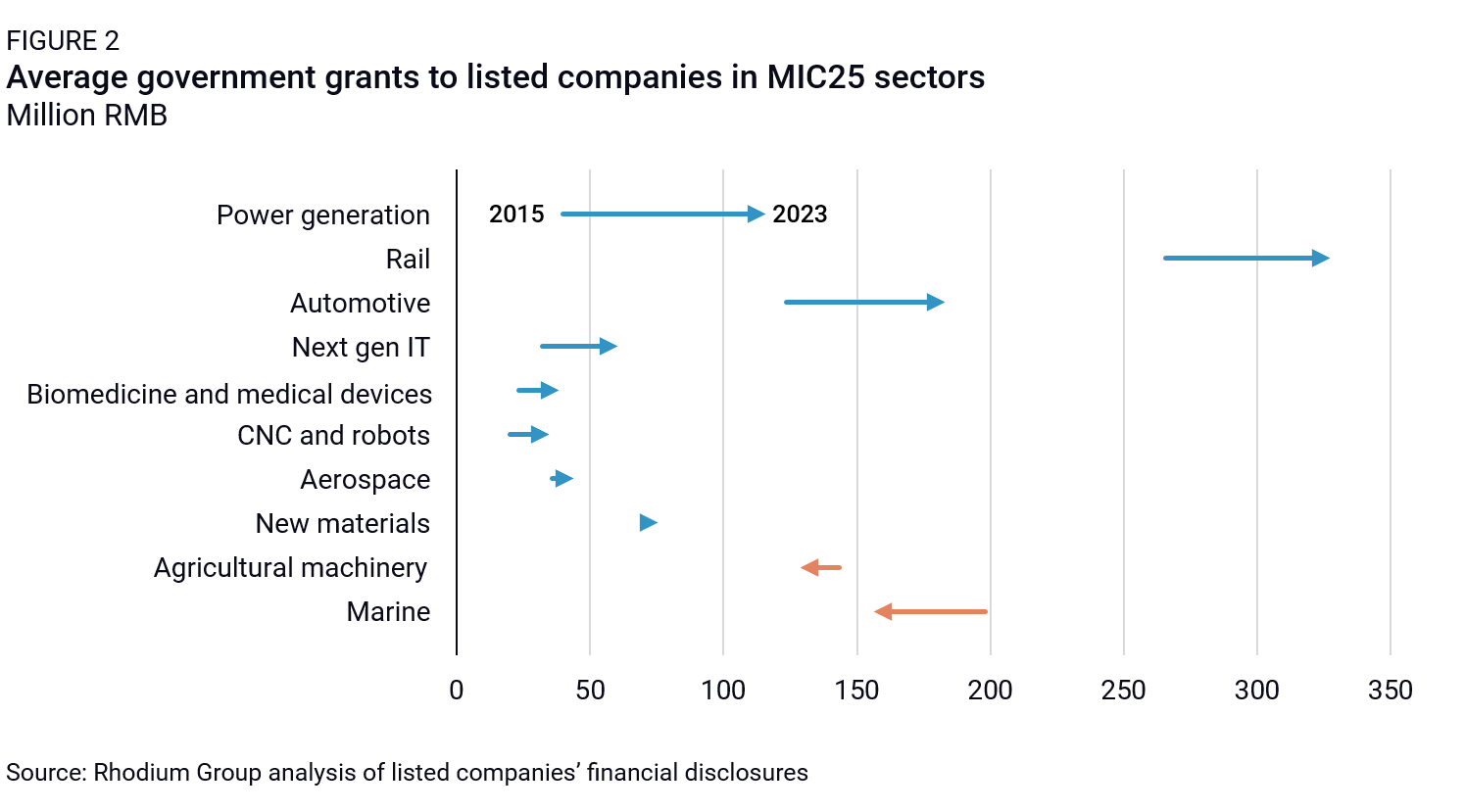
In comparison, government support through tax benefits has seen a much more dramatic growth, and one that has been more closely tailored to MIC25. The magnitude of tax benefits aimed at fostering innovation surged by an average annual rate of 28.8% between 2018 and 2022. The proportion of companies enjoying additional deductions and tax reductions more than quadrupled between 2015 and 2023. Most of these tax cuts, including major increases in the amount of taxes deducted as part of the “super deduction of R&D expenses,” were introduced in the past decade (Table 3).
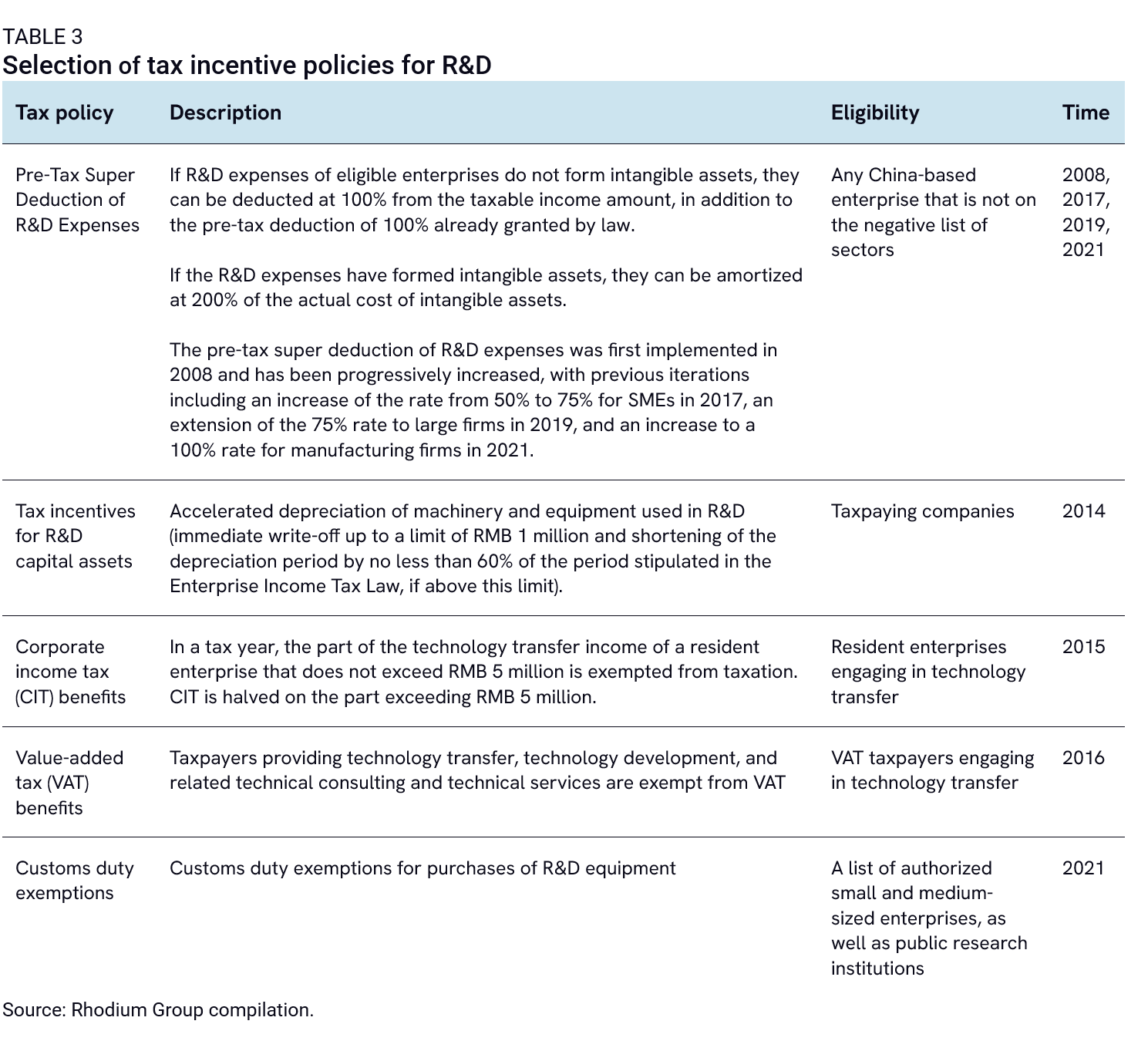
China’s industrial policy in the past decade also saw regulatory innovation in the form of new indirect instruments of state support such as government guidance funds (GGFs), which were first rolled out in 2005, but experienced tremendous growth following the MIC25 strategy in 2015 (Figure 3). GGFs are government-established funds, which partner with other public and private funds to invest in industries and companies that are targeted by Chinese industrial policy as strategic areas for development. Beijing continues to rely on them to fund industrial policy. The third and largest ($47.5 billion) phase of the China Integrated Circuit Industry Investment Fund was launched in 2024, and in January 2025, a GGF was set up to invest in AI with initial capital of $8.2 billion.
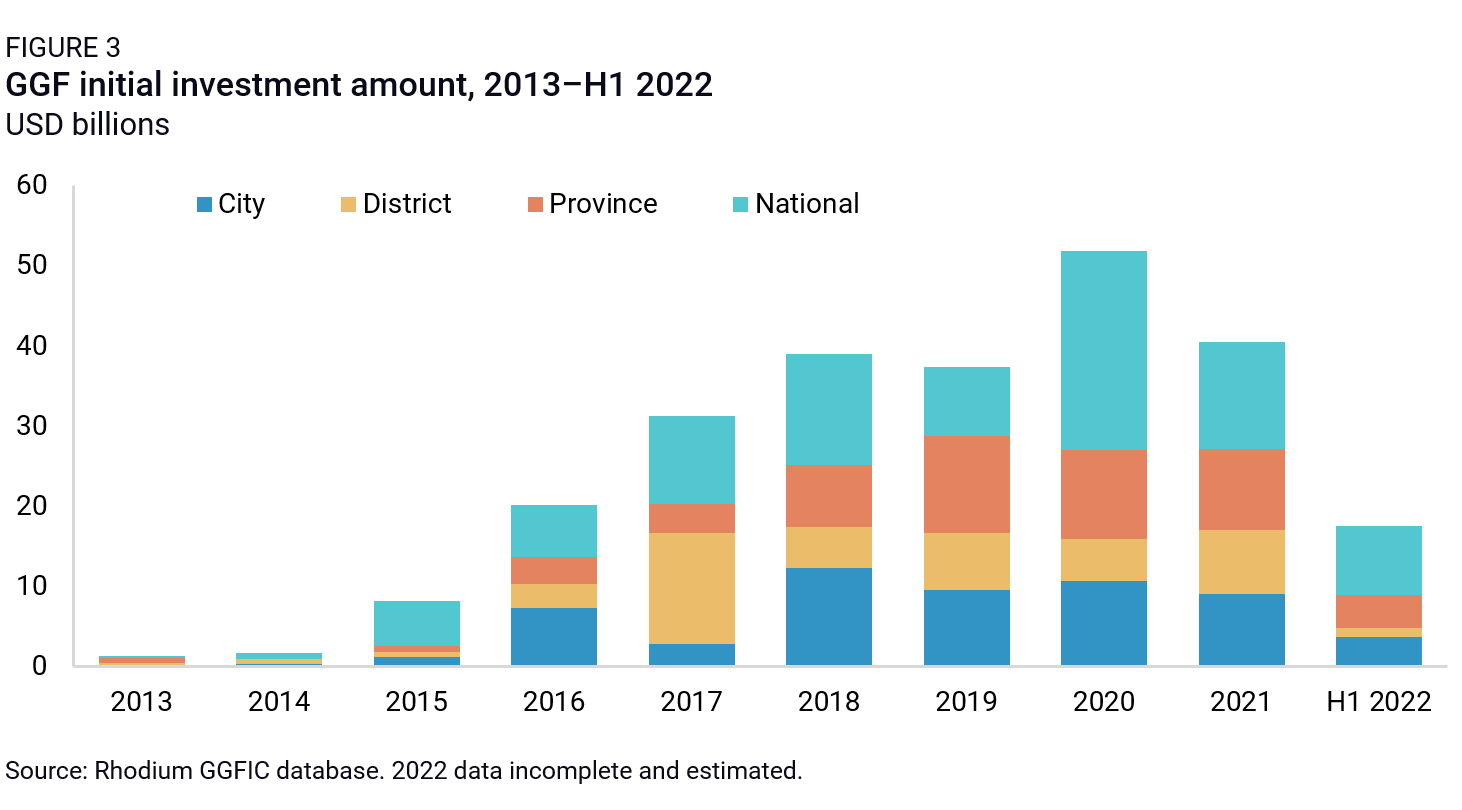
Perhaps even more significant was Beijing’s indirect support through China’s state-controlled financial system. Major state-owned banks and other financial institutions are heavily influenced by political directives. Capital markets increasingly focused on advanced manufacturing, as exchanges limit which firms are allowed to list on certain boards. As then China Securities Regulatory Commission (CSRC) chairman, Yi Huiman, explained in 2022, capital markets exist to “help implement national strategies regarding technological self-reliance and the development of modern industries.” Similarly, credit is allocated based on quantity-based targets and sectoral priorities rather than market fundamentals. This creates an environment where state-backed firms face softer budget constraints, enabling them to sustain losses, scale quickly, and maintain artificially low prices. The implicit guarantees throughout China’s financial system have also led to an extraordinary financial expansion in the past two decades, which allowed Chinese firms to dominate key global markets, push down on prices, and disrupt global competition. Although the rate of credit growth slowed down after 2016—credit reached unsustainable levels and the government was focused on deleveraging—it remained very high. Over the past three years, lending has also increasingly been channeled to manufacturing sectors to compensate for the decline in the property sector. Beijing has sought to exert more control on the allocation of credit, with state-directed economic targets encouraging lenders to extend substantial financing to specific sectors and actors based on Beijing’s perceived support. Political targets and national policy plans (such as the MIC25 Roadmap) are mentioned in major banks’ reports as key guidance for the allocation of loans.
Notably, state support has also extended beyond just financial aid. A decade after the launch of the MIC25 strategy, concerns from analysts and policymakers about reduced market access and rising discriminatory practices appear to have been well-founded. In annual American Chamber of Commerce business confidence surveys, “inconsistent regulatory interpretation and unclear laws” rose to the top of foreign businesses’ concerns in 2016, from a second or third position previously, and stayed there until 2019, after which it was topped by the rising tensions in US-China relations. Similarly, 58% of respondents of the European Chamber of Commerce in China’s annual Business Confidence Survey in 2024 reported missing business opportunities because of such barriers, up from 42% in 2022. These barriers, particularly involving government-linked customers (which occupy a larger share of China’s state-led economy in comparison to those in other leading economies), result in significant disadvantages for foreign firms. In the same survey, a fifth of respondents who lost business opportunities as a result of market access or regulatory barriers reported they would have been worth more than a quarter of their annual revenue. Though discriminatory practices had been rife before, interviews with market participants confirmed that 2015 was a turning point in many sectors, with such practices growing, becoming national rather than local in scope, becoming matters of formal policy rather than informal practice, and increasingly targeting high-tech areas. Foreign firms have also increasingly been pressured to localize their production, through rising market restrictions and procurement discrimination, the EU Chamber of Commerce found in a 2025 report.
In our survey of US Chamber of Commerce members, respondents generally assessed that Chinese state support increased over the past decade (41% saying strongly and another 37% saying moderately). Respondents identified easy and cheap access to credit and below-market debt, direct subsidies, and biased public procurement regulations as the state support that helped their Chinese competitors gain market shares (Figure 4).
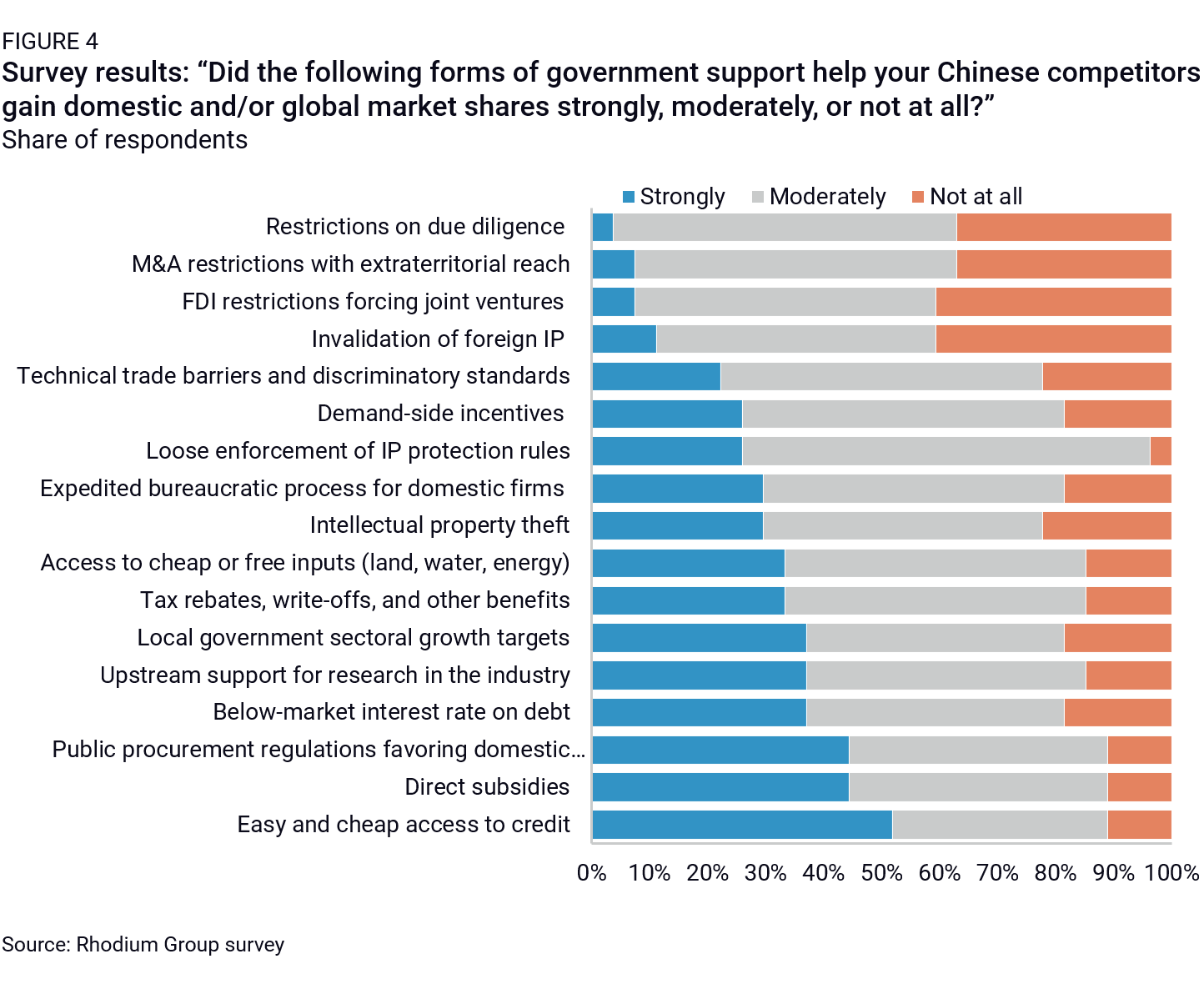
The medical device sector is a case in point. As a 2019 paper noted, “accessing the Chinese market for medical devices has never been easy but it has become increasingly challenging in recent years.” Policies aiming to force foreign companies to localize high-tech production and research and squeeze them out of market segments where local players were strong enough to compete intensified after 2014-2015 (Figure 5).
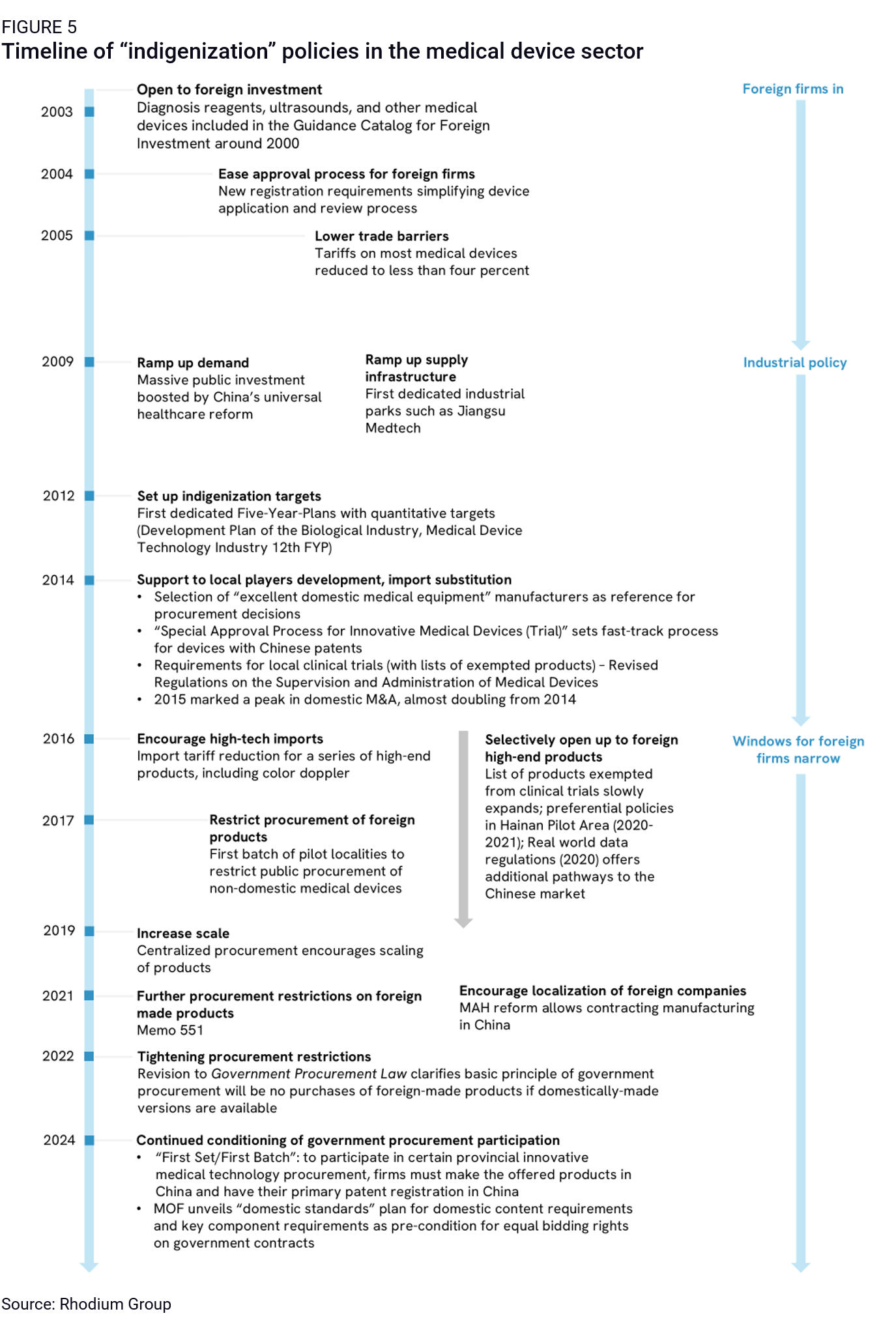
Although Beijing has since toned down its rhetoric and dropped references to MIC25 from policy papers, the strategy seems to have kept its promises, both in terms of the expected ramp-up in financial support and increasingly leveraging China’s legal and regulatory environment and market access to favor domestic companies.
How to assess MIC25’s success
Before diving into MIC25’s track record to date, one needs to establish clearly what is our marker for success and failure. In short, the dependent variable for research needs to be clearly established. This is not an easy task, because there are so many ways to examine success. MIC25 encompasses numerous objectives, ranging from innovation to self-sufficiency to competitiveness. Previous research has generally selected one of these criteria to evaluate success (Box 1).
Even “self-sufficiency” remains a fluid and somewhat ambiguous concept in MIC25. The Roadmap refers to it using multiple indicators:
- The domestic market share of locally-made products,
- The share of independently designed and produced goods by Chinese firms, and
- The proportion of parts and intermediary inputs that are both localized and under Chinese control.
This conceptual flexibility might be intentional. As one executive noted, companies have been “quietly told” that production within China could count toward national self-sufficiency targets.13 However, interviews suggest this inclusion often changes over time as local companies gain the strength to compete directly. Furthermore, with an opaque regulatory environment, moving goalposts, and a top-level political emphasis on national self-sufficiency, many Chinese buyers unsurprisingly feel safest selecting products from “indigenous” firms over those from foreign-invested enterprises (FIEs). Indeed, the fact that the Ministry of Finance (which has jurisdiction over procurement policy) has felt obligated to repeatedly affirm that FIE products will be considered eligible to meet the requirements of China’s new government procurement policies only underscores that such national treatment is neither established custom nor expected.
This report addresses MIC25’s diverse goals by assessing progress across four main categories:
- Decreasing China’s import dependency,
- Decreasing China’s dependency on foreign companies,
- Achieving global competitiveness, and
- Becoming a technological leader.
While these objectives are interrelated, each is conceptually distinct. For instance, China might lower its import dependence while still relying on foreign-owned companies producing domestically. Likewise, it could meet domestic demand through local firms that may not yet be globally competitive or may produce lower-quality products—even as local dominance in China’s large market serves as a springboard for global competitiveness. Each objective requires tailored policies to achieve specific outcomes, as illustrated in Figure 6.
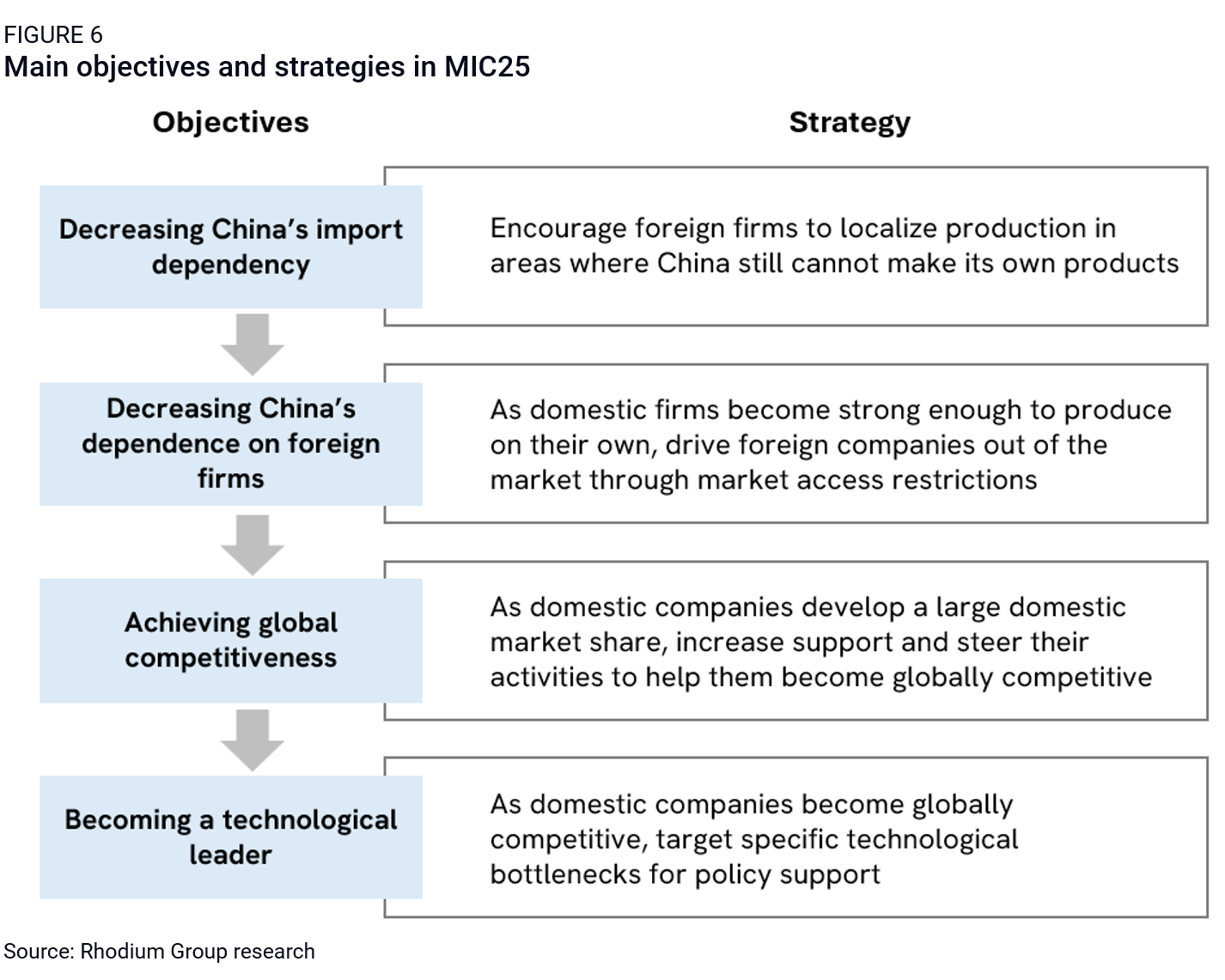
Each objective is evaluated using a broad set of indicators (Table 4). Given that each sector in the Roadmap encompasses thousands of products, each with unique characteristics, capturing comprehensive sectoral coverage is challenging. To address this, the report uses at least two or three representative products for each sub-sector covered in the Roadmap, both in the low-to-medium tech and high-tech segments. Selection is based on MIC25’s quantifiable targets, data availability, relevance to US-China technology competition or national security concerns, and each product’s significance within China’s industry, ensuring that each chosen product meets at least two of these criteria.
Due to limited data availability for certain sectors, our assessment of current progress is conservative. Given the rapid pace of capacity buildup in some sectors, particularly in recent years, the lack of more recent data means that some significant advancements may not yet be fully captured in this analysis.
We also triangulate our data using a survey of companies in the United States and interviews with experts and market participants. We mostly focus on eight of the ten sectors covered in the MIC25 strategy, with the exception of high-speed rail (where China’s self-sufficiency and technological leadership objectives were already basically achieved by 2015) and new materials (which is difficult to capture as a single, well-defined sector). Data on these two sectors, however, can be found in Appendix B.
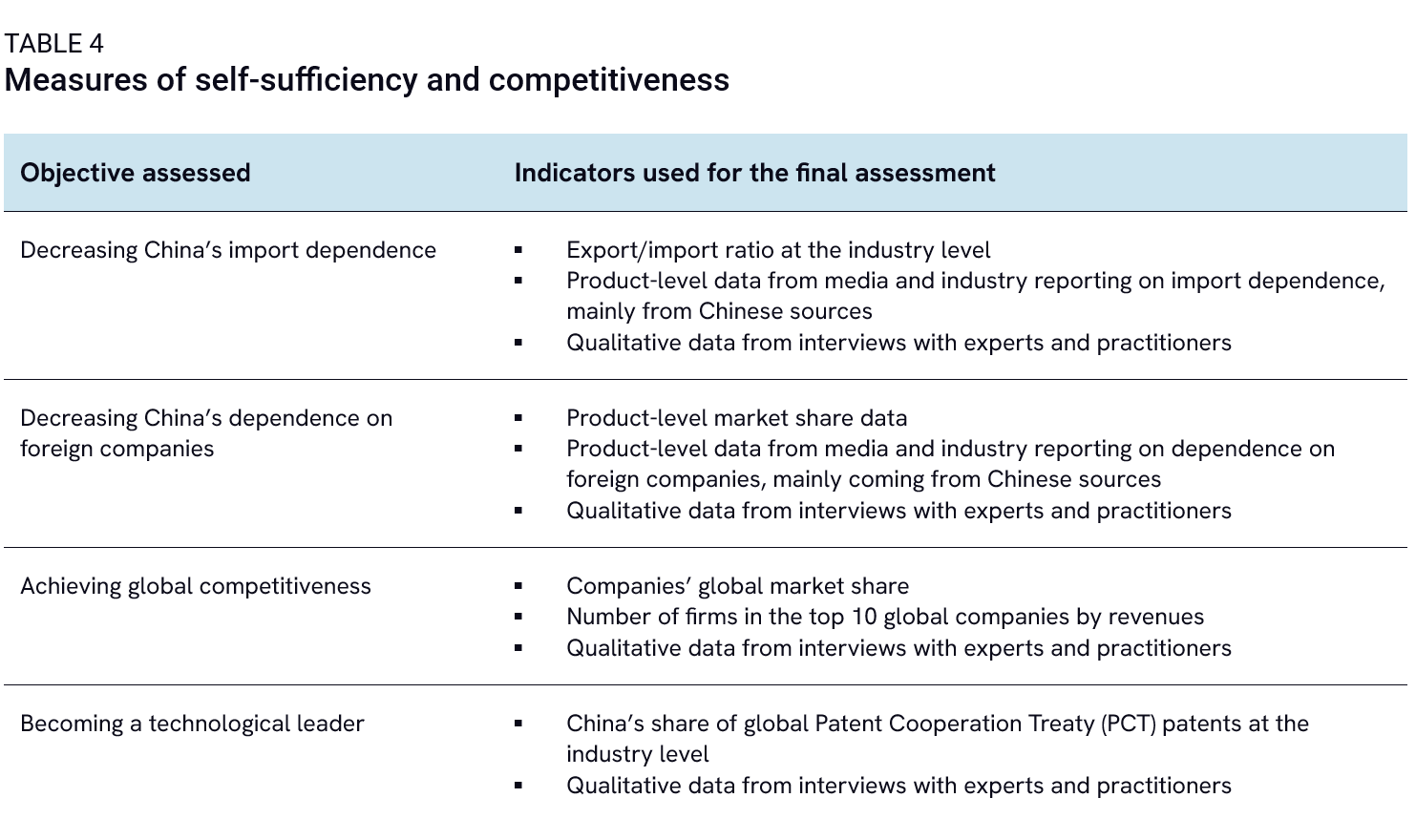
Additionally, we examine not only the specific quantified targets set by MIC25 but also the broader achievements of Chinese companies. While these targets offer insight into government intentions from a decade ago, they are somewhat arbitrary and have evolved since then. Therefore, it’s essential to assess both progress against these targets and the actual achievements of Chinese firms today, providing a fuller picture of sectoral advancement regardless of past benchmarks. Both specific targets and broader achievements are examined in detail in each following chapter of this report.
Progress is mainly assessed as of today, as summarized in Table 5. It is important to note, however, that this table presents an average that combines progress metrics across product categories within each sector, which may obscure critical nuances. For example, while China has achieved strong performance across all dimensions in sectors such as advanced rail transit equipment and electric power equipment, progress remains weak in areas like high-end CNC machine tools, and aerospace equipment. Some sectors have seen mixed progress, such as new-generation information technology, biomedicine, and marine technology. China leads in telecommunications equipment, the MIC25 sector where the highest share of foreign firms (44%) report facing Chinese competitors that can produce equal or superior products at comparable or lower prices, according to a 2025 EUCCC report. In contrast, semiconductors and operating systems remain among China’s most significant areas of vulnerability.14 Similarly, marine engineering equipment shows strong global competitiveness, but only mixed results in reducing import dependence and reliance on foreign firms. Detailed discussions of separate product categories are provided in each chapter. When possible, each chapter also discusses relative progress and likely future progress to measure the pace of China’s indigenous industrial development.
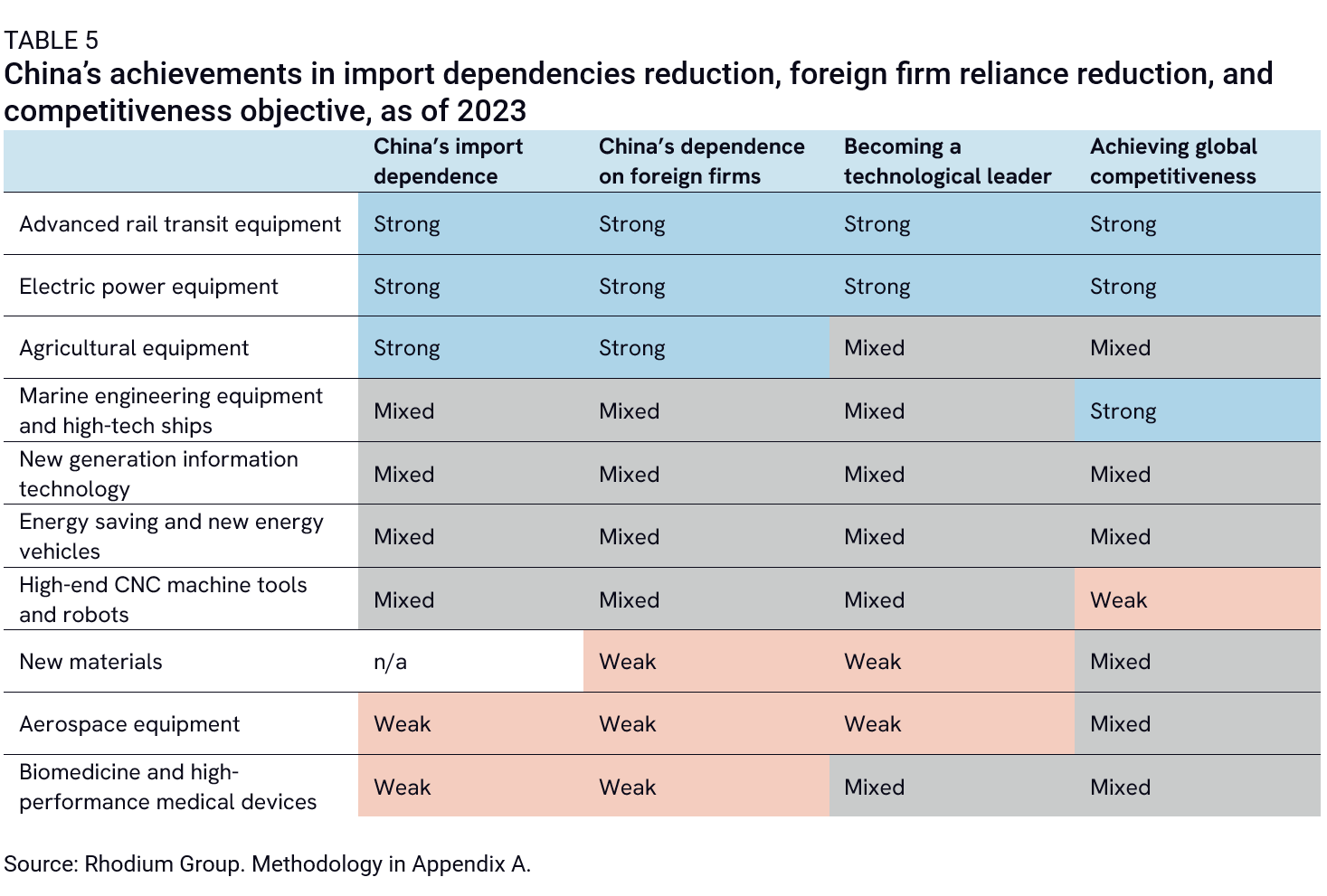
Lastly, this report analyses MIC25’s intended achievements. Chapter 2 examines achievements in the first objective (decreasing China’s import dependence). Chapter 3 examines achievements in the second objective (decreasing China’s dependence on foreign firms). Chapter 4 examines achievements in the third and fourth objectives (achieving global competitiveness and becoming a technological leader in global markets). The report concludes by also looking at the unintended effects of China’s industrial policies—including inefficiencies, overcapacity, high fiscal and debt burden, and limits on future GDP growth.
Chapter 2: Decreasing import dependencies by pressuring foreign companies to localize production
One of the key objectives of MIC25 was to eliminate import dependencies by either fostering domestic players or attracting foreign firms to localize their production within China. Targets for “Made-in-China” products—defined by their market share regardless of whether they are produced by domestic or foreign firms—were set in the Roadmap for key sectors such as IT, power generation, and medical devices. While Chapter 3 will look more specifically at the achievements of domestic players in gaining market share in China, this chapter focuses on the role of foreign companies in reducing China’s import dependencies.
Overall, China has been more successful in reducing its import dependencies and achieving its localization targets than in decreasing its reliance on foreign companies. China has both through formal measures and informal signals pressured foreign companies to localize production and research domestically, particularly in areas where products from emerging Chinese competitors would otherwise be the exclusive beneficiary of new buy-local preference policies. At the same time, some foreign companies have leveraged their manufacturing capacity in China to cater not only to domestic demand but also to regional and global markets. As a result, they have reduced their exports to China as they increased their production in China. However, many foreign firms continue to retain their most advanced intellectual property and cutting-edge technologies outside of China. Constraints persist in these areas, and paradoxically, China’s drive for industrial upgrades has, in some cases, even increased its demand for these highly specialized imported technologies.
Foreign firms’ localization in China
Foreign firms have been investing in manufacturing operations in China for decades and have continued this trend since 2015. Although the pace of new investments has slowed significantly compared to the previous decade, they have increasingly focused on high-tech sectors that align with China’s strategic priorities.
Between 2015 and 2023, US MNC subsidiaries in China—for which there is good available data—increased their R&D expenditures and value-added output by 77% and 43%, respectively. While this growth was slower than the previous seven-year period, which saw increases of 105% and 156%, it remains a significant expansion. Notably, despite escalating geopolitical tensions, US MNCs have accelerated the localization of both their value-added production and research investments in China since 2020. Additionally, the rise in sales by US subsidiaries in China has coincided with stagnating US exports to China, underscoring the role of import substitution driven by increased localization efforts (Figure 7).
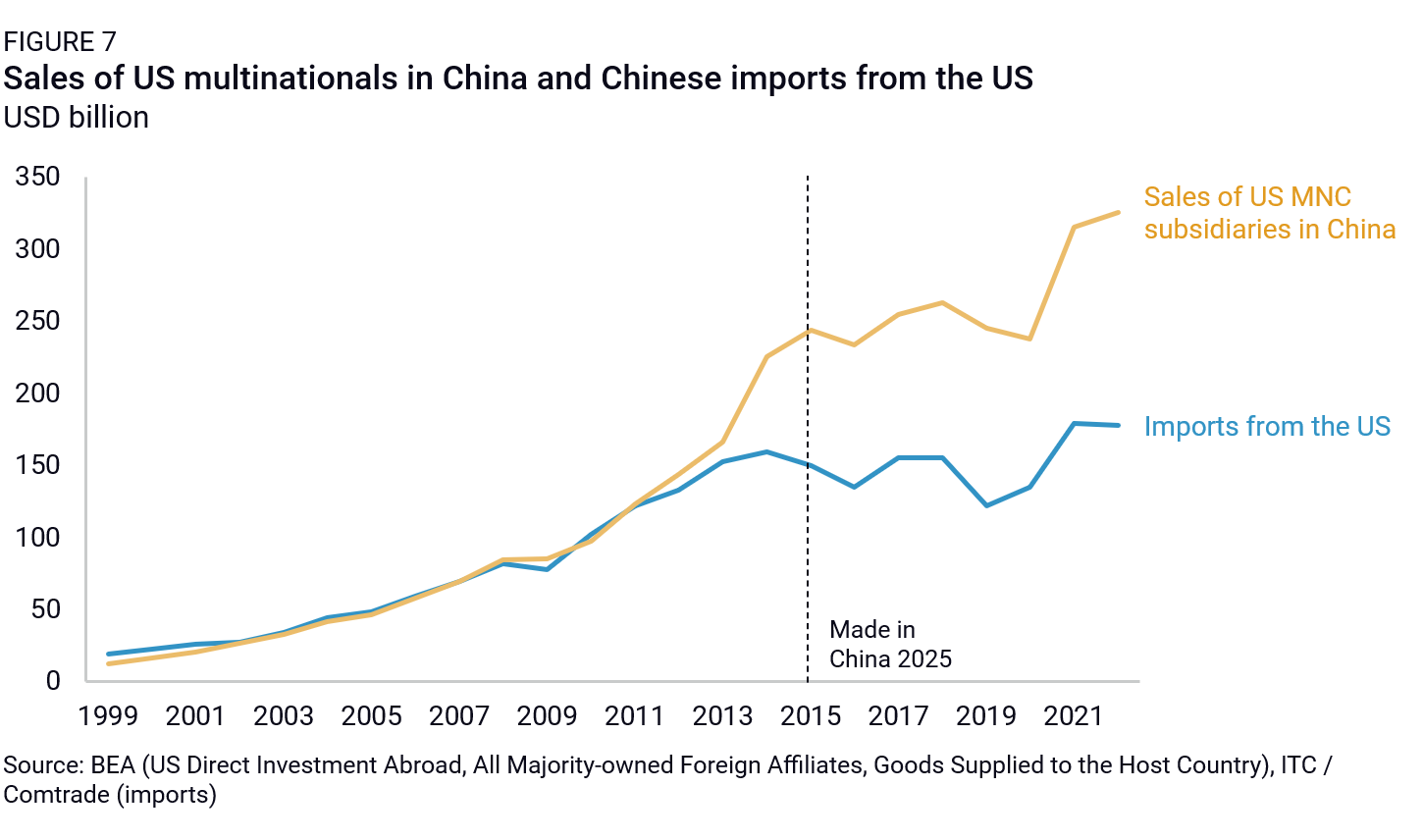
MIC25’s role in this trend is not entirely certain. On the one hand, the rise in protectionist and discriminatory measures—central to the MIC25 strategy—may have deterred some firms from investing in China. China’s growing mature market, its large talent base, and the increasing competitiveness of local players, certainly have also been key factors in motivating foreign firms to localize production and research despite the increasingly challenging business environment.
However, China’s targeted localization strategies, which require foreign firms to enter joint ventures or adopt a more “local” footprint to continue to enjoy full access to the Chinese market, have helped ensure that foreign investments align with China’s self-sufficiency objectives. Evidence suggests (though we only have data up to 2019) that these localization requirements have had a tangible impact on foreign investment. For example, the share of inbound FDI concentrated in high-tech sectors covered by MIC25 jumped after 2015, nearly doubling in a few years (Figure 8). In the same period, the share of joint ventures (which typically allow for more IP transfers) in total foreign FDI to China picked up, after declining for several years (Figure 9).
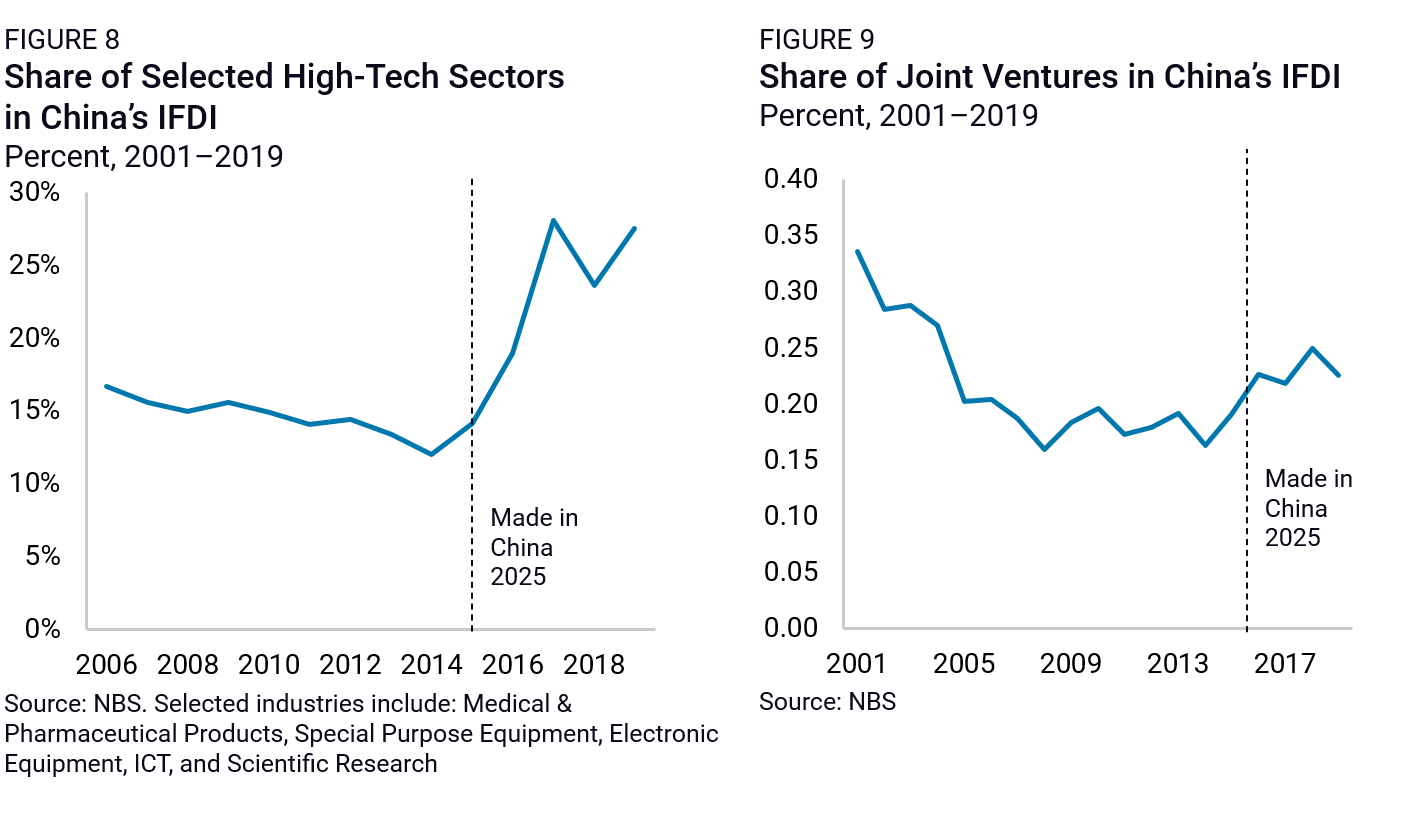
Foreign companies have localized manufacturing in China primarily to maintain access to the Chinese market. This shift has been driven in large part by government pressure and tightening market access for imports. At the same time, some firms have also used their China-based manufacturing operations to serve markets beyond China. In our survey of US Chamber of Commerce companies, two thirds of firms that reported increasing manufacturing capacity in China over the past decade said they did so solely to meet domestic demand, while one third reported that the expansion was aimed at serving regional or global markets as well.
Localization of foreign firms in the medical device sector
The drive for localization has been especially evident in the medical device sector. One somewhat unique characteristic of China’s medical device market (relative to some other sectors targeted under MIC25) is the key role of public hospitals, which reportedly accounted for 85% of medical care in China as of 2022. Because of a specific carve-out in the 1947 General Agreement on Tariffs and Trade (GATT)—the foundation of the modern WTO—government procurement is exempt from the GATT’s national treatment obligation, which normally requires its members to treat imported and domestic goods equally.
One growing tool in China’s toolbox of increasingly muscular industrial policies is what some have called the “weaponization” of this GATT government procurement loophole. Leveraging its large public procurement market, China has introduced a set of explicitly discriminatory, anti-import measures that go beyond the implicit or de facto discrimination practiced in other parts of the economy.
China’s recent procurement restrictions have fallen especially hard on the medical device sector, both because of its overwhelming reliance on government customers in China and because of China’s growing perception that adequate (if not world-leading) domestic substitutes are becoming available. In 2021, China quietly issued Notice 551, which indicated that for 315 types of medical and scientific devices that could be produced domestically (including most imaging equipment), government hospitals would henceforth be expected to procure a progressively higher percentage of their annual purchases from domestically made producers. China has since taken additional steps to entrench favoritism for domestic players through its procurement regime:
- In 2022, China announced revisions to its Government Procurement Law, indicating that one cornerstone of its procurement policy would be that where domestic products are available, imports should not be procured (and unlike other countries with domestic preference programs for procurement, at this juncture China has announced no limitations on how broadly this policy will be applied).
- In 2024, China announced that medical device companies looking to participate in procurement projects for “innovative medical technologies” would be required not merely to make the product in China, but to have the primary patent registration for the product be in China (while most MNCs have their primary patent registrations in their home market).
- In late 2024, China announced that in order to bid on government procurement projects, goods will not merely need to be “produced” in China but meet a not-yet-announced domestic content level. Furthermore, for “specific products” and sectors—widely interpreted to be a reference to those targeted under MIC2025—higher Chinese content levels, and Chinese production of key components or processes, may also be required.
In many respects, the legal and regulatory regime now facing MNC medical device companies trying to export to China has reverted to the uncertain environment that existed before China joined the WTO in 2001. Perhaps in reflection of this deteriorating environment, in early 2024, the European Commission launched its first ever investigation under the EU’s International Procurement Instrument (IPI), to determine whether China’s practices discriminatory policies and practices in its government procurement of medical devices. The investigation concluded in January 2025 that “China has put in place a multilayered overarching system of generally applicable preferences for the procurement of domestic medical devices that has led to a systematic discrimination against imported medical devices and foreign economic operators, implementing a comprehensive ‘Buy China’ policy.” As of this writing, the European Commission is working, in the absence of any policy changes by China, to develop appropriate remedial measures in the European Union procurement market.
In response to the increased inability to serve the Chinese market with imported products, multinational corporations have steadily increased their production and R&D activities in China in response. Over the past decade, eight of the nine surveyed American high-tech medical device producers have increased their manufacturing capacity in China. A majority have also increased sourcing from and R&D in China (Figure 10).
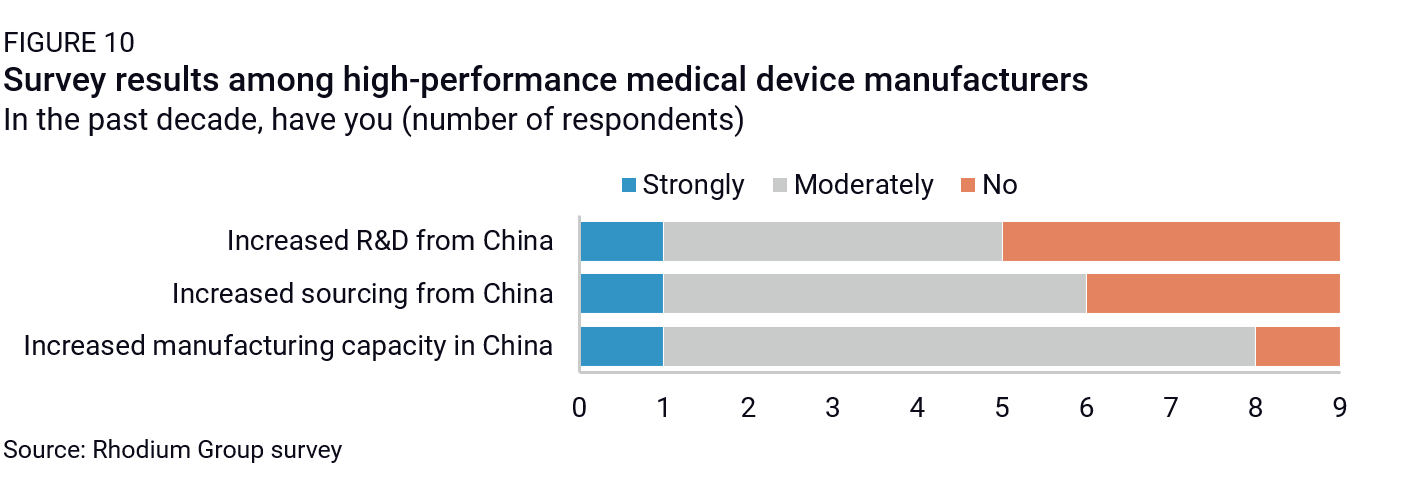
Major medical device companies, for example, have announced and realized localization plans in recent years. One European medical device company reportedly locally manufactures more than 90% of the company’s products sold in China, including some high-end medical equipment. The company also reportedly intends to ensure that 90% of its products for the Chinese market are sourced and assembled in China by 2024. Another likewise, pledged to deepen localization in China, including with the production of its latest 7T MRI equipment. The localization rate of the company’s supply chain in the country reportedly exceeds 80%.
According to survey data, Chinese localization requirements and barriers to imports (two sides of the same coin) ranked just behind demand growth to tie for the second most prominent reason for increasing high-performance medical device manufacturing presence in China (Figure 11). Setting aside MNC’s efforts to meet China’s localization requirements, emerging Chinese competitors are eroding the market share (and in some devices, market leadership) of foreign MNCs in Chinese government hospitals that previously enjoyed strong market share and have been present in China for decades. According to a 2025 EUCCC report, biopharmaceuticals and high-performance medical devices are the MIC25 sectors with the highest share of foreign firms (83%, compared to an average of 46% across sectors) reporting losses of market access since 2025.14
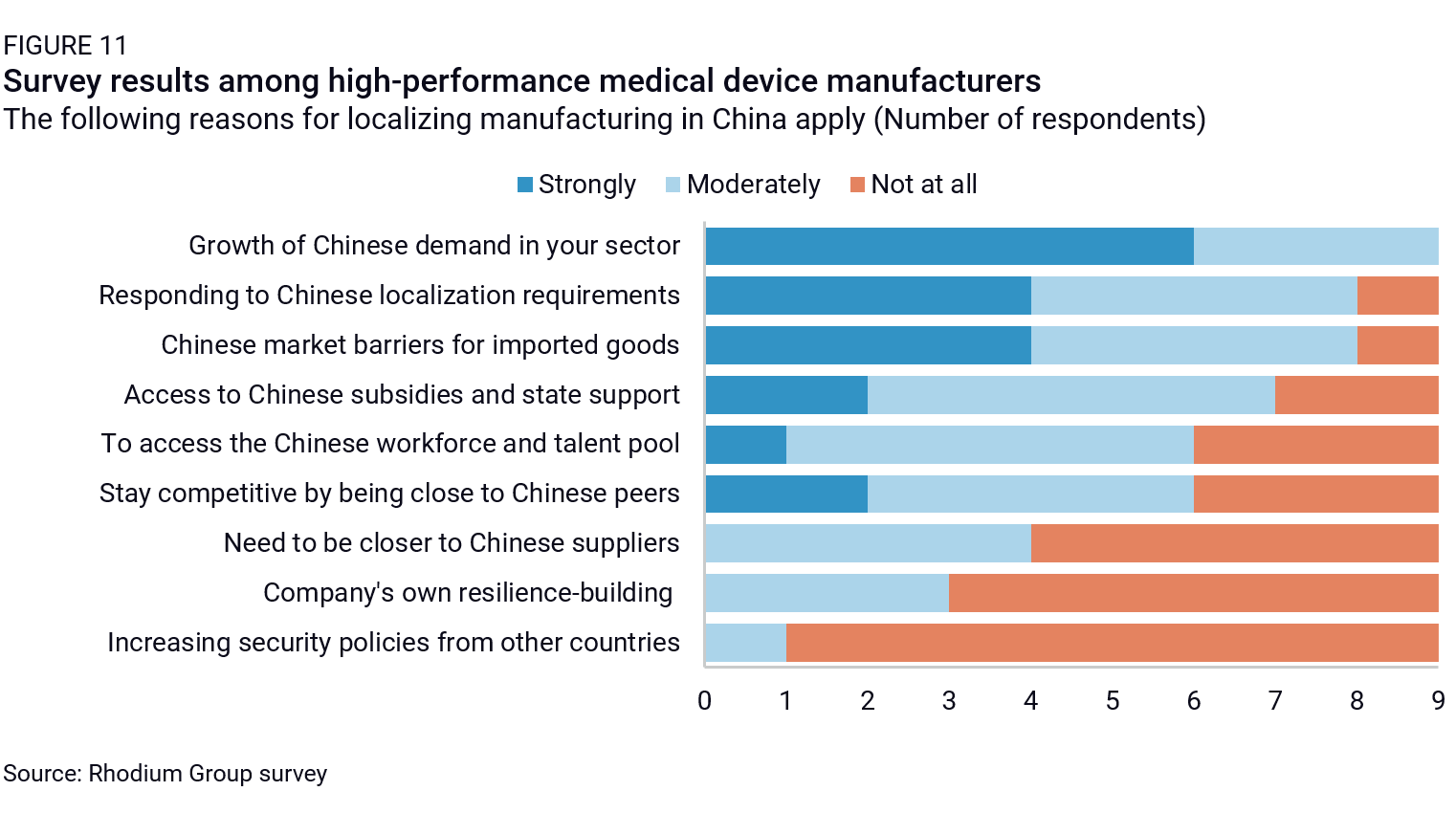
Localization in the aviation and semiconductor sectors
Nonetheless, foreign companies in many sectors have refrained from localizing their most cutting-edge technology in China. Instead, they have focused on investing in legacy technologies or limited activities such as assembly and maintenance, while keeping the manufacturing of key components outside of China.
The aerospace sector is a prime example of refraining from localizing cutting edge technology, due to its sensitivity to export control regulations. For example, the C919’s (China’s first narrow-body airliner) CFM LEAP engine is sourced from a French-US JV that requires a US license. The US aerospace company Rockwell Collins, which has several JVs in China to produce communication and navigation systems, came under scrutiny for sending technical data to China to have electronic components made there. As a result of these sensitivities, aerospace companies, many with commercially significant relationships with Western defense agencies, have not localized manufacturing to the extent that high-speed rail companies had in the 2000s. Airbus’s operations in China focus primarily on the final assembly and completion of aircraft rather than high-tech manufacturing.15 Boeing’s approach is even more cautious, primarily focusing on completion work and delivery of narrowbody aircraft, with 100% of its aircraft assembly and 80% of its supplier spending in the United States. Other joint venture operations focus primarily on maintenance and installation. For example, Safran’s joint venture with China Eastern Airlines, established in 2017, focuses on the maintenance and repair of landing gear. In another example, Parker FACRI, a joint venture between Parker Aerospace and AVIC established in 2016, offers final assembly and testing for aircraft flight control actuation system components.
Semiconductors present another example of both the achievements and limits of foreign localization. China received a large proportion of investment in the semiconductor industry in the past decade, averaging around 40% of industry FDI annually between 2013 to 2019. South Korean-owned DRAM and NAND memory chip fabs, in particular, have significantly expanded their capacity since 2015, contributing to reducing China’s reliance on imports in that area (Figure 12). Samsung’s state-of-the-art plant in Xi’an, opened in 2019, accounts for 40% of its NAND business and represents the world’s largest NAND manufacturing base. SK Hynix’s Wuxi factory, opened in 2006, is responsible for about half of the company’s DRAM production. These investments played a key role in reducing China’s reliance on imports of memory chips, as around 62% of China’s memory chip production is owned by South Korean firms.16
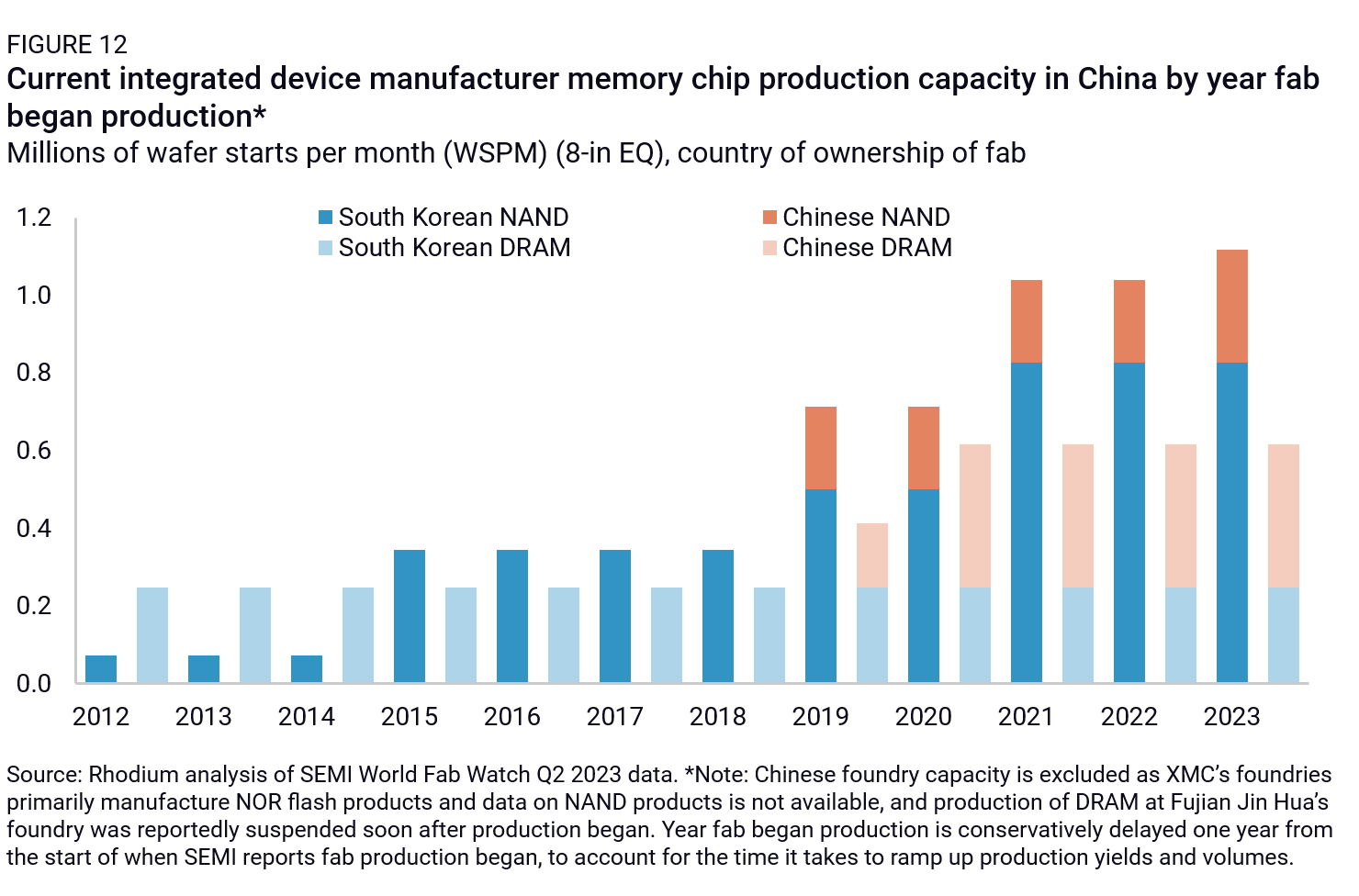
However, foreign logic chip producers in China, including TSMC and UMC, have localized much less of their production in China and do not manufacture their most advanced logic chips there (Figure 13). Due to growing geopolitical tensions around semiconductor manufacturing, Korean memory chipmakers are also walking back from their China-focused strategy and investing in their newer fabs and research centers at home.
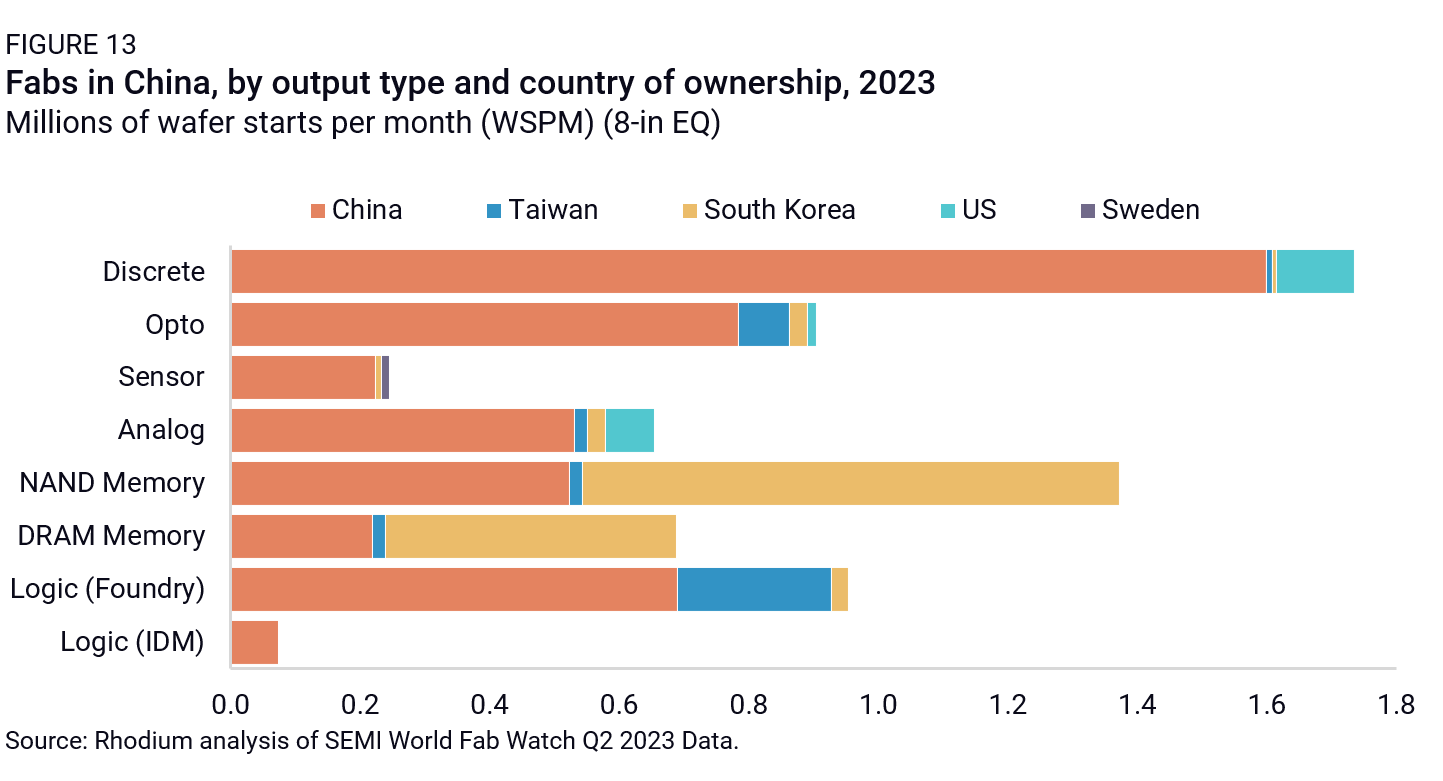
Achievements in reducing import dependencies
Fueled by advancements from domestic firms and the localization efforts of foreign companies, every sector targeted by MIC25 has seen substantial reductions in import dependencies. Nonetheless, vulnerabilities persist, as China’s drive for industrial upgrades has paradoxically increased its demand for highly specialized imported technologies in discrete areas.
Aggregate picture
Aggregate data reflect China’s declining import dependencies. To assess this at an aggregate level, we use a proxy—specifically, the share of HS-6 codes in key sectors where China’s imports are double its exports, given that data on direct import demand is often unavailable.17 For a major exporting country like China, this proxy identifies areas where domestic production still lags behind imported goods.
According to this measure, China has made broad progress in reducing import dependencies (Figure 14). While in some sectors, the most significant gains were achieved before the launch of MIC25, import dependencies have continued to decline across most sectors since 2015. In sectors like rail and power generation, import dependencies have been virtually eliminated. For example, imports of rail bogies—a product China still relied on imports for in 2015—decreased from $70 million in 2015 to just $1.4 million in 2023.
However, progress has been slower in other areas. In the biotech and medical device sector, the dependency rate only slightly decreased from 39% in 2015 to 38% in 2023. Similarly, in aerospace, it declined marginally from 41% to 40% over the same period. Advanced electronics have seen moderate improvements, with the dependency share falling from 30% in 2015 to 22% in 2023.
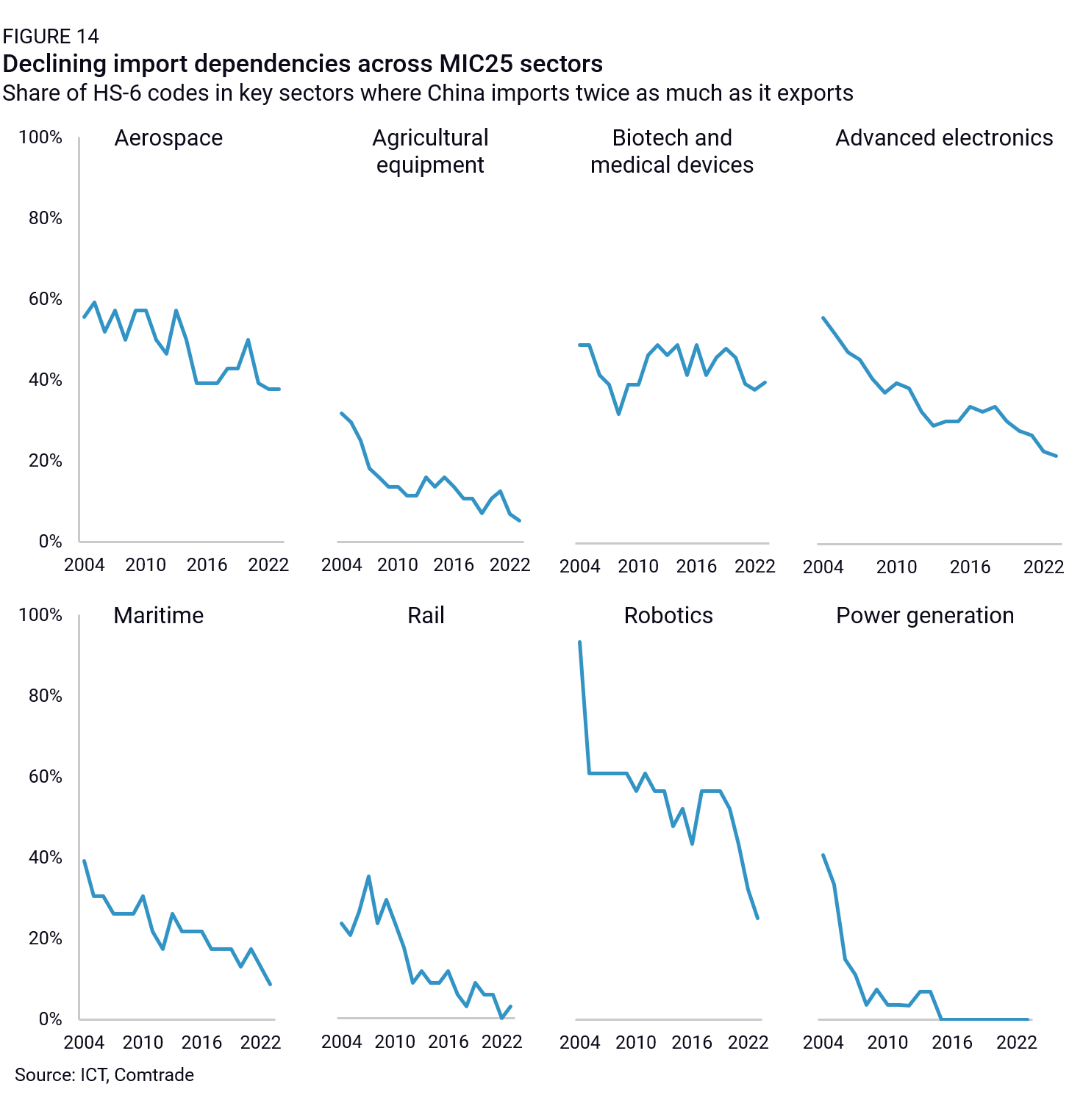
Despite China’s strides in reducing import dependencies, its drive for industrial upgrading has also led to an increased demand for technologically advanced products. Over the past decade, while high-tech exports rose significantly from approximately $650 billion in 2015 to around $850 billion in 2023, high-tech imports have kept pace, growing from $550 billion to $690 billion over the same period and limiting the growth of China’s high-tech trade surplus from $100 billion to $160 billion during the same period (Figure 15). Due to those growing imports, the share of value-added coming from the OECD and embodied in China’s final demand across major manufacturing sectors has increased from 2015 to 2020, the most recent data available, for most sectors except electronics and other transport equipment, which includes ships and airplanes (Figure 16).
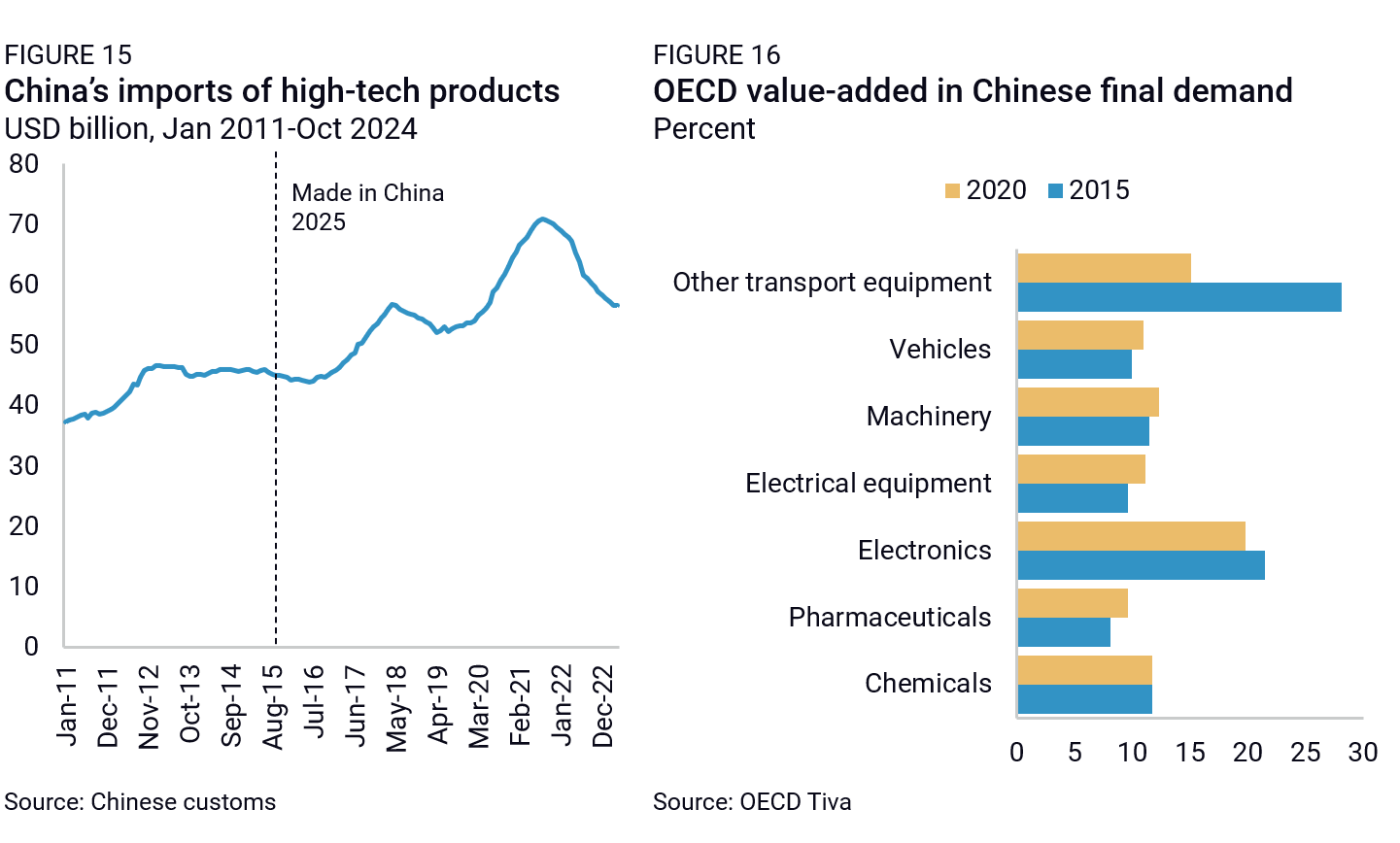
Evaluation of MIC25 targets at the sectoral level
Sectoral achievements illustrate China’s overall progress in meeting its localization targets. China has successfully reached many of its “Made in China” goals in areas like mobile communication equipment—including optical transmission systems, optical switches, and core routers—as well as in power generation, transmission equipment, and agricultural machinery. Partial progress has been made in sectors like high-performance computing, where China remains reliant on imported CPUs, and in medical devices, where import vulnerabilities persist. In the advanced materials sector, however, the lack of sufficiently detailed trade data makes it difficult to accurately assess import dependencies (Table 6).
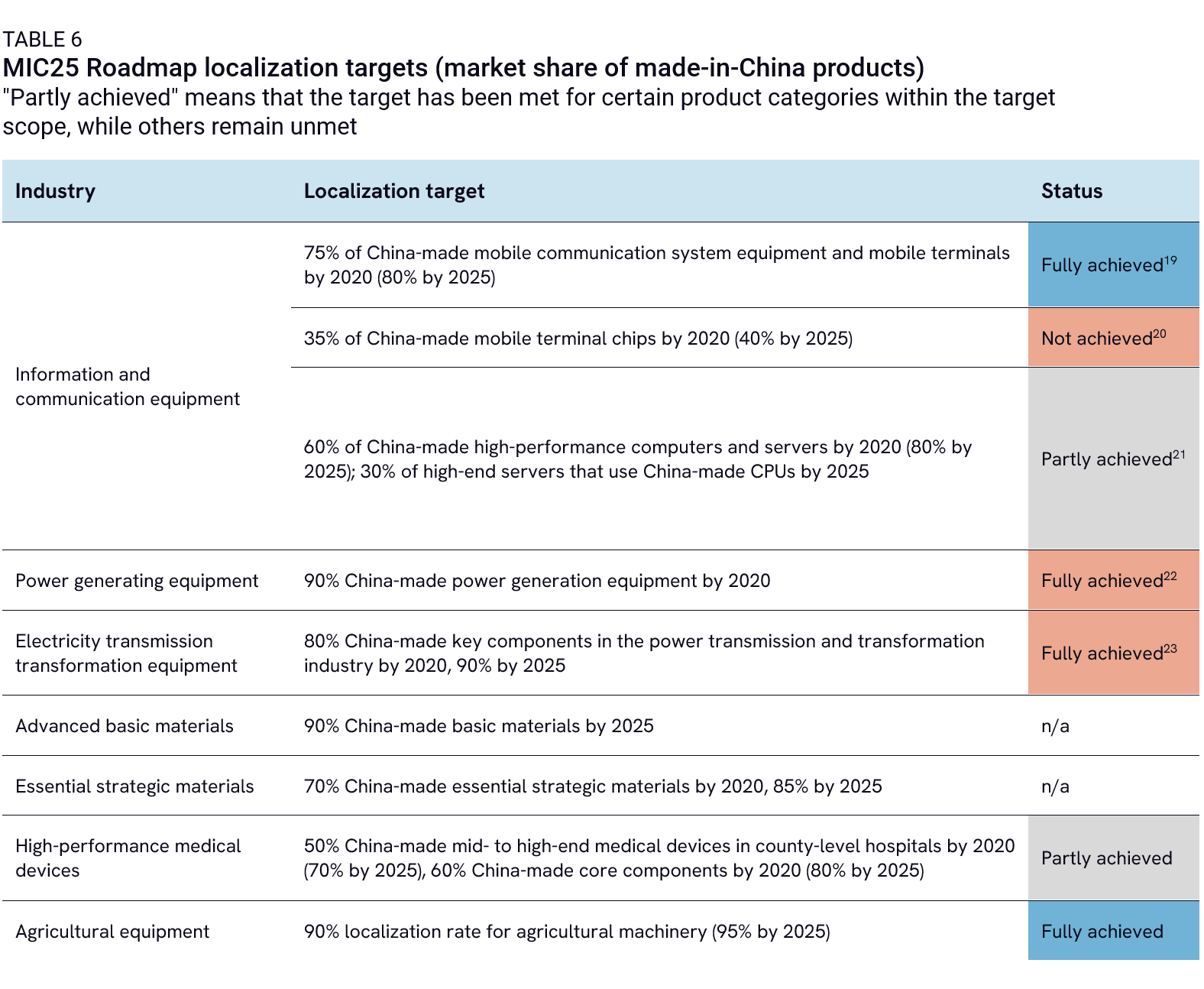
China set very high made-in-China targets (90% and 95% for 2020 and 2025, respectively) for the agricultural machinery sector. According to Chinese reports, while China had already reached a localization rate of 96% for tractors with 100 horsepower or less as of 2019, only 17% of tractors with 200 horsepower or more were domestically produced. In 2022, China still imported 90% of its harvesting products that exceed 250 horsepower and 90% of its core components of intelligent agricultural machinery control equipment. That proportion fell to 80% of imported high-end agricultural machinery in 2024. Overall, China was able to satisfy around 90% of domestic demand as of 2023, close to the goal it had set. A different set of data reveals further progress: the share of agricultural machinery imports relative to the total market size (based on industry reports) has decreased significantly, from 7% in 2016 to 3% in 2023 (Figure 17).
The localization targets for the medical device sector were somewhat less ambitious, reflecting the industry’s earlier stage of development in China. The MIC25 Roadmap set goals of achieving 70% domestically made mid- to high-end medical devices in county-level hospitals and 80% domestically made core components by 2025. While it is challenging to precisely determine whether these targets have been fully met, the available data indicates both substantial progress as localization pressures intensified, as well as ongoing vulnerabilities. Imports of selected medical device products as a share of the total market size in China decreased from 24% in 2015 to 14% in 2023 (Figure 18).
For a product like computed tomography (CT), although foreign firms roughly had 80% market share in China in 2022, imported products only accounted for about 40% of domestic demand. Absolute imports of CT products decreased by 45% in the past two years after reaching a peak in 2021 (the year Notification 551 declared that China’s government hospitals should be purchasing domestically made CT equipment rather than imports). Imports of ultrasonic scanning apparatus, also on the Notification 551 list, show a very similar pattern, with a 47% decline between 2021 and 2023, even as foreign firms still accounted for 75% of the domestic market in 2022. This pattern is consistent with the increased localization of foreign firms outlined above. However, China has ramped up its imports of other products, such as X-ray tubes (also used in CT equipment), pacemakers, and apparatus based on the use of alpha, beta, gamma, or other ionizing radiation. Overall, the reliance on imports is still high, though it is rapidly declining and may reach the Roadmap’s targets by 2025.
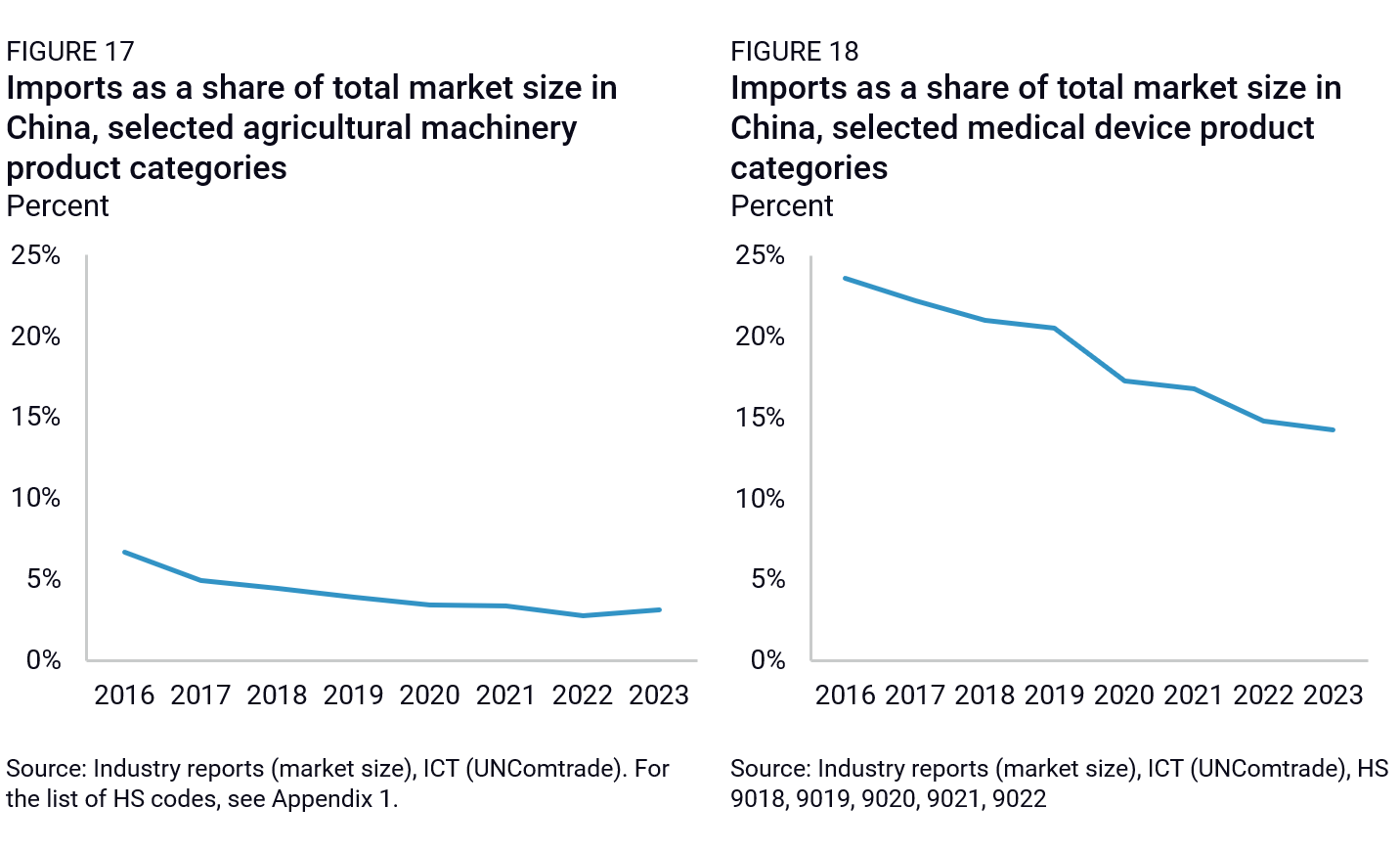
China’s most significant import dependencies on OECD countries continue to be in the chemicals and pharmaceutical sectors, as well as in high-end machinery and instruments (Table 7). In most of these products, Chinese imports have grown more than twofold since 2015. For example, China’s imports of semiconductor manufacturing equipment have more than tripled over that period. Dutch firm ASML remains the sole supplier of the industry’s most advanced EUV lithography machines and controls about 90% of the market for less advanced immersion deep ultraviolet machines, which are not produced in China. China also depends on imports for electron microscopes, dominated by foreign firms like Thermo Fisher, Zeiss, Hitachi, and JEOL, and where imports have almost quadrupled since 2015. Many kinds of inorganic and organic chemicals, including fluorines, oxides, and borates, also continue to be exported to China rather than produced locally.
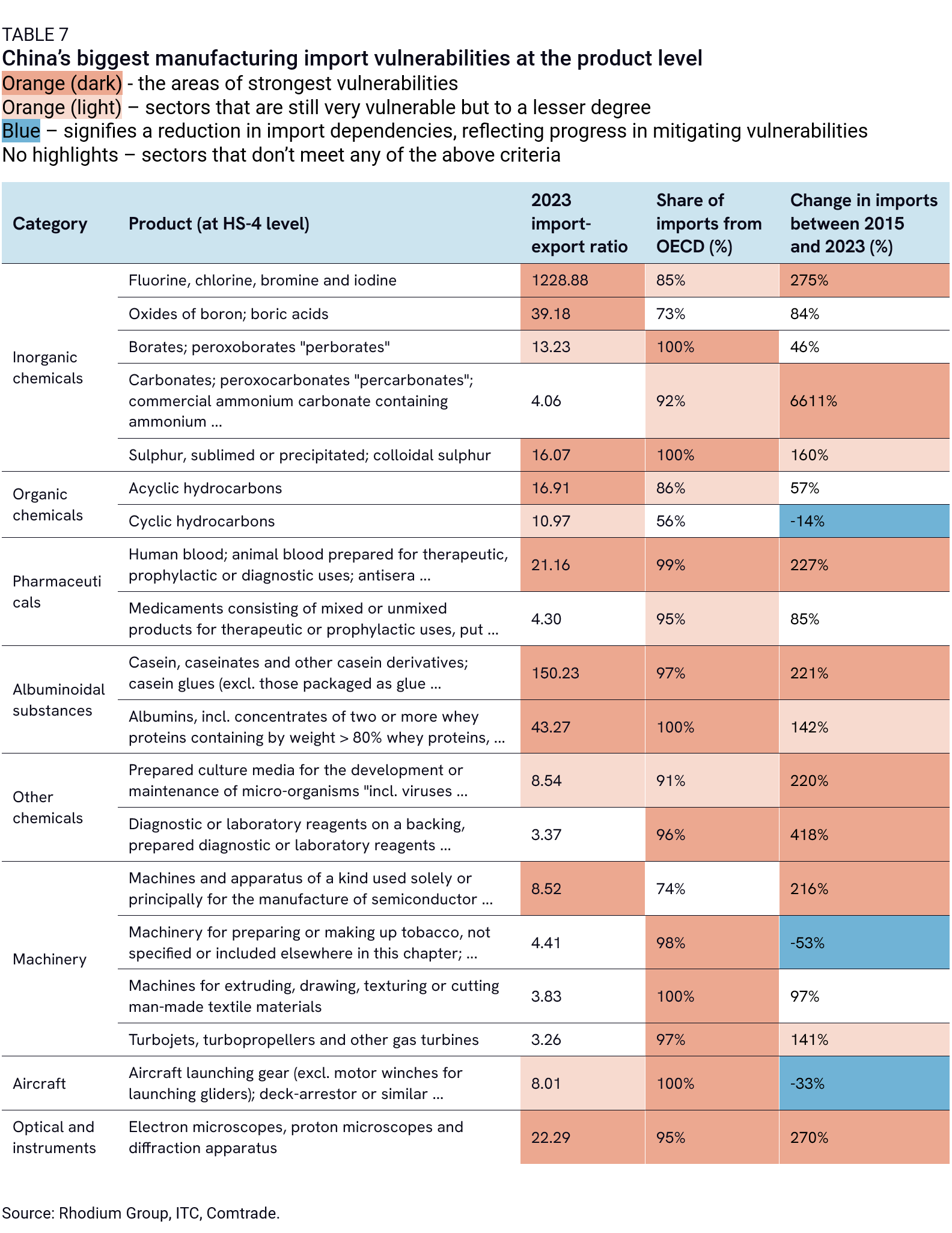
Net assessment
China has had its strongest achievements in reducing import dependencies. This is not surprising: it is the first step in China’s multi-pronged industrial policy strategy, as outlined in Chapter 1. However, significant vulnerabilities persist, particularly in sectors that rely on specialized, high-tech components where domestic capabilities are still developing.
Looking ahead, it is uncertain if foreign firms will continue to play a major role in addressing these gaps. Geopolitical tensions have increasingly put foreign companies operating in critical sectors under scrutiny, in both their home country and China, making them more cautious about the risks associated with transferring sensitive technologies to China. This shift only heightens the urgency for China to reduce its reliance on foreign firms and build up its own technological capabilities. Indeed, Beijing has emphasized this priority repeatedly in recent years, underscoring the strategic importance of achieving self-sufficiency—frequently characterized in Chinese media as “breaking the foreign chokehold”—in key industries.
Chapter 3: Decreasing dependencies on foreign firms
In addition to reducing import dependencies, another key goal of MIC25 was to decrease reliance on foreign companies, even those with operations in China. Many of the Roadmap’s targets focused specifically on increasing the market share of products made in China by Chinese firms. This represents a narrower measure of self-sufficiency than localization targets, as it excludes products made by MNCs operating within China. For instance, a Philips Healthcare CT machine manufactured in China would contribute to the localization rate but not to the market share of Chinese firms. In contrast, a Mindray electrocardiograph produced domestically would count toward both localization and Chinese firm market share. This chapter evaluates China’s progress in meeting these Chinese company market share targets by drawing on domestic and international industry reports as well as relevant news sources.
Aggregate picture
In many products, Chinese firms have achieved significant successes, sometimes more than doubling their domestic market share in the past decade. For instance, in luminescent detection IVD, a crucial element in medical devices, the market share of domestic companies surged from 10% in 2015 to 25% by 2021. Similarly, carbon fiber, a vital component in the new materials industry, saw its localization rate climb from 18% to an impressive 47% during the same period. For fiber lasers, the localization rate has surged from 29% in 2017 to 65% in 2021. Notably, certain sectors have experienced an accelerated pace of localization over the past two years. For example, in China’s ocean engineering equipment and high-tech ships industry, certain higher-tech products such as marine monitoring system sensors only began to develop quickly in 2021 but achieved 70% localization by 2023.
However, overall, China’s progress in achieving its market share targets—and its progress in reducing reliance on foreign companies more broadly—have been uneven and less striking than its progress in reducing import dependencies. This is not surprising: Foreign companies still account for 17% of industrial enterprise assets in China, 20% of industrial enterprise sales revenues, and 28% of exports, according to data from Chinese Customs and National Bureau of Statistics (Figure 19).18 The asset and sales data is likely overstated because it does not include very small enterprises and service industries, but it likely accurately reflects the importance of foreign companies in the manufacturing sector.
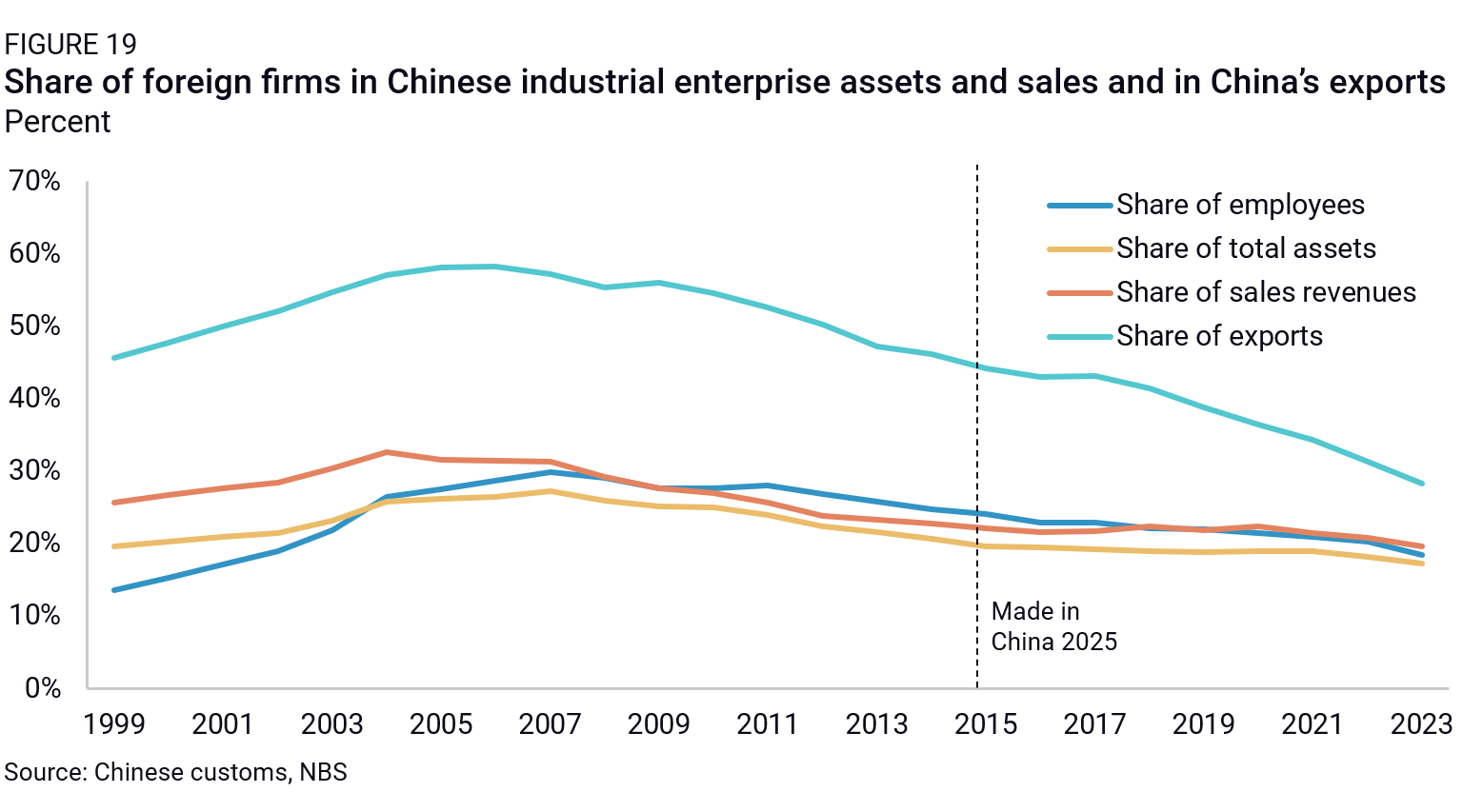
Overall, our assessment suggests that China has achieved some of its market share targets for domestic firms outlined in the Roadmap, particularly in sectors like industrial cloud—where stringent restrictions on foreign participation have given local players an advantage—as well as in new-energy vehicles and power generation equipment, where China has successfully leapfrogged foreign technology. However, in most areas, China has fallen short of its ambitious goals, particularly in sectors such as high-end machine tools, ocean engineering equipment, and commercial aircraft (Table 8).
This shortfall is partly due to the ambitious nature of the Roadmap’s targets but also highlights the challenges faced by domestic firms in catching up with global leaders. Nonetheless, even in industries where Chinese firms have not yet met their market share objectives, industry reports and interviews indicate that the situation is evolving rapidly, with local companies steadily gaining market share at a faster pace.
The momentum is likely to continue in the years to come. Faced with persistent vulnerabilities, Beijing has introduced a flurry of policies in recent years to more aggressively favor domestic firms. This includes, for example, the “Auditing Guidelines for Government Procurement of Imported Products” (Document 551) issued in 2021 as well as many local government procurement policies including “Buy China” clauses since then.19 The recent decline in inbound FDI has prompted renewed assurances to foreign firms that they would be included in procurement incentives as long as they localize their production. Regardless, requirements for the location of IP development, registration, and local content have only become more stringent in recent years. These policies will likely accelerate domestic industry development and reduce reliance on foreign firms in the years to come.
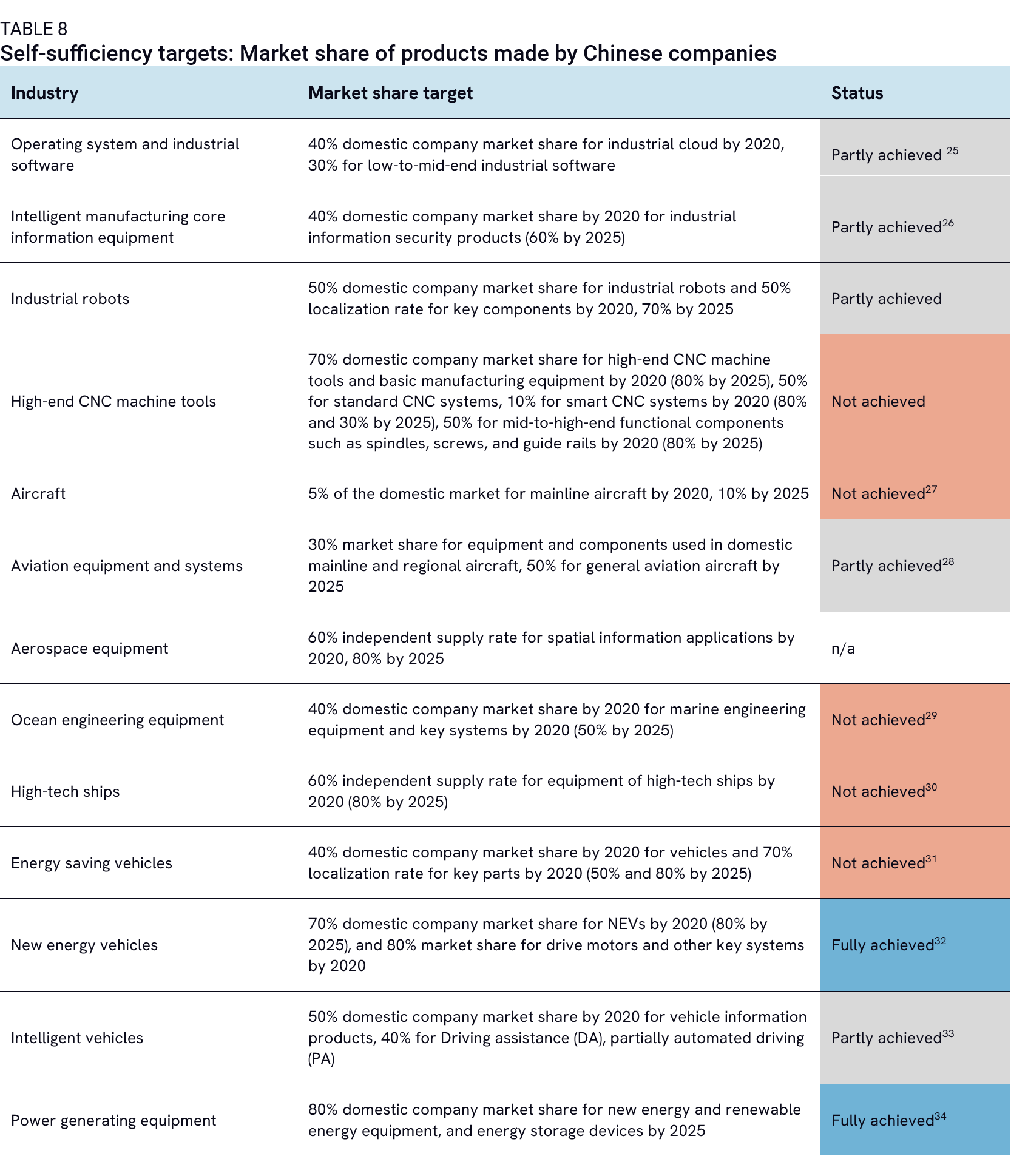
Strongest achievements
Power generation
China has had major success in power generation, and is now almost fully self-sufficient. That said, only a few improvements were made in the past decade, as China had already achieved basic self-sufficiency by 2015.
In civil nuclear power, China was reportedly already 85% self-sufficient by 2017, with the remaining share mainly consisting of general equipment. The country also already enjoyed a uranium enrichment capacity of 5,760 thousand SWU annually by 2017. A notable milestone since then was the development and commissioning of the Hualong One reactor, China’s first domestically designed and constructed third-generation nuclear reactor, which began commercial operations in 2021.
In the wind sector, most of China’s turbine parts were already produced by local companies in 2015, although Chinese manufacturers still relied on foreign suppliers for some important parts, such as megawatt-level speed increaser gearbox bearings, converters, and control systems. At present, though domestic companies have made progress in producing their own bearings, manufacturers still use foreign products for the most high-tech of these components(bearings and gearboxes).
Mixed achievements
Robotics and high-end CNC machine tools
Most areas have seen mixed achievements in increasing domestic companies’ market share in China. Although Chinese companies already widely manufacture low-end products, they are still catching up with foreign players in high-end technologies. For example, the Roadmap outlined a goal of 50% domestic company market share by 2020 and 70% by 2025 in the industrial robot industry. However, Chinese companies’ share of the domestic market was only 18% for heavy 6-axis robots, 34% for light 6-axis robots, and 17% for SCARA robots in 2021 (Figure 20). 70% of China’s market for strain wave reducers (Chinese firm Leader Drive holds over 50% of the strain wave reducer market) and 65% for fiber lasers were captured by domestic brands in 2022.
Nonetheless, the localization process has accelerated rapidly in recent years, and by 2024, domestic companies reportedly surpassed foreign firms in sales for the first time, with their market share rising nearly 20 percentage points in just two years. A recent EUCCC report also found that 33% of foreign high-end machinery and robot firms (more than the average of 29% across MIC25 sectors) faced Chinese competitors capable of producing equal or superior products at comparable or lower prices.14
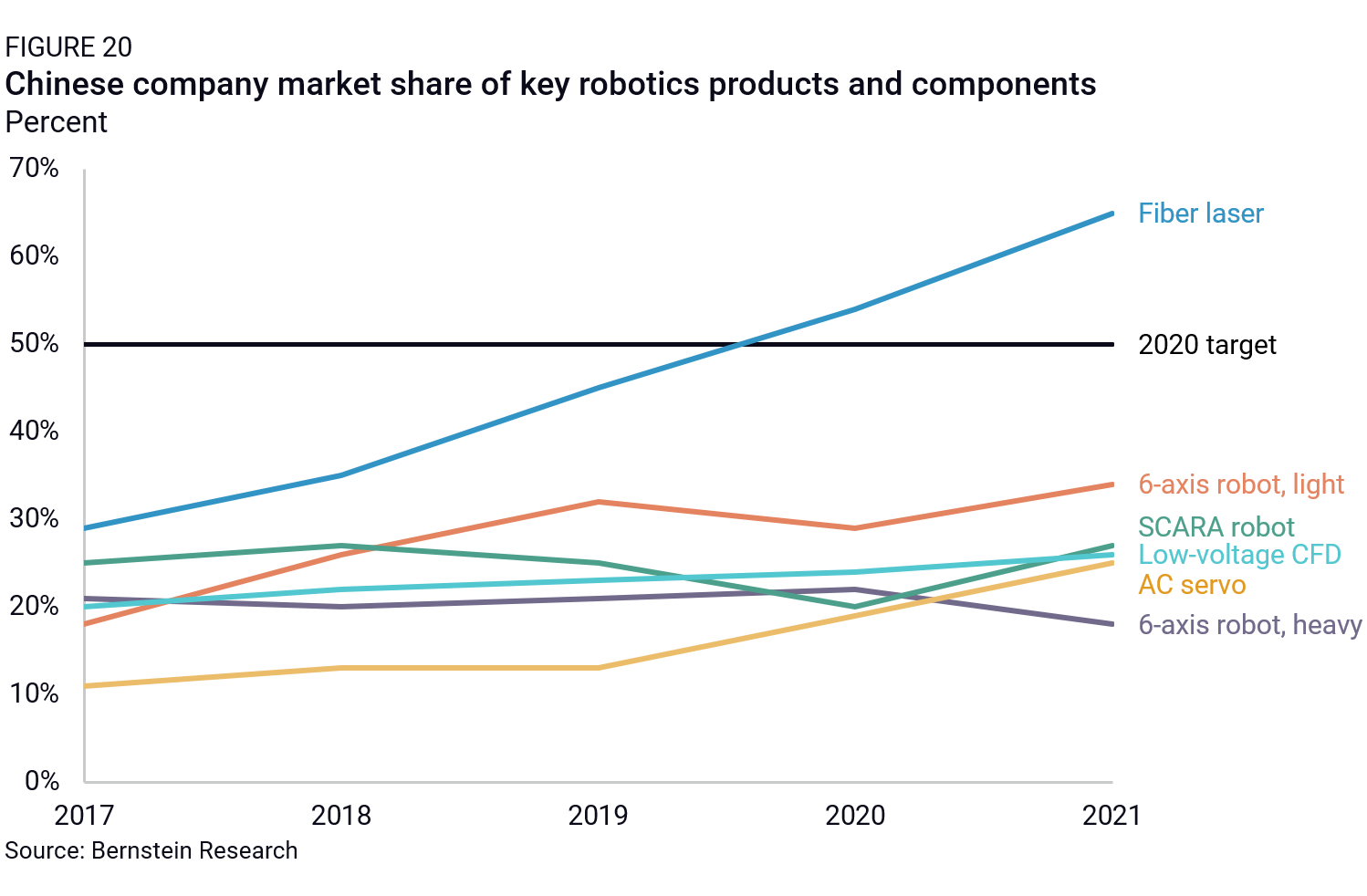
The CNC machine tool industry shows a similar pattern. Instead of the 50% and 70% goals for robotics, high-end CNC machine tools and basic manufacturing equipment targets were set at 70% domestic company market share by 2020 and 80% by 2025. China obtained success in low- to mid-end segments with firms like Haitian Precision but struggles with high-end segments. Among them, domestic low-end CNC machine tools have achieved complete self-sufficiency, and the localization rate of mid-range CNC machine tools has increased from 62.6% to 73.5%. However, for high-end machine tools, Chinese companies only account for some 15%.
Automotive
While China has fallen short of traditional internal combustion engine (ICE) vehicle targets, its extraordinary gains made in EVs largely overshadow that. China’s new energy vehicle (NEV) market has grown from just 3% of the total automotive market in 2015 to 40% in August 2024. Chinese auto companies accounted for almost 52% of the domestic EV market in 2023, up from 35.8% in 2020. In the first eight months of 2024, Chinese firm BYD led the domestic NEV market with almost 35% market share, and the total market with over 15% market share. Chinese EV exports are also strong, with Chinese OEMs already capturing 17% of the ex-China market.
Much of this success was achieved on the back of years of financial support, technology transfer, and strict localization policies that favored domestic players. In the early days of the industry, the Chinese government encouraged foreign investment, but on the condition that multinationals form joint ventures with Chinese firms. This was the case until 2017, when the equity restriction was scrapped. The Chinese government also fostered technology transfers through the acquisition of foreign companies, such as US battery firm A123 Systems in 2013. As the domestic industry matured, Beijing implemented large subsidies programs advantaging domestic battery makers while hindering foreign companies. This was particularly the case between 2015 and 2019, when the “Regulations on the Standards of Automotive Power Battery Industry” were in effect, creating a catalog of recommended suppliers.20 Foreign firms like Tesla were also incentivized to localize production to receive substantial subsidies.
In contrast to the EV industry, Chinese firms still lag in the ICE vehicle segment. Through the first eight months of 2024, foreign firms accounted for around 60% of the total domestic ICE market. However, Chinese brands have quickly expanded exports, particularly in the low-cost market: Chinese ICE vehicle exports grew fivefold between 2020 and 2024. This is partly a result of growing domestic overcapacity in the ICE sector, which has forced Chinese automakers to seek markets abroad. Even with this expansion, the share of Chinese ICE exports has remained flat between 2023 and 2024, at 4.7%.
The divergence in automotive industry outcomes is in part due to varying levels of state support. While included in MIC25, Energy Saving Vehicles—a broad term covering more energy-efficient ICEs and hybrids—has become much less of a government priority over time, while NEVs have gradually emerged as one of the pillar emerging industries that would power future economic growth. This shift reflects broader policy trends, including state efforts to phase out ICE vehicle sales and achieve green development targets, which bolstered NEVs and contributed to the decline of ICE vehicle sales. A prime example in this shift is in 2012, the State Council issued an energy-saving and NEV industry development plan covering 2012-2020; however, in 2020, the State Council only issued an NEV industrial plan running until 2035. The plan only contained a brief mention of energy-saving vehicles.
Outcomes in the auto parts industry are just as diverse. According to Chinese media reports, NEV companies such as Geely and Xiaopeng have increased orders from domestic suppliers to reduce costs and improve development times, thereby accelerating a process of domestic substitution. Chinese OEMs increasingly rely on domestic suppliers for some auto parts such as automotive interior and exterior decoration, automotive glass, and sensors. Over the past three years, sourcing from Chinese suppliers has increased rapidly, for a wide range of components, including very high-tech ones. However, some key technologies within automotive electronics, engine and control systems, as well as automotive active safety are still dominated by multinational companies, as are anti-lock braking systems, for example (Figure 21).
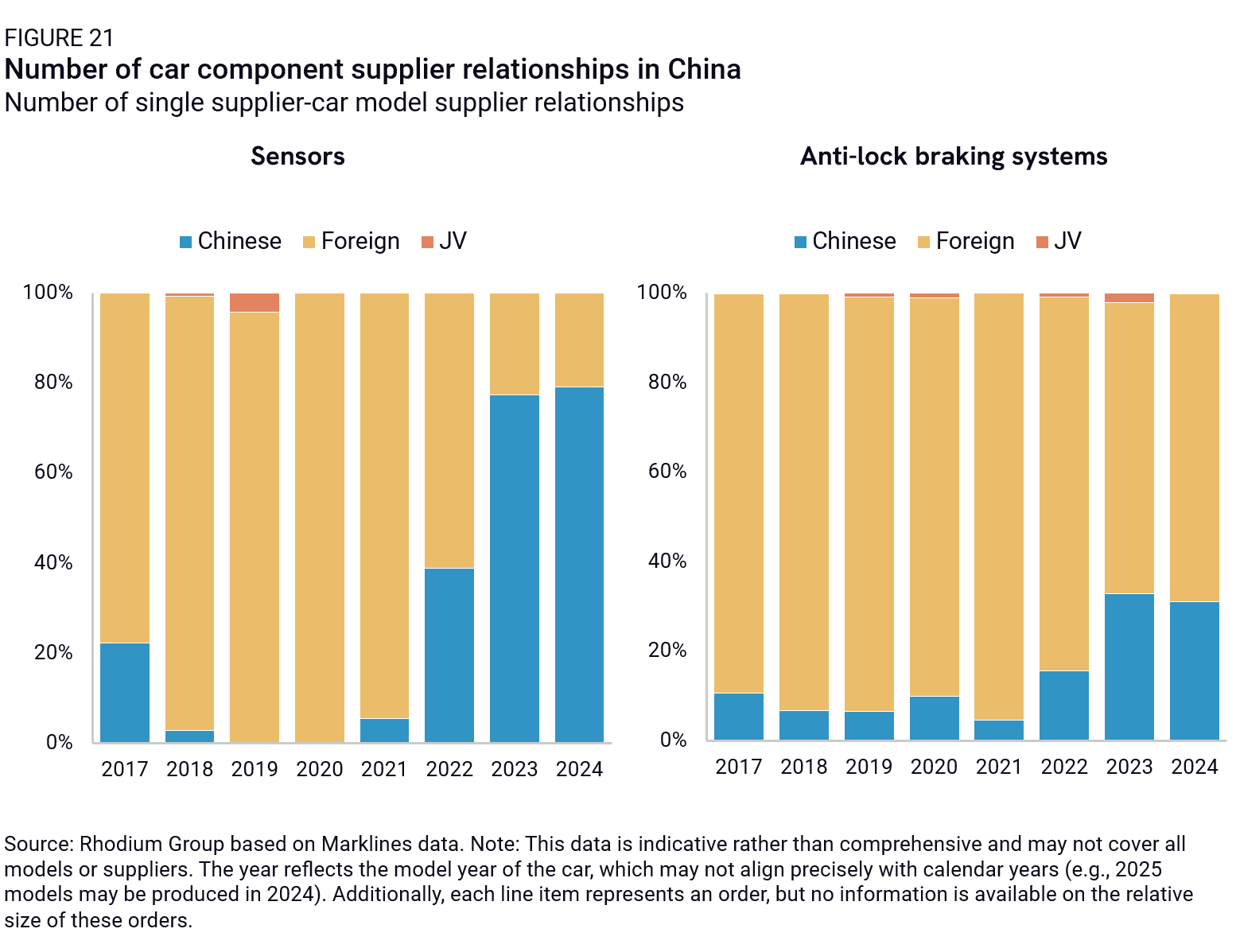
Software
In the industrial cloud segment, Alibaba, Huawei, UFIDA, Tencent and Inspur accounted for 52.2% of the industrial cloud solutions market, with Alibaba holding the largest market share at 26.3% and Huawei the second at 12.5% by 2020. In large part, this is due to market restrictions: foreign firms are not allowed to run cloud services in China without a local partner. MNCs have therefore partnered with domestic companies to offer services through licensing agreements. Amazon partners with Beijing Sinnet Technology and Ningxia Western Cloud Data Technology, Microsoft partners with 21Vianet, and SAP with China Telecom, however their market shares remain small.
However, China is still dependent on foreign firms in the higher-end segment of industrial software. While China has made gains in the lower-end segments, such as supply chain and resource management software where Chinese players accounted for almost 60% of domestic market share in 2021, China relies on foreign companies for over 90% of R&D industrial software. Looking at more specific categories, the market for computer-aided design (CAD) is dominated by foreign firms such as Dassault Systems and Siemens who held over 50% of the Chinese market in 2022. ZW Software, the leading Chinese provider had less than 10% of the market.
However, China’s dependence on foreign firms may rapidly decline in the coming years as Beijing intensifies its pressure to drive foreign firms out of the market. Restrictive policies include government mandates for state-owned companies to convert ICT systems to domestic providers by 2027, cybersecurity measures targeting US chip suppliers, soft bans on chip suppliers like Intel and OEMs like Apple, and antitrust investigations challenging the dominance of Google’s Android operating system.
Outstanding vulnerabilities
China’s biggest vulnerabilities, as identified by Chinese reporting, lie in high-end machinery and software (Figure 22). This includes scientific instruments, where Chinese companies account for around 5% of the overall market. In addition to electron microscopes (discussed in Chapter 2), mass spectrometers are another category of scientific instruments where China was heavily reliant on foreign firms as of 2022. Domestic firms held between 10-20% of the market in 2022, with foreign firms such as Thermo Fisher, Agilent and Shimadzu dominating the rest. Oscillators on the other hand fared slightly better at over 50% localization, but most of the progress has been in low-mid end segments. The unit price of an imported oscillator was over RMB 10,000 while the unit price of exported oscillators was around RMB 1,800 in 2020.
Aerospace
Commercial aircraft is one key area where China still has outstanding vulnerabilities and fell far short of its MIC25 targets. The Roadmap outlined that domestic players should account for 5% of the domestic market for mainline aircraft by 2020 and 10% by 2025. Domestic firms were also expected to account for 30% of the domestic market for equipment and components used in domestic mainline and regional aircraft, and 50% for general aviation aircraft by 2025. In practice, COMAC’s C919 only completed its first commercial flight in 2023. As of today, only 16 C919s have been built and only 14 are active (8 purchased by China Eastern Airlines, 2 by Air China, and 2 by China Southern Airlines). Although COMAC reported having received more than a thousand orders, including 100 from Air China, these orders (heavily subsidized and sold at a discounted price) may take many years to materialize. The 2024 interim annual report of Air China, for instance, indicated that only 10 out of 40 new airplanes added in 2025 and another 10 out of 76 added in 2026 were planned to be C919. In the long run, however, the momentum is there for COMAC to become a leading supplier of airplanes within China.
The supply chain of COMAC is even more dependent on foreign companies. According to Chinese sources, by 2022, the C919 was 60% produced indigenously, of which the airframe structure had the highest localization rate. However, a 2020 report by CSIS indicated that American companies accounted for almost three-fifths of the C919’s top suppliers, with another one-third from Europe. Only 14 key suppliers were from China, and seven of those were Chinese-foreign joint ventures. This reliance has changed only marginally as of 2024 (Figure 23). However, this may shift in the coming years, as China has reportedly made progress on a homegrown commercial aviation engine.

Biomedicine
While China has established a dominant position in the world pharmaceutical market, accounting for almost half of global antibiotics exports and roughly 90% of the global supply of inputs needed to make the generic antibiotics, MIC25 targets the higher-end space of biomedicine, particularly biomedicine, where foreign manufacturers still dominate the market.
Unlike in other sectors, the Roadmap does not outline any quantified localization objective but includes targets for the development and commercialization of domestic drugs. By 2020, the goal was for Chinese companies to have 10-20 chemical drugs, 3-5 new traditional Chinese medicines, and 3-5 new biotechnology drugs registered in developed countries such as Europe and the United States. By 2025, the goal was for Chinese companies to develop 20-30 innovative drugs and to pass EU or FDA certification for 5-10 new drugs.
Until recently, progress had been limited. Although Chinese companies have had real successes in biosimilars, they have failed to meet the Roadmap’s 2020 goal for international certifications. Beigene, in partnership with Novartis, was the first Chinese biotech company to get FDA approval in 2019, for its drug Brukinsa. Between 2017 and 2022, several Chinese drugs were rejected by the FDA and only two Chinese innovative biotech drugs were approved for commercialization in the US. As of 2021, only eight Chinese innovative biotech drugs had been approved in China—six of them in 2021. China also remains dependent on imported drugs in several areas. For example, as of mid-2022, China’s market for antimicrobial peptides—a key product in the Roadmap—was made up of 66% imported new drugs, 6% domestic new drugs, and 28% domestic generic drugs. Similarly, the Chinese market for monoclonal antibody drugs, another product targeted by the Roadmap, is still dominated by imported products, accounting for about 80% in 2023.
This is contrast with the broader pharmaceutical industry, where the Roadmap’s target of producing 20-30 domestic innovative drugs by 2025 was already met in 2019. In 2021, the number of domestic innovative drugs approved in China (39) surpassed that of foreign companies (30) for the first time. In 2017, only one of 41 innovative drugs approved in China was made by a domestic company.
China is increasingly positioning itself as an independent innovator in the medical biotech space. Companies like WuXi AppTec have emerged as global leaders, and foreign pharmaceutical firms are increasingly turning to Chinese-developed drugs through licensing and acquisitions. This shift is driven in part by China’s faster regulatory approval process, which allows domestic firms to test innovative treatments more quickly than their Western counterparts.
A clear indicator of this changing dynamic is the evolving nature of mergers, acquisitions, and licensing agreements. What was once a one-way flow of technology from foreign firms to Chinese companies has become increasingly reciprocal. Foreign firms are now actively seeking access to China’s expanding innovation ecosystem by investing in Chinese biotechnology start-ups and licensing their technologies. According to DealForma, less than 5% of large pharmaceutical transactions worth $50 million or more upfront involved Chinese firms in 2020, but by 2024, that share had surged to nearly 30%.
This is likely to accelerate in the coming years. Biomedicine has long development timelines, with extensive product trials and regulatory certification processes. Interviewees emphasized that many products currently in the pipeline will only reach the market in a few years, suggesting that China’s role in biopharmaceutical innovation is just beginning. China’s expanding capabilities in life science AI, exemplified by Chinese firm BioMap’s release of the first life science AI foundation model to achieve more than 100 billion parameters, may further reinforce this trajectory.21
Semiconductors
MIC25 does not have an explicit self-sufficiency target for semiconductors—perhaps reflecting the fact that the industry was still at a relatively early stage of development in 2015. In the semiconductor industry, progress is still limited and the future is uncertain, despite huge political and financial support to the industry. China’s central and local governments have deployed a full range of industrial policy tools, including subsidies, incentives for global chip talent, tax benefits, and funding for basic and applied research.
In the memory segment, China’s memory chip needs were 100% reliant on foreign firms in 2015, with Samsung, SK Hynix, and Micron dominating the market. In the following years, the government launched several state-owned firms to reduce imports such as YMTC for NAND memory and CMXT for DRAM. YMTC was able to advance quickly, becoming a leading company in the memory space. By 2022, China was producing around 10% to 15% of its memory chip demand, leaving the remaining 90% reliant on foreign firms (Figure 24). The share of domestic manufacturers is poised to jump and increasingly challenge their foreign competitors as domestic production capacity expands and prices fall. A 2025 report argued Chinese memory semiconductor firms had already reached parity with their South Korean competitors. Nonetheless, with US equipment sanctions casting a cloud over the future of YMTC and CMXT, some analysts are pessimistic about their ability to keep up. Despite recent breakthroughs, some argue that they remain behind competitors such as Samsung, SK Hynix, and Micron in some areas.
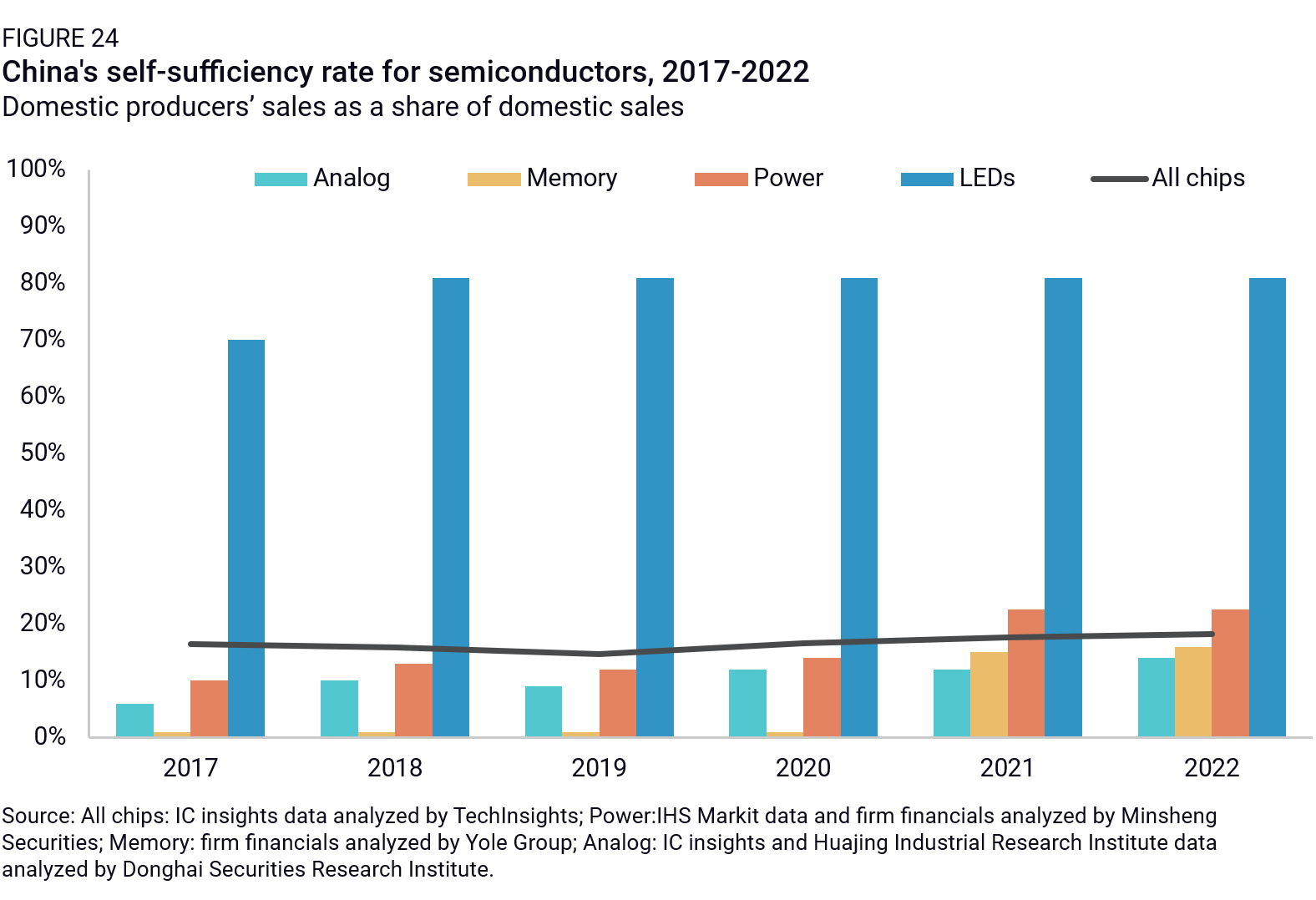
The advanced logic segment concentrated most of Chinese efforts to achieve self-sufficiency, primarily through two key companies. As China’s leading foundry, SMIC has been at the forefront of the country’s push toward advanced logic chip production. The company has succeeded in producing 7nm chips with DUV lithography. However, the company still lags in producing cutting-edge nodes required for high-performance processors and its ability to produce more cutting-edge advanced logic chips will depend on breakthroughs in EUV. Huahong, though ranked as the world’s sixth-largest foundry, only focuses on mature process nodes. In addition, Huawei has emerged as a major player in the high-end chip industry, with its Kirin and Ascend chips making real progress, though it still struggles with production challenges.
Nonetheless, China’s large capacity build-up in legacy chips is challenging foreign companies’ market share. China’s legacy foundries have benefited from soft budget constraints over the past ten years, and their growth has also been carried by a large expansion in electronics demand within China during that time. China’s production capacity has expanded most rapidly in semiconductors manufactured on 20-40nm process nodes, which are very popular for microcontrollers and many low-power IoT chips. As a consequence, survey respondents among foreign integrated circuits and special equipment firms indicated that domestic firms’ market share in China would likely increase to 25-50%, if not 50-75%, by 2030—although these projections do not differentiate between legacy chips and advanced semiconductors (Figure 25).
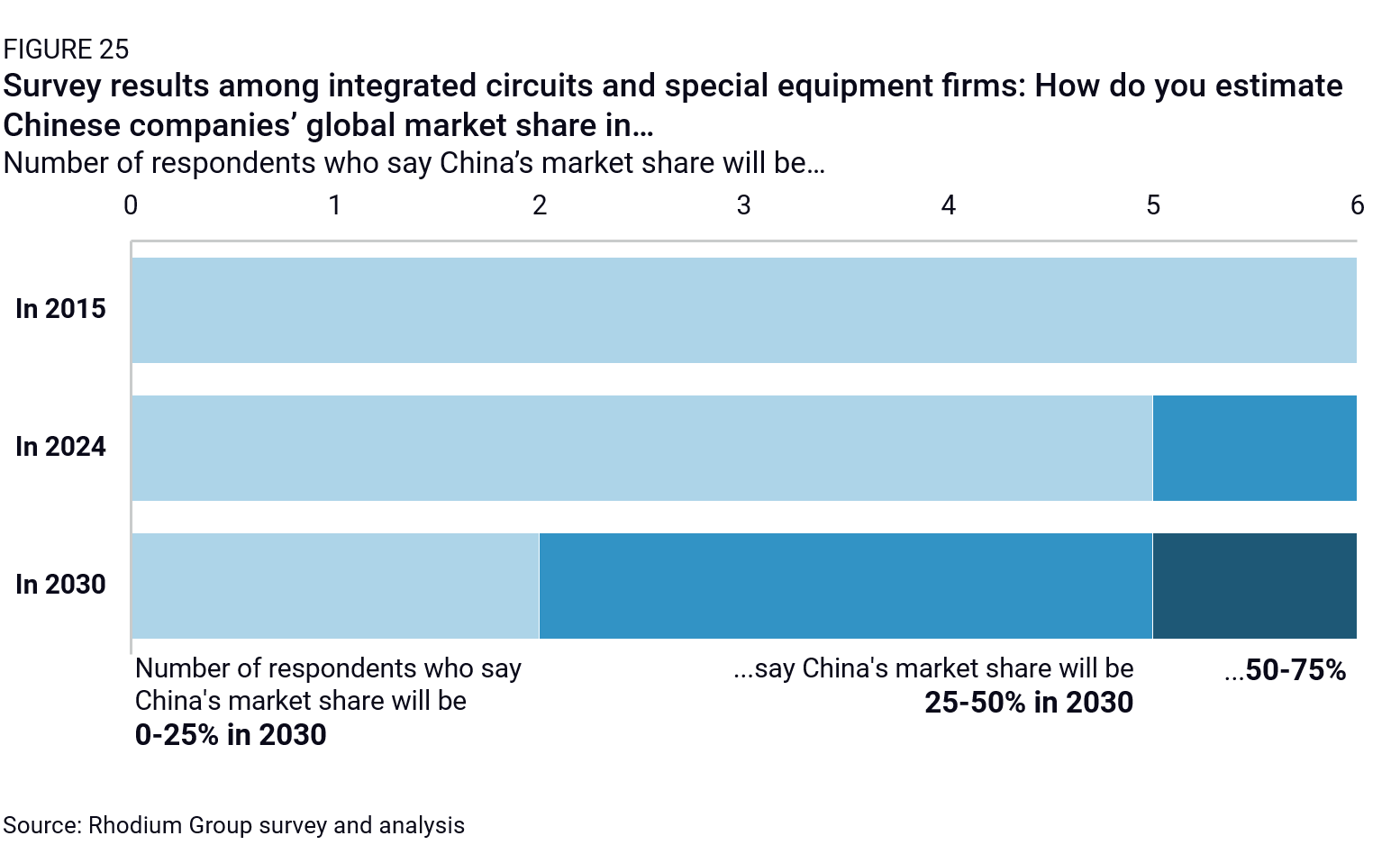
Net assessment
China has made substantial progress in increasing the market share of its domestic firms, particularly in low-tech and mid-tech products. Starting from a relatively low base, it has been able to localize production across various sectors, achieving notable success in areas like software, NEVs, and power generation equipment. In these industries, China has managed to reduce its reliance on foreign companies and has even leapfrogged foreign technology in some cases.
However, despite this progress, China remains dependent on foreign firms for the most advanced technologies in nearly every sector outside of NEVs and power generation. Sectors such as high-end machine tools, semiconductors, and aerospace equipment still rely heavily on imports for their most sophisticated components. In each of these industries, foreign companies continue to dominate the supply of critical technologies, limiting China’s ability to fully localize production.
China’s aggressive push to increase the market share of domestic firms has also led to some unintended consequences. Government pressure on companies to source domestically can inadvertently promote firms that are less competitive or produce products that are merely “good enough.” This can stifle overall industry competitiveness and innovation. In the industrial software sector, for example, where government pressure to wean SOEs off foreign software has been particularly strong, some companies have expressed concerns over the quality of domestic software. Similarly, policies mandating the use of domestically produced semiconductors have put Chinese firms in a difficult position. To meet localization quotas, some companies are opting to use local chips only for secondary or backup functions, while continuing to rely on foreign-made chips for mission-critical applications.15
Despite these challenges, the momentum behind China’s push for self-reliance remains strong, particularly as Beijing’s pressure to drive foreign firms out of the domestic market intensifies. As a result, the market share of domestic companies is poised to increase significantly in many high-tech sectors in the coming years, although the most advanced and specialized technologies—such as high-end semiconductors, some cutting-edge medical devices, and aerospace components—will likely remain challenging areas for China to fully localize.
Chapter 4: Chinese firms’ global competitiveness and technological leadership
Another goal of MIC25 was for Chinese companies to achieve global competitiveness, measured either through market share or technological leadership. This represents one of the strategy’s ultimate ambitions: transitioning China from being the “world’s factory” to a global innovation leader and advanced manufacturing powerhouse. Compared to its self-sufficiency goal, Beijing adopted a longer timeline for achieving global competitiveness. While the MIC25 plan aimed for China to reach 70% self-sufficiency in core components and key materials by 2025, it envisioned China being “at the forefront of global manufacturing” and developing “a world-leading technology and industrial system” by 2049, coinciding with the 100th anniversary of the founding of The People’s Republic of China.
Competitiveness achievements are closely tied to progress in self-sufficiency, with similar sectors excelling in both areas—particularly clean technology, EVs, and high-speed rail. Overall, across most MIC25 sectors, Chinese companies still lag behind their foreign counterparts in global revenues, market share, and cutting-edge technologies. However, there are notable exceptions—shipbuilding, drones, and automotives—where Chinese firms have become globally competitive and achieved technological leadership even while relying on some imported components. This is partly because soft budget constraints, subsidies, and implicit state guarantees enabled them to quickly scale up and invest on R&D.
Overall, Chinese firms achieved the greatest growth in their global market shares in sectors that benefited from one or a combination of the following factors: high capital intensity, which Chinese firms could access through state support and large-scale financing, a uniquely large (and often state-supported) demand market, providing a home-field advantage (both informally and in many instances explicitly) and enabling firms to scale quickly; and emerging industries with no established global leader. In such cases, Chinese firms were able to leapfrog competitors by adopting innovative approaches and leveraging state-driven initiatives to close technological gaps rapidly.
There are also exceptions in the other direction, where China has achieved significant self-sufficiency due to policies to prioritize domestic suppliers, but that has not necessarily translated into global competitiveness. For example, in areas like auto antennas and telematics, the focus on local sourcing has built domestic capacity but has not yet produced products that compete effectively in international markets. This indicates that self-sufficiency and import substitution, driven by domestic policy incentives and pressure to prioritize local suppliers, does not automatically translate into global competitiveness.
Measuring competitiveness
There are many measures of competitiveness, and no single definition suffices to capture its complexity. For example, competitiveness can be measured through indicators like global market share, innovation capability, export performance, or firm-level dominance. In China’s case, the Made in China 2025 (MIC25) strategy outlines global market share and innovation capability as the main indicators of competitiveness.
In this chapter, we operationalize global market share in various ways to better capture its dimensions. Given the challenges of obtaining comprehensive data, we triangulate multiple sources and measures, as global market share by product or company is not always available. Specifically, we rely on the following approaches:
- China’s share of global exports, by sector, in aggregate: This measure provides a macro-level view of China’s position in global trade and helps contextualize its performance relative to the sector’s overall size.
- Dominance at the HS-6 product category level: By analyzing the share of HS-6 product categories in which China is dominant, we gain a more granular perspective. This approach has been used in existing research to capture dominance in global markets. This approach is particularly useful for understanding whether, within a broad sector, China has achieved comprehensive dominance across smaller subcategories. An illustrative case is drones: China has achieved dominance in nearly all drone categories. However, because the aggregate sectoral value of the low-altitude economy is still relatively small, this dominance isn’t reflected in the overall sector-level data.
- Global market share data: Whenever possible, we rely on direct global market share data at the product and company level, as detailed in the sector-specific analyses below. This measure is indispensable for evaluating China’s performance against global peers.
- Financial performance of Chinese companies: Given that a significant share of China’s exports is still conducted by foreign firms (as noted in the previous chapter), it is crucial to analyze Chinese companies separately. In this chapter, we examine the number of Chinese firms in the global top 10 by revenues and capacity within each sector. Additionally, we analyze, for a few sectors, how the revenues of leading Chinese firms evolve compared with their global competitors.
To assess technological competitiveness, we rely on a different set of indicators. These include:
- China’s share of global PCT (Patent Cooperation Treaty) patents, which measures innovation output. Although they do not provide a full picture of a nation’s innovation system, patents are considered a useful measure of innovative performance.22 However, patent data can be particularly misleading in China because Chinese officials incentivize domestic patent filings and Chinese companies tend to file many poor-quality patents as a result. We therefore combine domestic patent data with data on patents filed through the Patent Cooperation Treaty (PCT), an international agreement that allows patents to be filed and protected in 148 countries worldwide and typically indicates higher levels of originality and value abroad.
- R&D spending by top 2500 global R&D spenders, using data compiled by the EU R&D Scoreboard.
- Qualitative insights that evaluate how many years behind Chinese firms are in specific technologies compared to global leaders.
Together, these complementary measures help build a comprehensive picture of China’s competitiveness, addressing both aggregate trends and granular sectoral dynamics.
Export shares and global revenues
Export data shows notable progress in China’s global market shares, although it also includes the activities of foreign companies in China, which, as noted in Chapter 2, have increasingly been localized. Between 2015 and 2023, China’s share of global exports increased in all MIC25 sectors except rail, electronics—a sector where diversification and reshoring efforts have been particularly intense in recent years—and medtech, where China’s exports nearly doubled but were still outpaced by global exports (during and in the aftermath of the pandemic).
In most sectors, China’s share of global exports has grown at a faster pace than in other sectors that were not covered by the MIC25 strategy (Figure 26). Growth from 2015 to 2023 has been particularly strong in the power generation and transmission sector, where China’s share of global exports grew from 28% to 40%, and the automotive sector, where China’s share grew from 3% to 9%. China’s global export shares in aerospace and medtech remain less than a quarter of its global export share in all manufactured goods (19%).
China’s expanding share of global exports has further strengthened its already dominant position in global manufacturing trade, with particularly rapid growth since 2019. This surge has been driven in part by rising overcapacity, which has fueled an export boom and a sharp increase in the country’s trade surplus. China’s dominance in global trade is likely understated in recent years due to declining export prices. In both 2023 and 2024, the country’s export volume grew more than twice as fast as its export value. Moreover, while China’s share of global electronics exports has declined, its grip on value chains remains strong, as production growth outside of China continues to depend heavily on Chinese-made components.
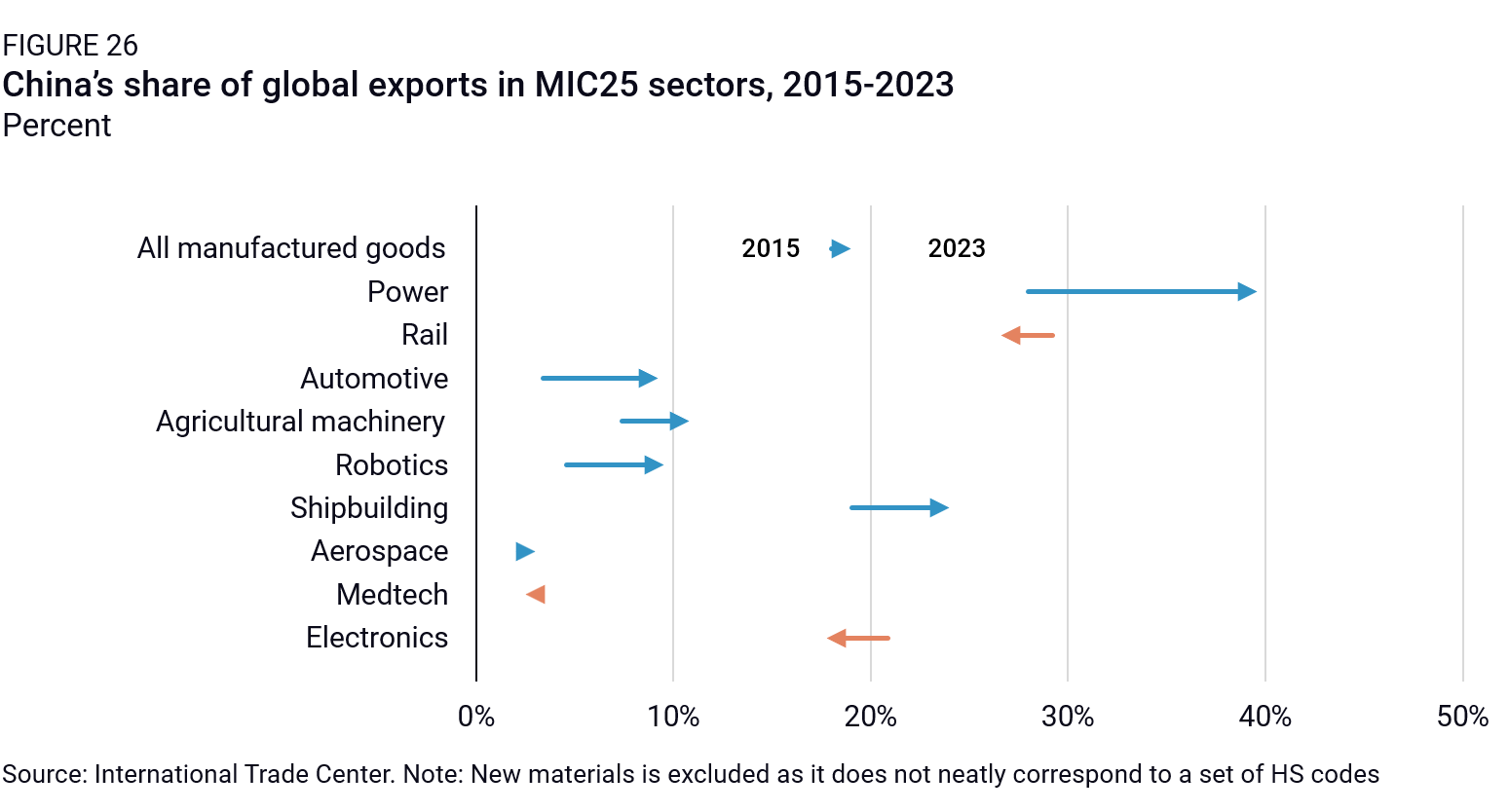
Another way to evaluate China’s global competitiveness in MIC25 sectors is by examining the number of products where China holds a significant share of global exports. The results for this metric align closely with the trends seen in overall global export shares, with one notable exception: aerospace (Figure 27). China is the undisputed global leader in all categories of unmanned aircraft. Robotics and medtech remain sectors with limited Chinese dominance following this metric, although the robotics sector has seen much more progress since 2015, and the consolidated figure for the medtech sector conceals variation within its sub-sectors (e.g., consumable products, implantable devices, and medical equipment). For robotics, China’s share of HS-6 product categories where China holds more than 30% share of global exports rose to 4% in 2023 from 0% in 2015. Agricultural machinery and shipbuilding saw large increases as well, with the share of China-dominated product categories rising to 9% and 14%, respectively. The only decrease in the share of China-dominated product categories were in rail and electronics.
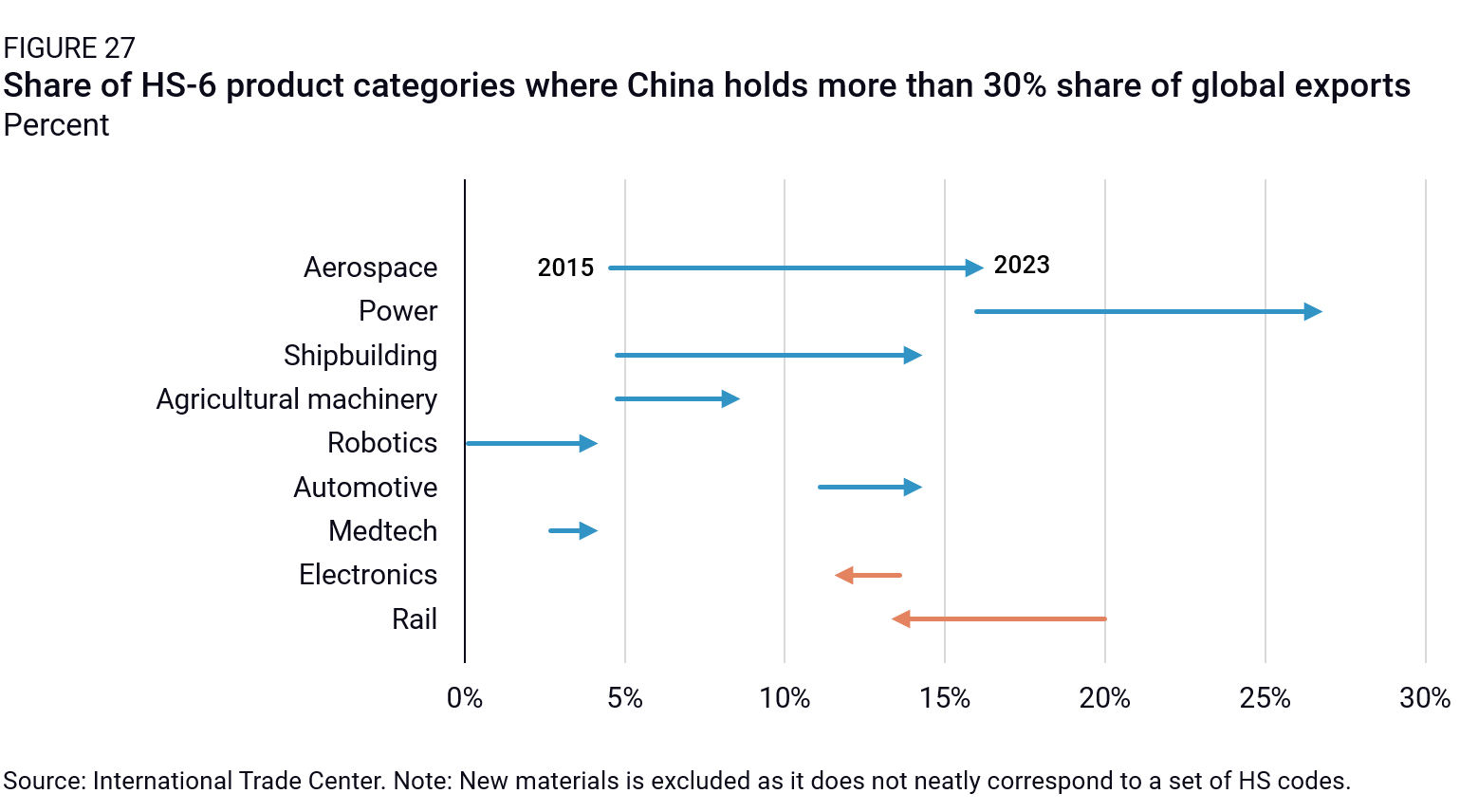
Examining the number of Chinese companies among the global top ten by revenue provides a different perspective. Focusing on narrower industries where firms tend to specialize offers a clearer view of their competitive positioning within specific categories (Figure 28). In clean technologies such as solar panels, EV batteries, and wind turbines, China’s near-monopoly position is clearly reflected in the number of Chinese companies in the top ten. More than eight out of ten of the biggest global solar companies are Chinese, and six of the ten biggest global EV battery and wind turbine companies are Chinese.
In optical transmission and network access equipment, China has long been dominant, with Huawei, ZTE, and Fiberhome among the global top ten. That said, their position has remained largely unchanged over the past decade. In chemicals, Chinese firms have significantly increased their production and revenues. While Sinopec was already among the top ten in 2015, it was later joined by Rongsheng and Wanhua, which specialize in higher-value chemical products. In both the semiconductor and automotive fields, the leading companies as of 2015 (SMIC, Huahong, and SAIC Motors) remained in position but no new Chinese corporate leader joined the top ten. In robotics, China’s position only changed due to MIDEA Group’s acquisition of German manufacturer KUKA in 2016.
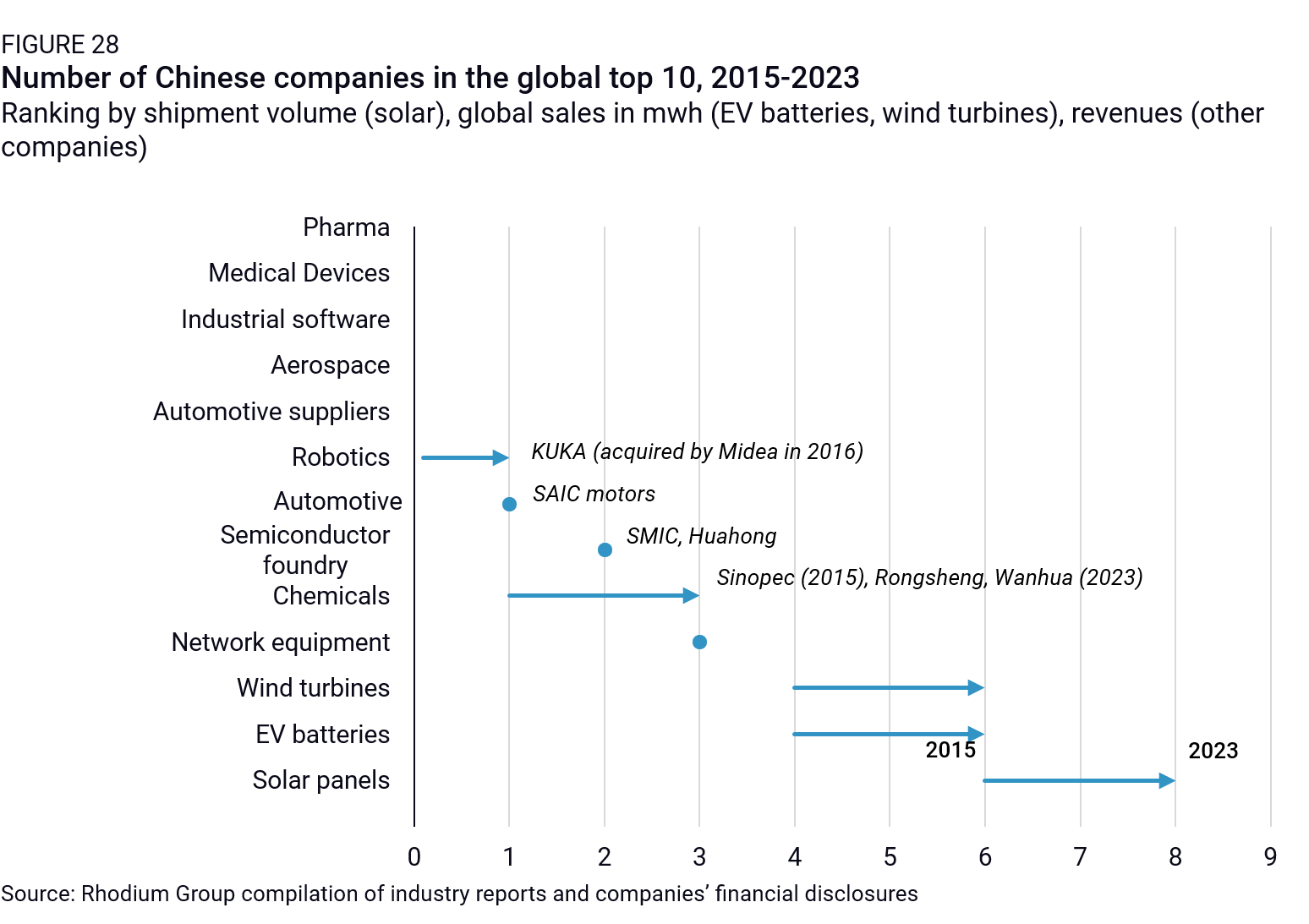
When considering profits—instead of just revenue—of the world’s largest companies, the outlook for China appears even worse. Recent research based on the 2022 Forbes 2000 list shows that US firms accounted for 38% of global profits and led in 20 out of 27 industries. Firms headquartered in US-allied countries generated 35% of global profits, leading in three industries. In contrast, China- and Hong Kong-based firms captured just 16% of global profits, with their earnings largely concentrated in domestically focused sectors such as banking, construction, and insurance—industries with limited geopolitical significance. In high-tech industries, their global profit share was only 6%. This concentration of profits in Western countries suggests that Chinese firms still face significant barriers to entering the most lucrative segments of global industries, particularly in high-tech and innovation-driven sectors.
ICT equipment
China’s growing global export shares and corporate revenues in the ICT equipment highlight the pattern of success identified above, where major successes were achieved in sectors where China has a large demand market and there is no established global leader.
These achievements were driven by strict market access restrictions, which enabled local firms to secure a dominant share of the domestic market. “Buy Chinese” policies in the ICT sector have been implemented since the 1990s, with Beijing selecting five domestic switch manufacturers—Huawei, Datang, ZTE, Julong, and Jinpeng—to replace foreign suppliers in the telecom sector. After the campaign, Huawei rapidly rose to equal Shanghai Bell’s share of about 22% of the domestic switch market. Since then, the tech champion has reportedly received $75 billion in tax breaks, financing, and cheap resources up to 2019, helping its global rise.
By 2015, China was already a major global player in communication equipment, with Huawei ranked among the world’s largest telecommunications equipment manufacturers, holding significant market shares in mobile networks, routers, and base stations.
Building on this strong foundation, China has accelerated the adoption of 5G technology and other high-tech ICT products in recent years. China had installed over 700,000 5G base stations by 2020. This allowed Chinese firms, particularly Huawei and ZTE, to solidify their dominance in the global 5G equipment market, securing major contracts worldwide. The firms held respectively 58% and 31% of market share in China for 5G base stations. Huawei, in particular, expanded its market share, cementing its role as a leading provider of telecom equipment. In 2024, it was the largest equipment manufacturer in the world, with 35% of global market share in 4G & 5G LTE base stations, despite efforts by the US, European, and other governments to limit its influence. As Chinese ICT champions ramped up their capabilities in high-tech products, state support has not declined. On the contrary, between 2021 and 2023, direct government grants to Huawei reportedly more than tripled, reaching RMB 7.3 billion—on top of other forms of state support like loans and equity guarantees.
Automotive
The EV industry is another example of a similar state-led pattern of success. Generous subsidies to consumers reduced the upfront costs of EVs, accelerating demand. At the same time, the government addressed critical barriers to adoption, such as charging infrastructure, by investing heavily in building a nationwide network. By the end of 2022, China had installed more than 5.2 million public and private charging points, making it the largest EV charging network in the world. The results have been staggering. In 2023, China accounted for 58% of the 13.7 million global sales of passenger battery electric vehicles (BEVs) and plug-in hybrid electric vehicles (PHEVs)—five times the size of the US market and seven times that of Germany, the world’s third-largest EV market.
The development of China’s automotive sector has also been underpinned by substantial and sustained government support—far exceeding the level of public subsidies provided to automotive industries in other countries. Government support concentrated on the EV segment in particular, drawing increasing scrutiny abroad. A 2023 EU anti-subsidy investigation into imports of Chinese EVs, for example, substantiated concerns that Chinese state subsidies were distorting competition.
The market was also largely protected from foreign players in the early stages. Foreign OEMs had to enter joint ventures with domestic manufacturers until 2022 to produce in China. Subsidies programs also advantaged domestic battery makers while hindering foreign battery companies, especially between 2015 and 2019 when the “Regulations on the Standards of Automotive Power Battery Industry” were in effect. These regulations created a catalog of recommended EV battery suppliers that met technical standards, but excluded foreign giants such as Samsung, LG, and Panasonic.
Both Chinese EV companies and EV battery makers benefited from this growing state-sponsored, protected demand. By early 2024, Chinese EV makers accounted for 58% of the global market share (Figure 29). Chinese players also account for around 85% of global battery cell production capacity and dominate the global market in key elements of the EV battery value chain such as lithium, cobalt, and graphite processing. Today, Chinese batteries and electric vehicles are regarded by many analysts as technologically ahead of their global peers, reflecting the cumulative impact of years of strategic industrial policy and investment.
In the broader automotive industry, where established leaders from Europe, Japan, South Korea, and the United States were dominant, China’s progress was slower. Chinese automakers (including Volvo, which was acquired by Chinese company Geely) only accounted for 13% of the global market in 2023, up from 7% in 2019 (Figure 30). Nonetheless, China’s ICE vehicle exports have also skyrocketed in recent years, partly due to the growing overcapacity in China’s domestic market.
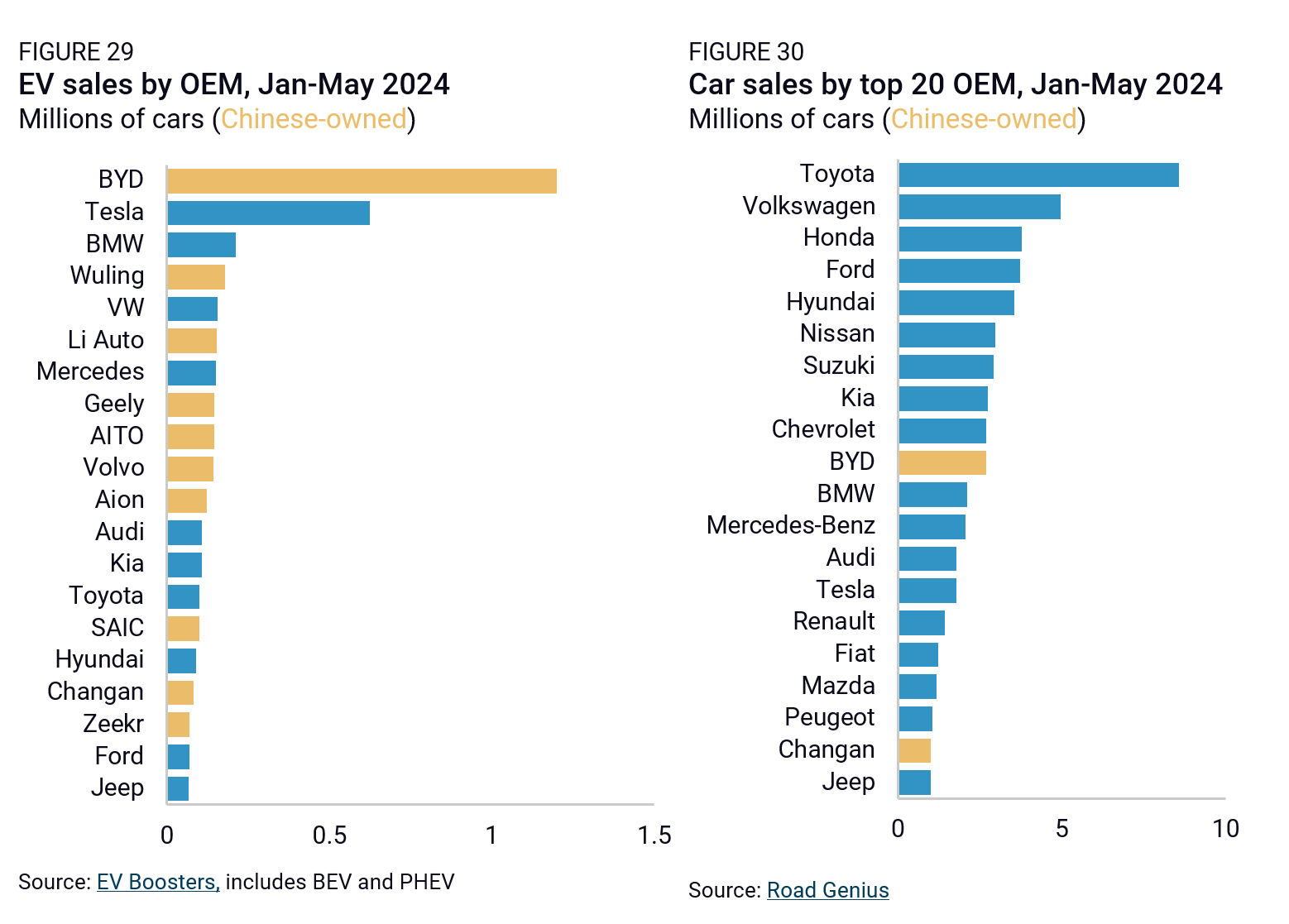
Even in areas where Chinese suppliers now dominate the domestic market, such as telematics and antennas, they have not yet begun to penetrate overseas markets (Figure 31). The same is true of sensors used in cars, where Chinese firms have come to dominate the market (see Chapter 3), but no Chinese firms supplied carmakers producing in Europe and the America in 2023, according to Marklines data. This illustrates that self-sufficiency, driven by domestic policy incentives and pressure to prioritize local suppliers, does not automatically translate—or at least not immediately—into global competitiveness.
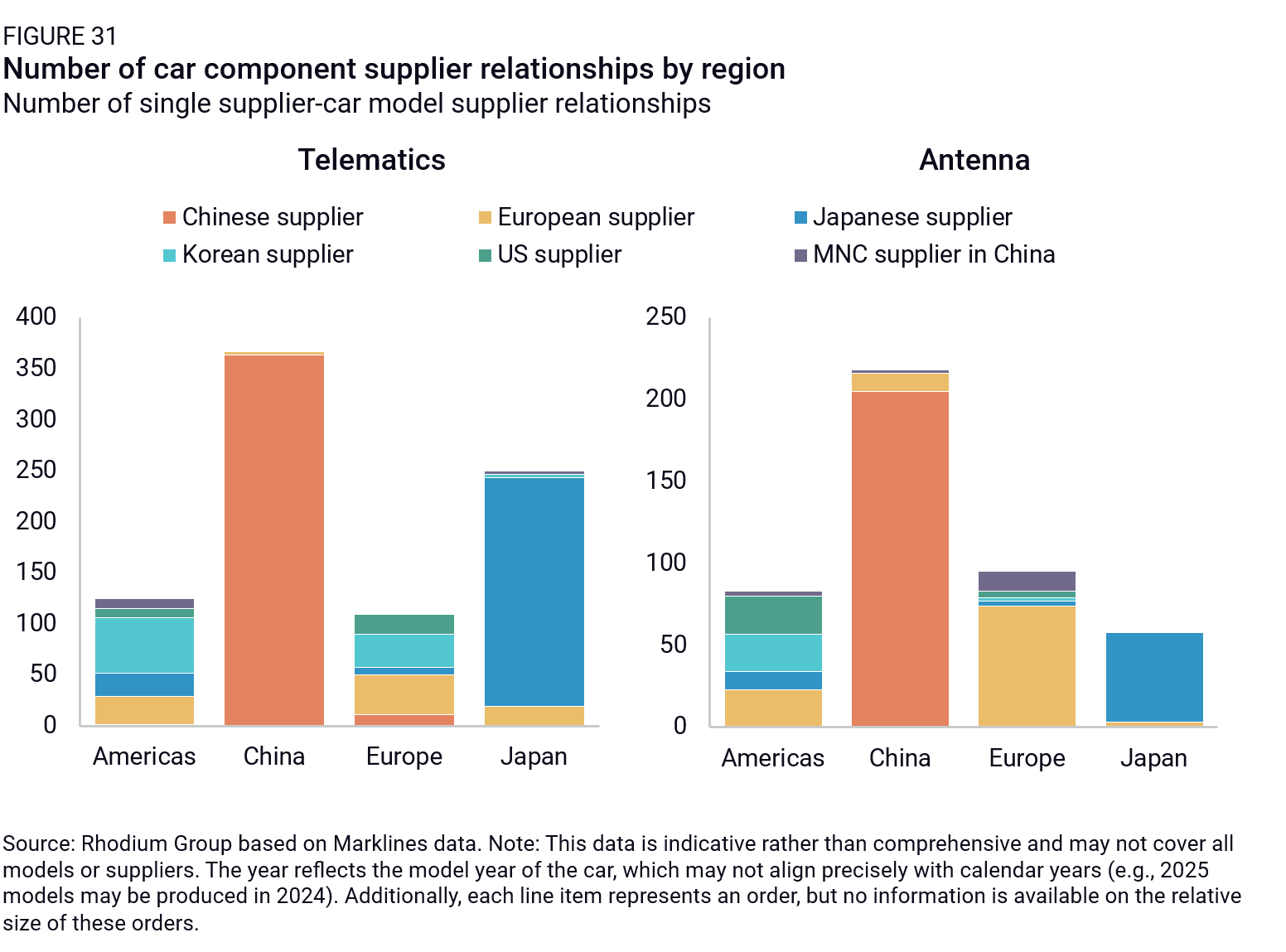
Even so, with rapidly rising market shares or already dominant positions in the domestic market, China is now well positioned to leverage its scale, efficiencies, and innovation to capture global market shares in the coming years to the extent overseas markets remain open to its exports. Moreover, global market share transformations often happen rapidly, as industrial competitiveness reaches a tipping point, and the state provides substantial support for Chinese companies to capture global market share.
For examples, in a few other components such as LiDAR, Chinese companies are already globally competitive. RoboSense, Hesai Technology, and Huawei together account for over 65% of global LiDAR sales. This is a sharp improvement from the situation up to 2018, when the global market was dominated by US companies.
Shipbuilding and aerospace
In some legacy industries, China has achieved remarkable success. Shipbuilding is a prime example. Despite continued reliance on foreign technology for critical components like marine engines and high-end ship design software, China has emerged as the world’s largest shipbuilding country. China has made notable progress in high-tech segments such as liquefied natural gas (LNG) carriers, an area previously dominated by South Korea. China’s share of LNG carriers rose to over 30% in 2024 from only 7% in 2017. China is also dominant in green fuel-powered ships (such as vessels powered with hydrogen fuel cells), where Chinese shipyards have secured 74.7% of global orders in 2024.
Shipbuilding, along with ICT equipment and aerospace, were the three areas where the MIC25 Roadmap set explicit quantified targets for global market share. Most of these targets were achieved, with notable exceptions in mobile terminal chips and aerospace (Table 9). China’s turboprop and helicopter industries have lagged behind global leaders, with Airbus, Bell, Leonardo, and Robinson still making up almost 97% of the global civil aviation helicopter market in 2021.
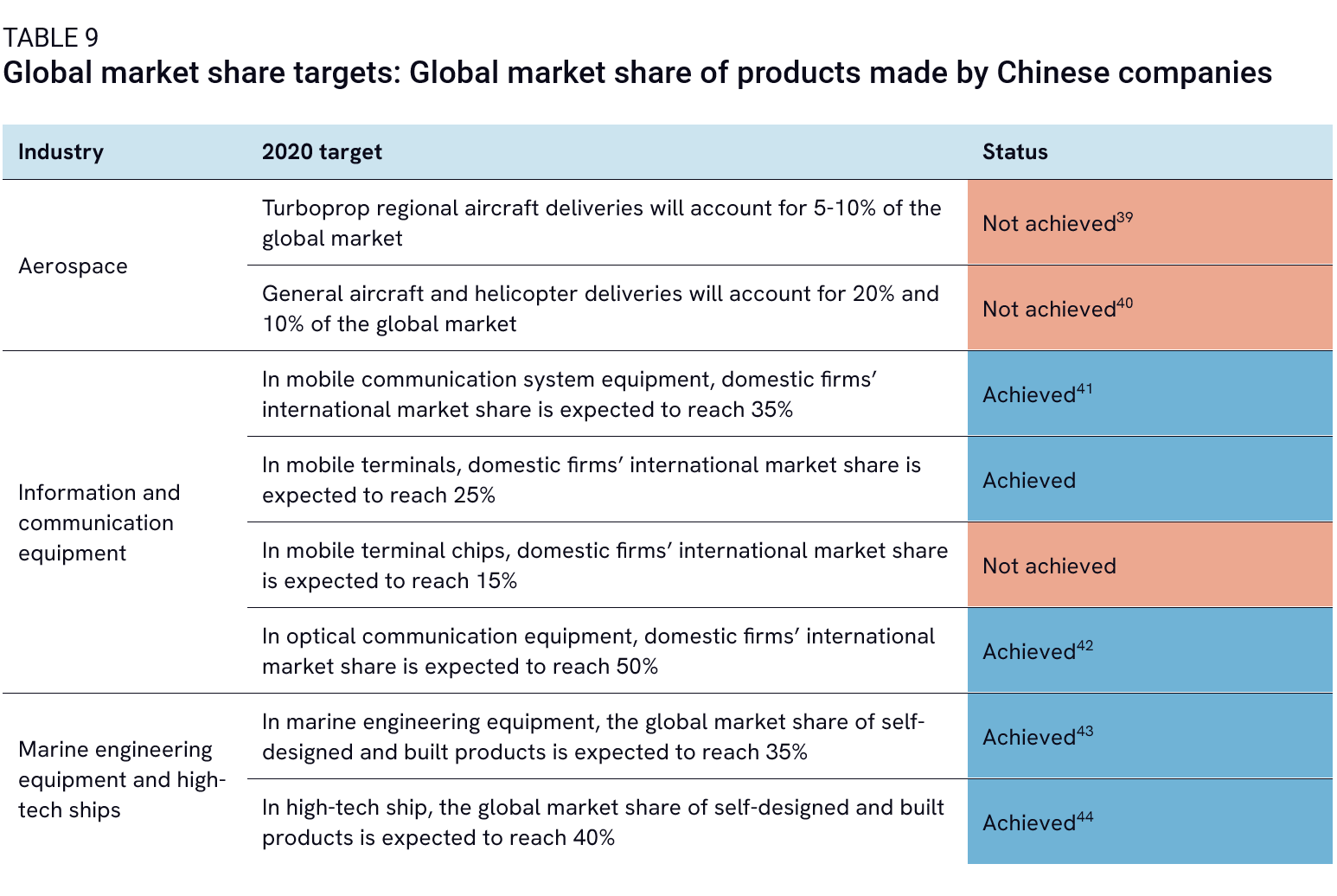
Robotics
In many other legacy industries, competitiveness achievements have been limited, although the landscape is changing rapidly. Robotics is a notable example. While China has made impressive strides in robot installations and density, driven largely by substantial demand-side subsidies, these advances have not translated into significant global competitiveness for local companies, though recent progress suggests Chinese firms may begin displacing established competitors in certain segments. In 2023, China reached a robot density of 470 robots per 10,000 workers—more than double its 2019 figure—securing the third global position after South Korea and Singapore. According to a 2019 report by the Information Technology and Innovation Foundation, China provides greater subsidies for robot adoption than any other country, both in absolute and per-robot terms.
However, unlike in the EV and 5G sectors, this large-scale, state-led demand boost has yielded limited outcomes for domestic firms in terms of competitiveness. This is likely due to the dominance of established international leaders and the high technological complexity of robotics, which have made it challenging for Chinese companies to close the gap in innovation and market leadership. The industrial robotics manufacturing industry, in particular, is highly concentrated, with few dominant players. The largest Japanese firms (Yaskawa, FANUC, Kawasaki Heavy Industries, Seiko Epson, Nachi-Fujikoshi, and Yamaha) together comprise around 50% of global market share, while the largest European firms (ABB, KUKA,23 Stäubli, and Comau) accounting for another 32%. China’s market share jumped with MIDEA Group’s 2016 acquisition of German company KUKA, which accounts for 12.1% of the global market.
The weakness of leading Chinese robotics manufacturers is reflected by the small size of their combined revenues compared to global leaders ABB and FANUC (Figure 32). Between 2017 and 2023, the combined revenues of Chinese manufacturers Create Century Intelligent Equipment, Qinchuan Machine Tool, Haitian Precision, Estun, Ecovacs, and Siasun grew by 84%. Put together, they still only brought in 15% of ABB’s 2023 revenue.
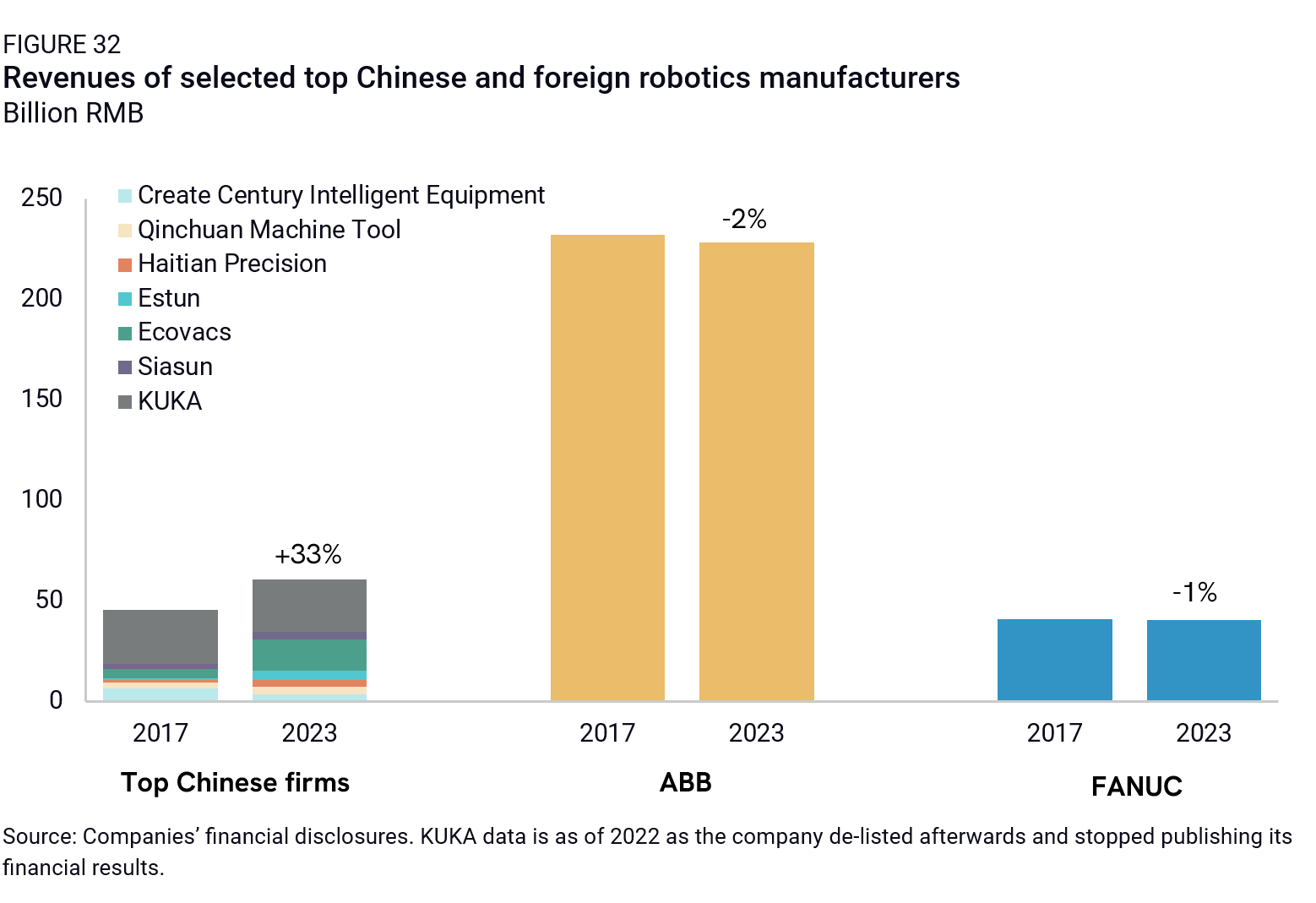
However, China’s competitiveness in robotics is steadily improving, with domestic firms capturing a growing share of the domestic market. As Chinese firms benefit from synergies across the broader ecosystem—including AI advancements, expanding component manufacturing capabilities, and strong policy support—China’s trajectory in robotics in the coming years is likely to mirror that of other MIC25 sectors, where early weaknesses have given way to rapid catch-up and growing global influence.
Medical devices
China has made some progress in medtech categories, particularly at the lower end, but overall is only at the very beginning of its intended journey toward global leadership. As of 2023, medtech exports from China were only a fraction of global medtech exports, at 5.6% compared to 20.3% from the US and 22.3% from the EU (Figure 33). Chinese exports are also more dominant in volume terms, indicating leadership in lower-value and highly price-competitive products (including possibly those made by MNCs in China).
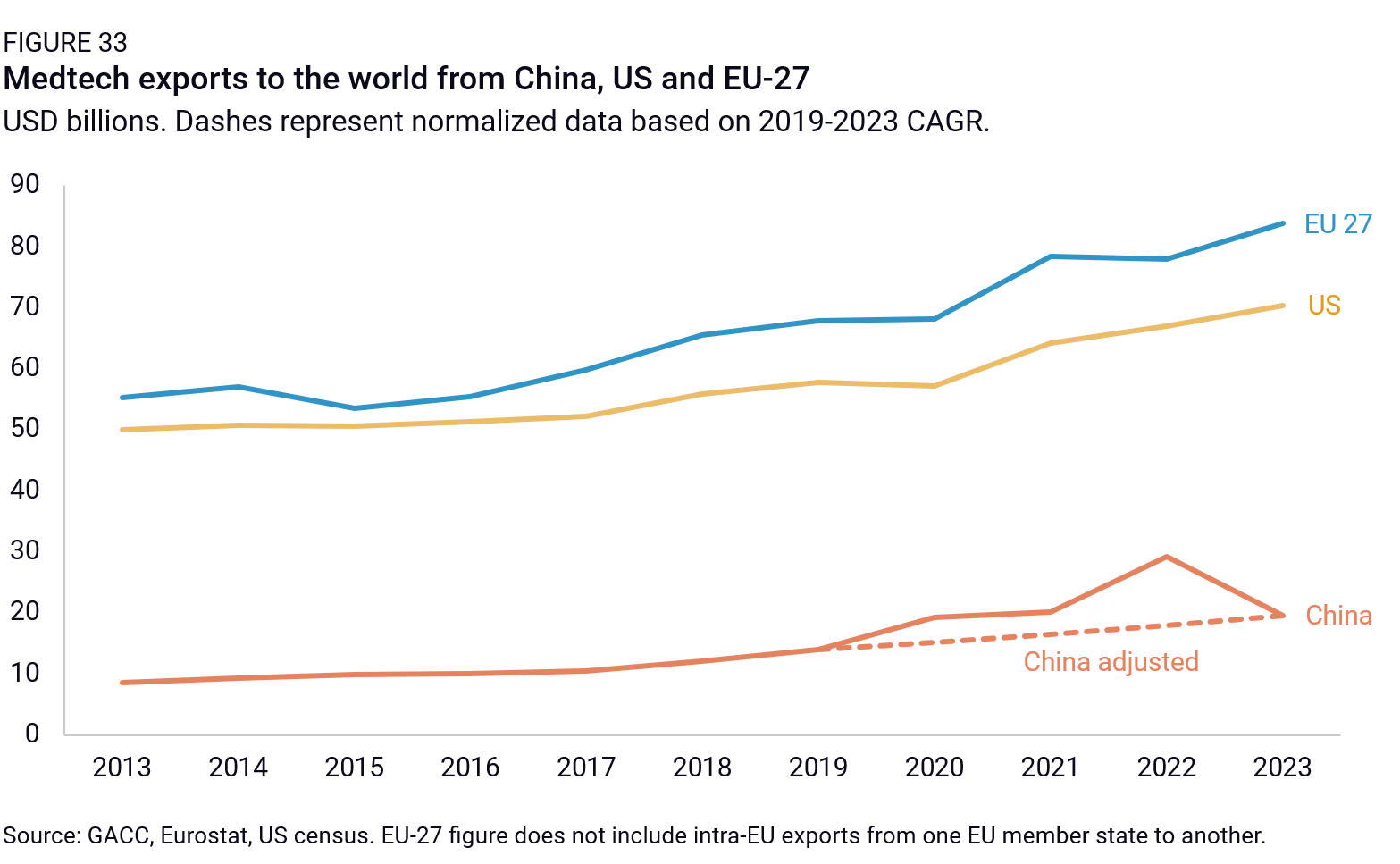
Like in the robotics sector, Chinese medical device companies still lag behind their peers in global revenues, though they have increased faster (Figure 34). Combined revenues from top Chinese manufacturers Lepu, Jiangsu Yuyue Medical Equipment, Mindray, Intco Medical, Microport, and Weigao more than doubled between 2017 and 2023. That said, their combined revenues only equaled 30% of US medical device maker Medtronic’s.
Nonetheless, US and EU medical device companies now face intensifying competition from emerging Chinese players, who have upgraded their technological capabilities and benefit from strong state financial support and discriminatory policies that restrict foreign access to the domestic market. This trajectory suggests that foreign firms will face growing headwinds as China continues to prioritize domestic champions and restrict foreign participation.
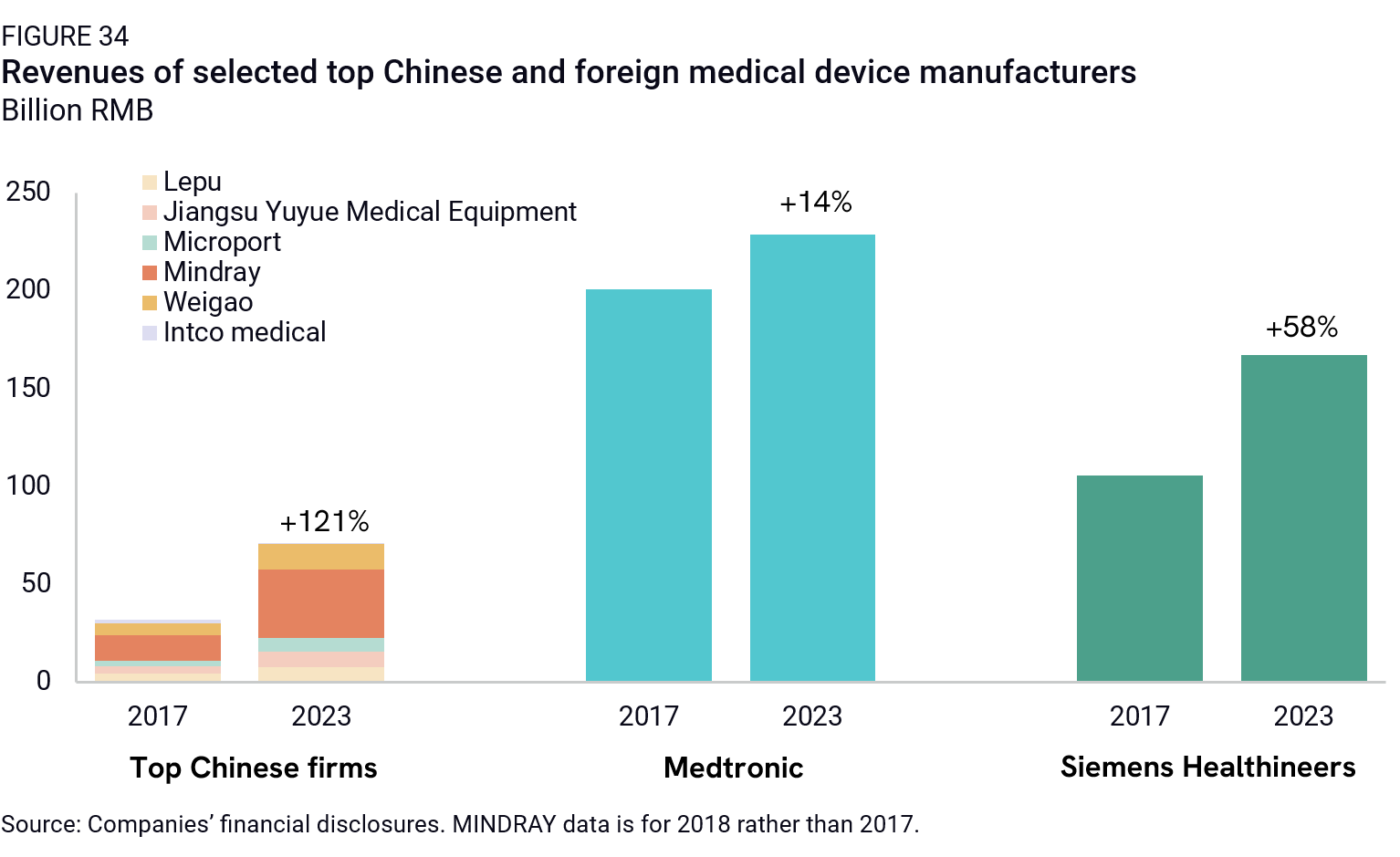
Technological competitiveness
China has made strides towards reducing its gap with foreign firms and the technological frontier. Overall, existing technological analyses show that China is harnessing huge momentum to close the gap with leaders like the US and Japan, and already pulling ahead by some innovation output indicators. In 2023, Chinese media widely reported that Chinese firms had already mastered 21 of the 35 key technologies listed as the main “bottleneck” technologies by Science and Technology Daily in 2018. These mastered technologies included, for example, underwater connectors, LiDAR, mobile phone RF devices, and the main bearings of tunnel boring machines.
These successes are evident in the patenting and publications data, which shows significant progress in all areas in China’s share of global PCT patents and the share of global high-impact research papers. Publication data analyzed by the Australian Strategic Policy Institute’s critical technology tracker looking at the proportion of 10% most cited research papers originating from institutions in various countries, shows that China is the leading research contributor in almost all covered sectors. Across the technologies examined in Figure 35 below, which overlap with sectors covered by the MIC25 strategy, China increased its share of global top publications on average by a whopping 18 percentage points between 2015 and 2023. In 9 out of 12 technologies surveyed, China holds more than 30% of global top publications (with the exception of the two medtech categories and biofuels).
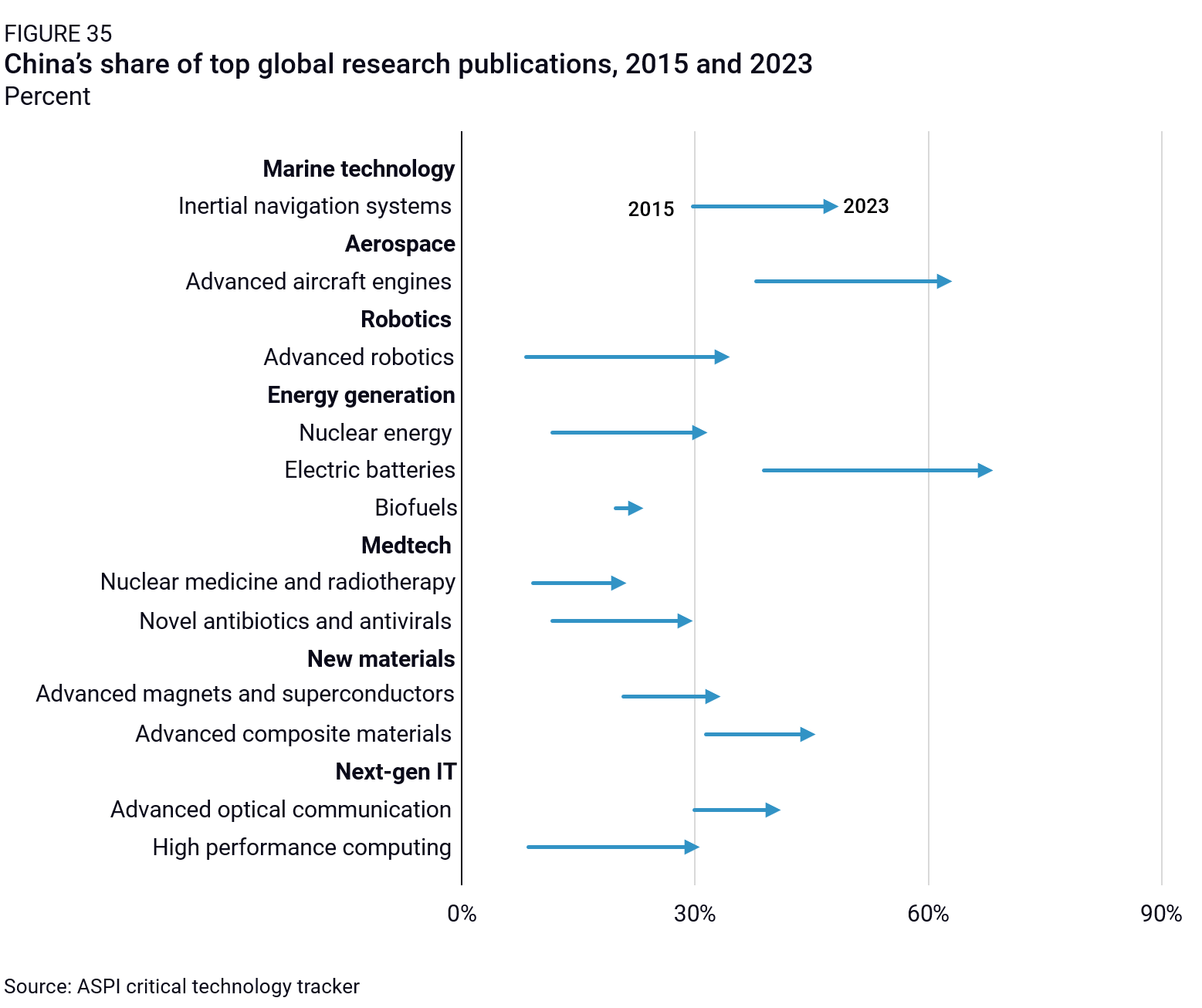
Patent data show similar momentum. Figure 36 shows China’s share of global PCT patents between 2015 and 2020—an early cut-off date required because patenting registration lags behind applications, biasing more recent data. According to our analysis, China’s share has increased in the majority of sectors, with a few sectors seeing increases of more than 4 percentage points (NEVs, new materials, electronics, and robotics). China’s share of global PCT patents in maritime engineering and agricultural machinery are the categories with the lowest sustained Chinese share of global PCT patents across MIC25 sectors.
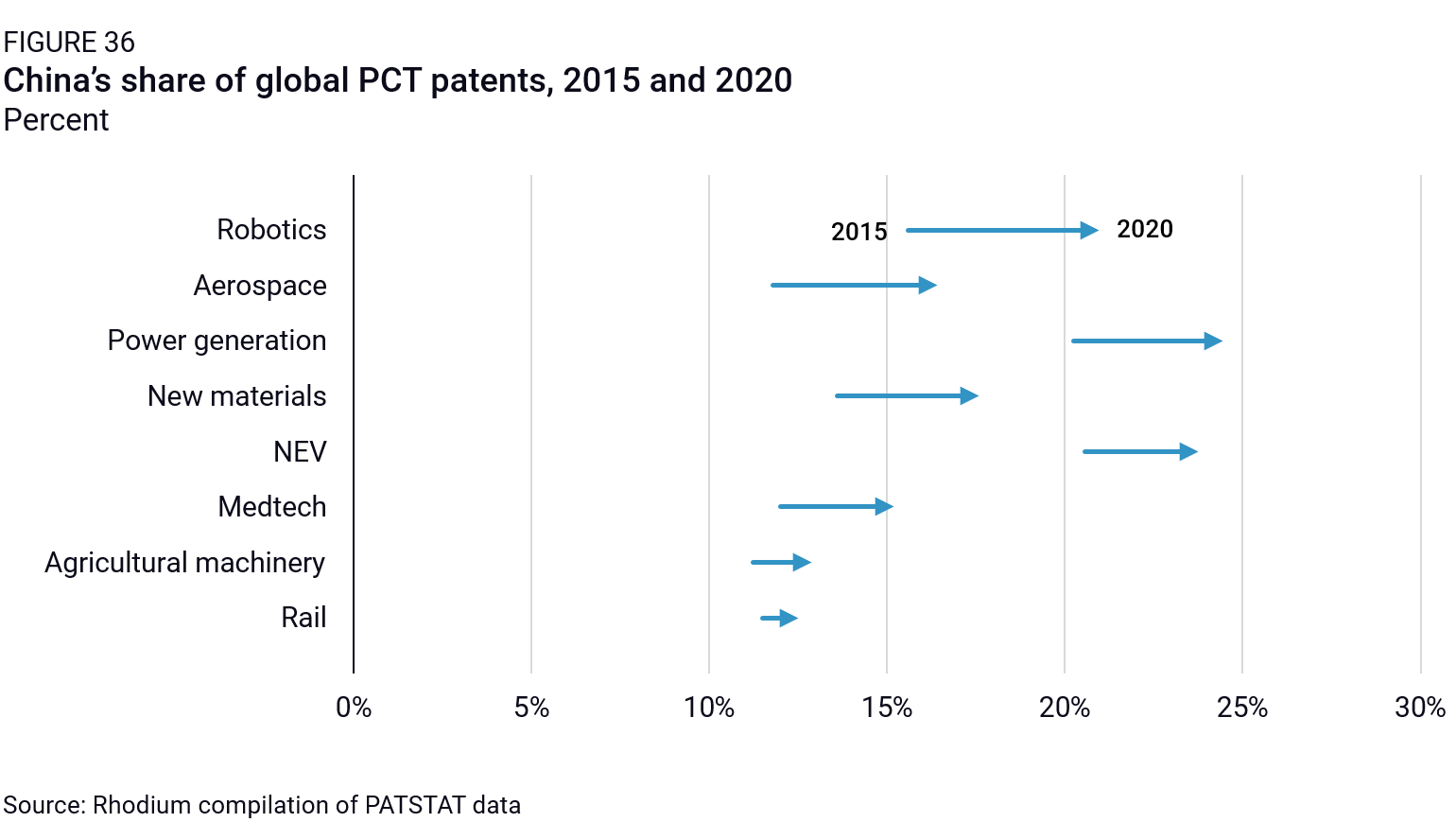
This positive picture is nuanced by other indicators, including R&D spending. Chinese companies’ R&D expenditure as a share of total R&D expenditures by the top global 2,500 R&D spenders have increased over the past decade but remains largely behind the US in aerospace, pharmaceuticals, tech hardware, electronics, and industrial engineering (Figure 37). Overall, the R&D intensity (a ratio of R&D expenditure to operating income) in 2022 was 1.39% for industrial enterprises and 1.55% for manufacturing firms, up from respectively 0.8% and 0.88% in 2013. This was still well below the US R&D intensity of 4.9% for all firms and 5.1% for manufacturers.
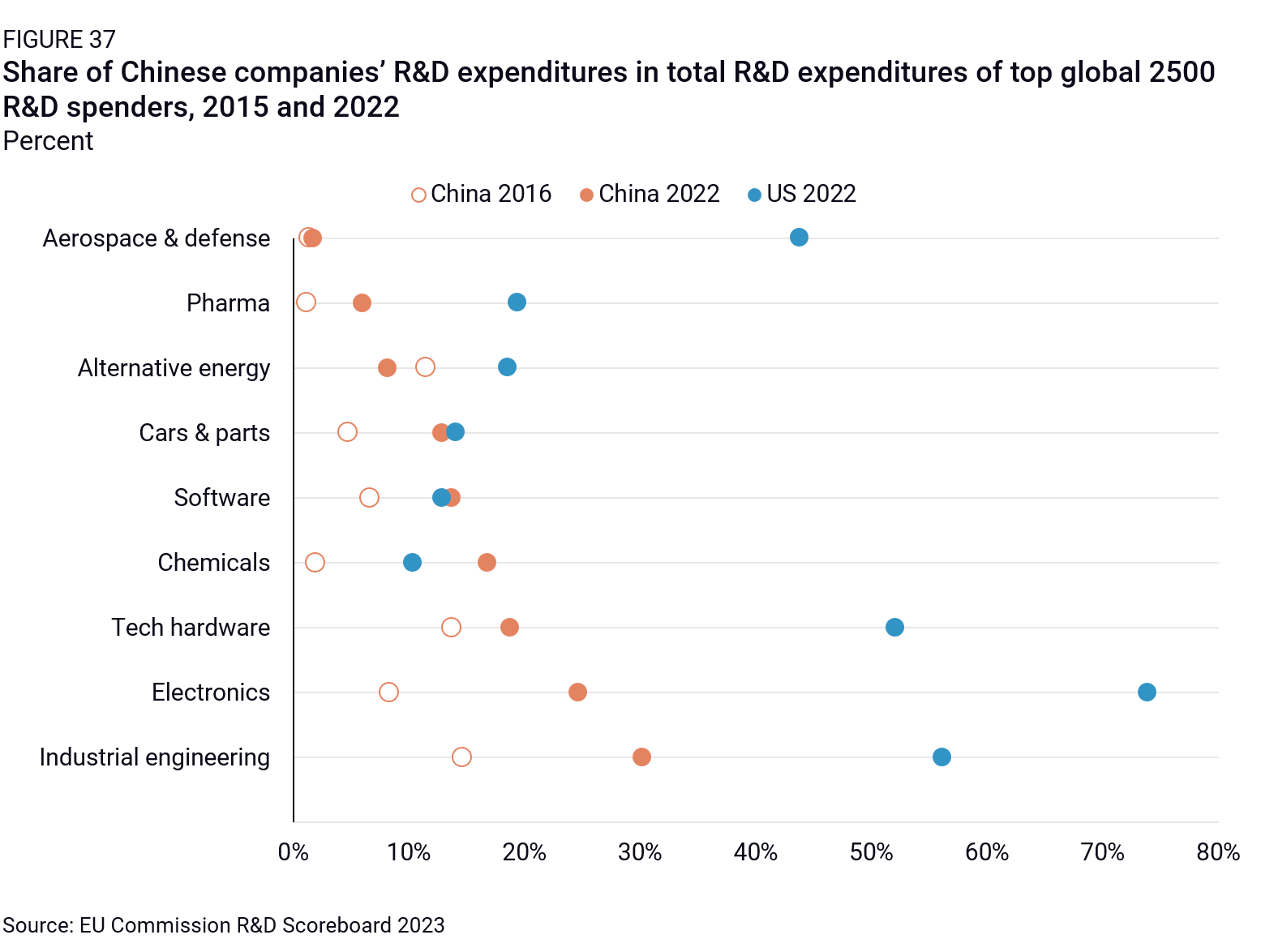
One reason for the divergence between research outcomes and corporate expenditure is that Chinese firms struggle to ramp up their basic research expenditures, which are crucial in allowing technological breakthroughs. Although enterprises are responsible for 91% of experimental research in China, they only account for 28 and 15% of China’s applied and basic research, respectively. As a result, while the share of basic R&D spending by Chinese enterprises has grown from 5% in 2013 to 15% in 2021, it remains much lower compared to other countries, such as the United States (33%) and Japan (47%).24 Notably, the share of basic and applied research conducted by Chinese enterprises is biased by research labs affiliated with SOEs, which act as quasi-public R&D institutes. For example, China Telecom, one of China’s largest SOEs, has several affiliated research institutes, including the Beijing Institute (advanced research in the communication field), the Shanghai Institute (software applied research), and the Guangzhou Institute (primarily hardware testing and major project research tasks).25 While the crucial role of SOEs may provides stable capital to support long-term innovation, it also limits the agility and market-driven focus of basic research in China.
Overall, total Chinese R&D spending as a share of GDP has grown steadily over the past decade, rising from 2.02% in 2014 to 2.68% in 2024. This progress has been driven by consistent growth in corporate spending—accounting for between 77% and 79% of total R&D investment during this period—and robust public funding. Companies themselves are largely financed through public or state-directed funding. Government-related sources play a dominant role in China, which according to Rhodium research accounts to around 60% of all financing flowing into the country’s S&T ecosystem. This highlights potential weaknesses: Although Beijing remains committed to emphasizing S&T expenditure in the years ahead, severe fiscal constraints will likely slow the growth of innovation funding and constrain the ability of Chinese firms to catch up with the technological frontier in key technologies in the future.
Another limitation of China’s progress is that while Chinese firms have been striving to catch up, foreign technology has continued to advance in many areas. In 2015, the most advanced semiconductor node in commercial production was 14nm, with 10nm technology still under development and not yet widely available. When surveyed about when they expected Chinese competitors to reach parity in their respective fields, 62% of foreign firms predicted it would happen within 5 to 10 years. Among the sectors covered, the automotive industry stood out as the one where Chinese competitors were perceived to have already caught up or were expected to do so the soonest (Figure 38). In integrated circuits, half of respondents indicated they expected their Chinese competitors to catch up in more than 10 years. This is consistent and complementary with the findings of the Information Technology and Innovation Foundation’s research on Chinese innovation progress, which finds that China lags in machine tools, semiconductors, biopharmaceuticals, and chemicals; and is near parity in robotics. This landscape is changing rapidly, however, and many of these gaps may not persist for long. For example, as noted above, China is rapidly establishing itself as an independent innovator in biopharmaceuticals.
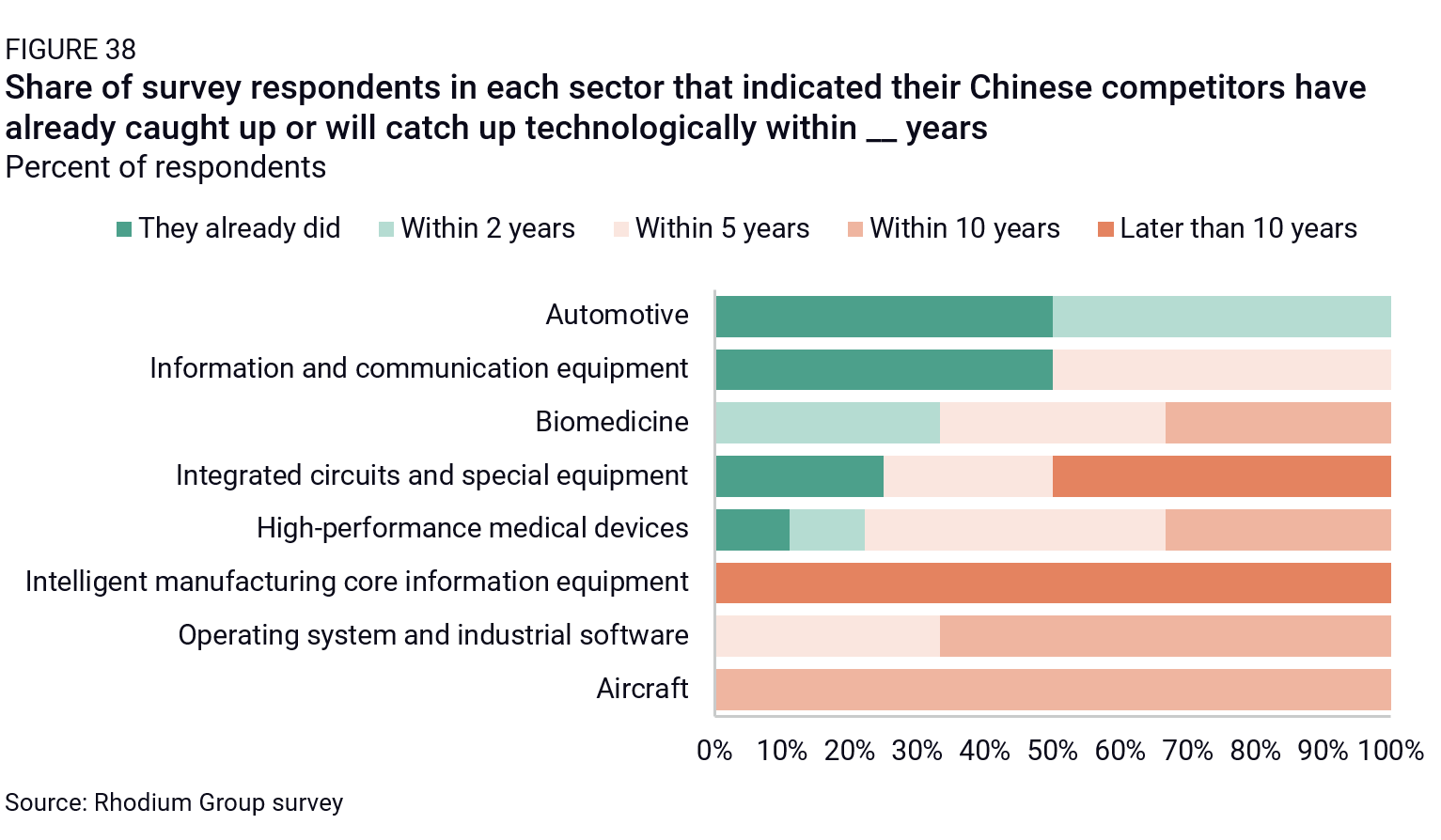
When asked the specific technologies where Chinese firms are lagging the most, firms pointed out the following areas:
- State-of-the-art jet engine technology and widebody aircraft manufacturing are projected to remain out of reach until at least 2030.
- In advanced semiconductors, including cutting-edge nodes like 5nm and advanced packaging technologies, participants were uncertain if China will ever fully close the gap, despite recent progress.
- In medical technologies, Chinese companies are behind in producing some core medical device components protected by intellectual property, with a timeline of 5-10 years to catch up.
- Key areas such as flow cytometry, microbiology lab automation, and high-throughput molecular automation are unlikely to see parity before 2030.
These gaps are consistent with findings from a recent EUCCC report, which found that aerospace, biopharmaceuticals, and high-performance medical devices had the highest share of foreign firms (7%) that reported none of their Chinese competitors are close to having the ability of producing goods that could substitute theirs.14
However, other less complex technologies like radiation therapy and some other medical devices may reach global standards within 2-5 years, and surgical robots are expected to follow within 5 years. High-value consumables and complex diagnostics are also expected to align with global leaders in the next 5 years.
That said, foreign governments and companies have increasingly limited visibility into China’s science and technology system and innovation trajectory. The shift toward emphasizing security over economic development—including through recent measures like the Counter-Espionage Law, State Secrets Law, and the classified structure of China’s S&T system—has made independent assessments of China’s technological progress far more difficult. Recent high-level policy planning documents such as the 2020-2035 Medium and Long-Term Plan for the Development of Science and Technology (MLP) were not released publicly, unlike their predecessors. The number of consulting firms evaluating China’s tech progress from within the country has declined significantly, creating greater uncertainty about its actual advancements. As a result, the potential for surprises in China’s scientific development is growing.
Conclusion
China has made clear and undeniable progress, particularly in reducing its import dependencies. This achievement has been partly driven by China’s carefully constructed and comprehensive regulatory and operational environment that compelled foreign firms to increasingly localize their production within China, thereby reducing their exports to the country. Foreign direct investment has proven critical in this process, enabling China to acquire advanced technologies while simultaneously fostering domestic production capabilities, bolstering the market share of indigenous firms in key sectors at the expense of foreign investors, and decreasing reliance on imports.
As a result, Chinese firms have become increasingly competitive, both domestically and globally. While their early strengths lay in low- and medium-tech industries, they are now making significant inroads into some high-tech sectors, with real success stories emerging. Technologies that posed major bottlenecks a decade ago, such as high-speed rail brakes and LiDAR, have been mastered, largely due to targeted industrial policies. Domestic companies’ market shares in high-tech industries are poised to grow, though the most specialized technologies—like cutting-edge semiconductors, aerospace components, and some advanced medical devices —remain beyond their reach for now.
China’s global achievements for now are concentrated in electric vehicles, renewable power generation, telecommunications, drones, and high-tech ships, where domestic firms have gained a competitive edge. The characteristics of these industries mattered: they are often characterized by high capital intensity (where state support and large-scale financing gave Chinese firms a competitive edge), a large domestic demand base (which provided opportunities for rapid scaling up), and emerging technologies without established global leaders (which enabled Chinese firms to leapfrog competitors).
Despite these advances, China remains far from achieving its intended self-sufficiency. Foreign firms continue to dominate in critical areas such as semiconductor manufacturing equipment, high-end instruments, and advanced aerospace components, with the most sophisticated intellectual property and technologies retained outside of China. This creates significant dependencies, particularly in sectors like machine tools, and cutting-edge semiconductors, where imports are still essential for the most advanced components. In most sectors, including high-end semiconductors, medical devices, and aerospace equipment, Chinese companies also lag in revenues, market share, and technological sophistication.
Of course, achieving complete self-sufficiency in advanced technologies is an ambitious standard that no industrialized country has ever met (and few have sought) in peacetime. Even during wartime, attempts at full autarky have come at enormous costs and ultimately ended in failure.26 In fact, the dependencies of the US, EU and other smaller economies on foreign firms and imports are in some respects just as acute as China’s, if not more.
The unprecedented scale and scope of Beijing’s industrial policies have undoubtedly played a significant role in these achievements. Beyond conventional tools such as direct grants and tax rebates, China’s highly politicized financial sector channels vast amounts of credit into strategic sectors with little regard for economic fundamentals. This politically driven deployment of financial resources creates effects akin to conventional subsidies, enabling Chinese companies to access cheap financing and operate under soft budget constraints. The access of foreign technology companies has unquestionably diminished in recent years, both as a result of formal policy measures and restrictions and as a response to the frequent exhortations for good patriots to buy from local businesses. These mechanisms have systematically tilted the market in favor of MIC25 sectors and domestic firms, allowing them to grow larger, faster, and invest more in innovation than they would under normal market conditions. For example, in the ocean engineering equipment and high-tech ships industry, higher-tech products such as marine monitoring system sensors achieved 70% localization by 2023, despite only beginning to scale up in 2021.
These achievements, however, came at the cost of an unprecedented surge in industrial funding, raising questions about its long-term sustainability. Beijing’s industrial policy ecosystem led to profound waste, as local governments piled in with duplicative and inefficient projects. Misallocation of funds is rife—from corruption in the National Integrated Circuit Industry Investment Fund to empty data centers, and from half-empty blockchain-focused science parks to overcapacity in green energy sectors. The constraints of sustaining such high and inefficient levels of funding are starting to appear, especially for local governments that are stuck with most of the bills and now face painful trade-offs.
Beijing’s industrial policies have also had unintended consequences, particularly on economic growth. Over the past decade, China’s total factor productivity growth has stagnated,27 and overall economic growth has slowed, as the government struggles to transition the economy to a more sustainable model. Prioritizing industrial policy over consumer-driven development has created structural domestic imbalances that are now constraining future economic growth. Additionally, China’s growing overcapacity in many industries has led to declining industrial profits and intensified price wars, hurting the ability of Chinese companies to invest in innovation and product development.
In recent years, China’s leadership has started to frame its push for technological innovation in the context of encouraging “new quality productive forces” that will boost overall productivity growth. But these sectors alone cannot compensate for weaknesses in other industries. More fundamentally, the only way for China’s economic growth to exceed growth in the rest of the world while pursuing an export-led development strategy would be to grab additional export market share, risking even more serious trade defenses in response. Beijing’s emphasis on industrial policy has also contributed to a stall in broader economic reforms, straining relations with key trading partners.
Despite these inefficiencies and the toll on growth, Beijing remains committed to an industrial policy strategy focused on self-sufficiency and security and growing dominance in global technology markets. This determination reflects a broader worldview in which economic efficiency and short-term growth are subordinated to long-term strategic goals. Xi Jinping’s vision emphasizes reducing dependence on foreign technologies, firmly aligning and harnessing the benefits of private advanced technology entrepreneurs to serve state objectives, achieving dominance in critical sectors domestically and then globally, and thereby strengthening China’s geopolitical position. This approach has been reinforced by rising geopolitical tensions, particularly with the United States, and a growing focus on economic securitization in areas such as supply chains, semiconductors, and critical materials.
The trajectory of future achievements remains uncertain. On one hand, Chinese companies are poised to benefit from the momentum generated by past industrial policies, which may enable them to achieve self-sufficiency and technological parity in several sectors within the next few years. This is particularly evident in sectors such as biotechnology, robotics, and some medical devices, where Chinese firms appear not only poised to catch up with global peers but also to potentially establish global dominance in the coming years. Many of the objectives outlined in MIC25 that have yet to materialize as of 2024 could still come to fruition before 2030.
In addition, the overlapping technological achievements across multiple sectors are likely to have a compounding effect, further amplifying China’s progress and influence within global supply chains. Strengths in foundational technologies like advanced materials, semiconductors, and artificial intelligence act as catalysts for advancements in downstream industries, including robotics, telecommunications, and new energy vehicles. In that context, the interconnected approach of China’s industrial policy has not only bolstered China’s industrial growth but may also position it to sustain and expand its competitiveness across a wide array of strategic sectors in the years ahead.
On the other hand, new challenges are emerging that threaten to disrupt this momentum. Increasing friction between China and its trading partners is exacerbating pressures on its innovation and industrial ecosystems. In sectors where China has sought to close the gap with established global leaders, its progress will likely be hindered by growing restrictions on investment and exports in sensitive industries. Meanwhile, in breakthrough technologies, China faces the added constraint of reduced international research cooperation, limiting its ability to leverage global expertise.
Complicating this further is the growing opacity surrounding China’s technological capabilities and vulnerabilities. Recent measures—such as the Counter-Espionage Law, stricter state secrets regulations, and efforts to obscure the structure of key institutions like the Science and Technology Commission—have made it increasingly difficult to assess China’s innovation funding and technological progress. This suggests that the world is likely to know less about China’s capabilities than in the past, increasing the risk of both unexpected advances—such as those observed in military technologies—and overestimations of its abilities in other areas. China’s rapidly growing competence in cyber operations also warrants close attention. These capabilities could fuel unforeseen advances, particularly in sensitive technologies where traditional avenues of development face growing restrictions. These concerns have also begun to limit the ability of Chinese firms to access international markets, as seen in recent security-driven regulations and legislation in key countries targeting Chinese products in sensitive sectors. As China’s security environment tightens, these dynamics will make it increasingly challenging for foreign companies to accurately benchmark their Chinese competitors, introducing new uncertainties into global markets.
Appendix A
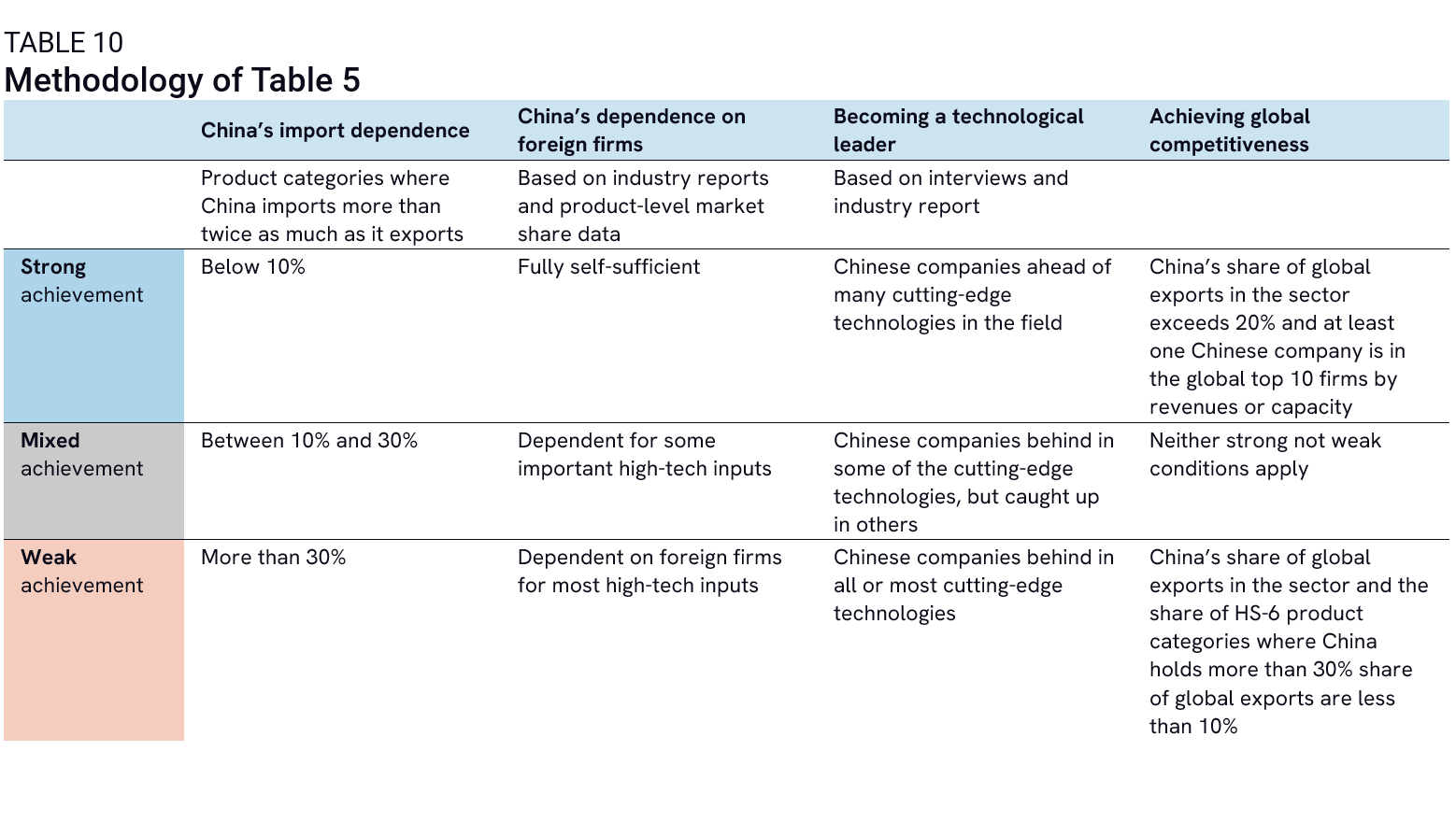
Appendix B
High-speed rail
One of China’s most significant achievements is high-speed rail. Paradoxically, the sector was not explicitly targeted in the Roadmap to increase the market share of Chinese firms . This may be because, back in 2015, it was not considered a major vulnerability, given its already well-established strength. While Bochumer Verein Verkehrstechnik (BVV), Construcciones y Auxiliar de Ferrocarriles (CAF), Schaeffler, and other foreign firms monopolized the market prior to 2017, domestic companies such as Taiyuan Heavy Industry, Ma’anshan Iron and Steel, and Chongqing Kairui have been able to produce domestic alternatives since then. The Fuxing high-speed car is 97% localized, relying only on certain ball bearings from Japanese parts makers such as NSK.28 Rail brakes and signaling follow similar trajectories to that of bogies. Prior to the Fuxing model, Knorr-Bremse had more than 70% of the market share for the Hexing train model. However, Chinese firms such as Tianyi Shangjia and Beijing Puran have developed brake pads and now hold 42% and 20% of the market, respectively. On the signaling side, MNCs including Siemens, Alstom, and Thales were the major players in the domestic market for years. Now, in high-speed railways with speeds above 300 kilometers per hour, China Railway Signal & Communication Corporation’s core equipment market share exceeds 90%, while in urban transit CRCS has a market share of 60%.
New materials
The MIC25 roadmap highlighted advanced materials as a strategic pillar for industrial modernization. This included three categories: advanced basic materials (such as advanced steel and petrochemicals), where China aimed for domestic firms to hold a 90% market share by 2025; critical strategic materials (such as new energy materials, electronic ceramics, and advanced semiconductor materials), with a target of 85% domestic market share; and cutting-edge materials (such as superconducting materials), where the roadmap did not specify any self-sufficiency targets.
Despite these ambitious targets, however, much of the focus over the past decade has concentrated on ensuring self-sufficiency in basic chemicals. There, Chinese firms have certainly made significant progress. China’s share of global incremental capacity growth in the three major basic petrochemicals (Ethylene, Propylene, and Paraxylene) increased from around 20% in 2017-2018 to close to 80% between 2021 and 2023. In only three years, between 2019 and 2022, China’s share of global toluene production increased by more than six percentage points in all key basic petrochemicals (ethylene, butadiene, propylene, benzene, and toluene). Domestic companies like Wanhua Chemical and Rongsheng Petrochemical have played important roles in those successes. In particular, the partly state-owned Wanhua Chemical has achieved rapid growth in high-value specialty chemicals.
Domestic firms have also made a few notable breakthroughs in some strategic materials. Domestic production of ternary cathode materials reached a 92% localization rate by 2021, with Chinese firms like Ningbo Rongbai and Dangsheng Materials ranking among the global top 10. In display technologies, Chinese firms were reported to have broken the dominance of Japanese and Korean players in OLED polarizers and ultra-thin flexible glass.29 Nonetheless, despite these achievements, the advanced materials sector still remain largely reliant on foreign suppliers. As of 2020, domestic companies were reported by Chinese sources to account only for 38% of the domestic market in carbon fibers, 20% for silicon carbide, and 23% for electroceramics. As of 2023, domestic firms were reported to account for only 10% of the domestic market in high-performance reverse osmosis membrane materials and 10% for semiconductor photoresist materials.2
Footnotes
Barry Naughton, The Rise of China’s Industrial Policy, 1978 to 2020, Universidad Nacional Autónomica de México, Facultad de Economía, 2021.
Ibid.
Margaret Pearson et al., “Party-State Capitalism in China,” Current History 120: 827 (September 2021): 207–213 https://online.ucpress.edu/currenthistory/article/120/827/207/118341/Party-State-Capitalism-in-China.
Agatha Kratz, “Exporting ‘Harmony and Rejuvenation’: Explaining the Surprising Track Record of China’s Global High-speed Rail Expansion,” PhD diss. Lau China Institute King’s College London, 2018.
Based on China Customs trade data
NBS data
Barry Naughton, The Rise of China’s Industrial Policy, 1978 to 2020, Universidad Nacional Autónomica de México, Facultad de Economía, 2021. Cited in Peter Bofinger et al,. “Credit as an Instrument for Growth: A Monetary Explanation of the Chinese Growth Story,” Hans-Böckler-Stiftung, July 2023, https://www.boeckler.de/data/downloads/IMK/FMM%20Konferenz%202023/v_2023_10_20_bofinger.pdf.
World bank data
According to China Association of Automobile Manufacturers
Summarized US Chamber of Commerce, “Made in China 2025: Global Ambitions Built on Local Protections,” 2017, https://www.uschamber.com/assets/archived/images/final_made_in_china_2025_report_full.pdf. and Jost Wübbeke et al., “Made in China 2025 The making of a high-tech superpower and consequences for industrial countries” Mercator Institute for China Studies, December 2016, https://merics.org/sites/default/files/2020-04/Made%20in%20China%202025.pdf.
For details see PBOC and other ministries, “Several Opinions on Finance to Support Industry Stable Growth, Restructuring, and Improving Profit [关于金融支持工业稳增长调结构增效益的若干意见],” February 16, 2016, http://www.gov.cn/xinwen/2016-02/16/content_5041671.htm, cited in US Chamber of Commerce, “Made in China 2025: Global Ambitions Built on Local Protections,” 2017, https://www.uschamber.com/assets/archived/images/final_made_in_china_2025_report_full.pdf
Lee Branstetter and Li Guangwei, “Does Made in China 2025 Work for China? Evidence from Chinese Listed Firms,” National Bureau of Economic Research, November 2022, https://www.nber.org/system/files/working_papers/w30676/w30676.pdf.
In 2023-2024, faced with a decline in foreign investment in China, some local governments issued a series of policies assuring that foreign-invested firms would be able to enjoy incentives such as the “first-purchase” measures, which grants procurement advantages to domestic products. In December 2024, the Ministry of Finance issued “Circular on Matters Concerning Standards for Domestic Products in Government Procurement and Implementation Policies (Draft for Comment),” a draft policy granting advantages to products made in China, regardless of the firms’ ownership. However, over the past years, local governments have tended to include “Buy China” clauses in their procurement guidelines, creating uncertainty for foreign companies. Official guidance has often targeted innovative products made by domestic companies, including the “Administrative Measures for the First Government Purchase and Ordering of Independent Innovation Products” (2007), the “Administrative Measures for Government Procurement of Imported Products” (2007), and the “Opinions on Promoting the Demonstration and Application of the First Major Technological Equipment” (2018).
EU Chamber of Commerce in China, Made in China 2025: The Cost of Technological Leadership, 16 April 2025.
Interviews conducted for this study
Rhodium analysis of SEMI Fab Watch data
HS codes, or Harmonized System codes, are an internationally standardized system for classifying traded goods. They consist of six-digit codes that identify specific product categories, allowing for detailed analysis of trade flows
Industrial enterprises are defined as all state-owned industrial enterprises and the non-state-owned industrial enterprises with revenue from principal business over 5 million yuan from 1998 to 2006; all industrial enterprises with revenue from principal business over 5 million yuan from 2007 to 2010; and all industrial enterprises with revenue from principal business above 20 million yuan since 2011. It only includes firms in the mining and manufacturing sectors.
See the conclusions of the EU Commission investigation under the International Procurement Instrument concerning measures and practices of the People’s Republic of China in the public procurement market for medical devices, which details many of these policies in the medical device area.
China’s Ministry of Commerce, “Standard Conditions of Automobile Traction Battery Industry,” March 24, 2015. http://www.mofcom.gov.cn/article/b/g/201505/20150500987728.shtml.
Cited in National Security Commission on Emerging Biotechnology, “National Security Commission on Emerging Biotechnology Urges Swift Action to Protect U.S. National Security,” April 8, 2025, https://www.biotech.senate.gov/press-releases/nsceb-publishes-final-report/.
Riitta Katila, “Using Patent Data to Measure Innovation Performance,” International Journal of Business Performance Measurement, 2000, https://web.stanford.edu/~rkatila/new/pdf/KatilaUsingpatentdata.pdf.
KUKA has the distinction of being a German firm that is now owned by the Chinese firm Midea. Midea acquired the German robotmaker through its subsidiary Mecca International (BVI) Ltd. in 2016. Prior to the acquisition, Midea was already involved in the industrial automation industry more broadly as well as robot manufacturing under its own brand.
OECD data.
Xueshulunwenwang, “Research on the Transformation Mechanism of Scientific and Technological Achievements of State-Owned Scientific Research Institutions under the Intellectual Property System Professional Graduate [知识产权体系下国有科研机构科 技成果转化机制研究],” August 2, 2023, https://www.xueshulunwenwang.com/guanlilei/xingzhengguanli/3290.html.
Mollema, Rijk Eric. “The Nazi Economy (1933–1939): Unemployment, Autarky and the Working-Class.” the ascendant historian 4.1 (2017): 64-74.
Deng Yangyang, Li Xiaohua, and Ye Aishan, “Research on Total Factor Productivity in China’s Economic Growth Since the Reform and opening-up,” EAI, June 07, 2024, https://eudl.eu/doi/10.4108/eai.29-3-2024.2347395.
Chan, Francis et al., “Made in China 2025 Industrial Master Plan Advances at Home, Faces Obstacles Abroad,” Bloomberg Intelligence, October 30, 2024.
Yao Hailin, Zhu Meiling and Tan Shuyao, “Current status, bottlenecks and countermeasures of domestic substitution of key strategic materials in China [中国关键战略材料国产化替代现状、制约瓶颈及对策],” Central South University School of Business, 2023, https://dazhi-1255704882.cos.ap-shanghai.myqcloud.com/uploads/20240407/6b58c565ee352de27cc7c3dda32e60c1.pdf.
